

Case Studies: Successful Teams Built on Strong Communication
Effective communication is the cornerstone of any successful team. Whether it’s a sports team, a corporate department, or a non-profit organization, the ability to convey ideas, collaborate, and resolve conflicts is crucial for achieving shared goals. In this blog post, we will dive into real-world case studies to explore how strong communication played a pivotal role in the success of various teams with these team communication success stories.

Case Study 1: The Apollo 13 Mission
In 1970, the Apollo 13 mission to the moon faced a life-threatening crisis when an oxygen tank exploded . NASA’s ground control and the astronauts onboard had to collaborate flawlessly to bring the crew safely back to Earth. Communication was the key to their survival.
- Clear and Calm Communication : Astronauts Jim Lovell, Fred Haise, and Jack Swigert communicated calmly and precisely with mission control, relaying vital information about their situation.
- Problem Solving Through Dialogue: The teams on Earth and in space worked together to devise ingenious solutions to the spacecraft’s problems, all thanks to open and effective communication.
The result? Against all odds, Apollo 13 safely returned to Earth, showcasing the power of clear communication under pressure.
Case Study 2: Pixar Animation Studios
Pixar Animation Studios is renowned for producing some of the most beloved animated films of our time. Behind every successful Pixar movie is a team of creative minds who prioritize communication.
- Cross-Functional Collaboration: Teams at Pixar consist of artists, storytellers, and technical experts. Regular meetings and open dialogues ensure that everyone’s ideas are heard and integrated into the final product.
- Feedback Culture: Pixar fosters a culture of giving and receiving feedback constructively. This communication style leads to continuous improvement and groundbreaking animation.
Pixar’s commitment to communication has resulted in numerous Academy Awards and timeless classics like “Toy Story” and “Finding Nemo.”
Case Study 3: The Chicago Bulls of the 1990s
The Chicago Bulls dominated the NBA in the 1990s, largely due to the exceptional communication and teamwork led by Michael Jordan and coach Phil Jackson.
- Trust and Cohesion: Jordan and his teammates trusted each other implicitly. This trust was built through open communication, both on and off the court.
- Effective Leadership: Coach Phil Jackson emphasized a collaborative team-first approach, fostering unity and communication among players.
The result? Six NBA championships in eight years, solidifying the Bulls’ place in sports history.
Conclusion – Team Communication Success Stories
These case studies highlight the undeniable connection between strong communication and team success. Whether it’s navigating a space crisis, creating blockbuster animations, or dominating the basketball court, effective communication is the driving force behind achieving remarkable feats as a team.
To achieve similar success in your own endeavors, remember the lessons from these case studies: communicate clearly, collaborate openly, and trust your team members . By doing so, you’ll be well on your way to building a team that can overcome any challenge and achieve greatness.
Communication isn’t just a skill; it’s a superpower that can turn ordinary teams into extraordinary ones.
Thank you for reading, and stay tuned for more insights on effective communication and teamwork!
Leave a Reply Cancel reply
Your email address will not be published. Required fields are marked *
Save my name, email, and website in this browser for the next time I comment.

- 1-800-565-8735
- [email protected]
16 Team Building Case Studies and Training Case Studies
From corporate groups to remote employees and everything in between, the key to a strong business is creating a close-knit team. in this comprehensive case study, we look at how real-world organizations benefited from team building, training, and coaching programs tailored to their exact needs. .
Updated: December 21, 2021
We’re big believers in the benefits of team building , training and development , and coaching and consulting programs. That’s why our passion for helping teams achieve their goals is at the core of everything we do.
At Outback Team Building & Training, our brand promis e is to be recommended , flexible, and fast. Because we understand that when it comes to building a stronger and more close-knit team, there’s no one-size-fits-all formula. Each of our customers have a unique set of challenges, goals, and definitions of success.
And they look to us to support them in three key ways: making their lives easy by taking on the complexities of organizing a team building or training event; acting fast so that they can get their event planned and refocus on all the other tasks they have on their plates, and giving them the confidence that they’ll get an event their team will benefit from – and enjoy.
In this definitive team building case study , we’ll do a deep dive into real-world solutions we provided for our customers.
4 Unique Team Building Events & Training Programs Custom-Tailored for Customer Needs
1. a custom charity event for the bill & melinda gates foundation , 2. how principia built a stronger company culture even with its remote employees working hundreds of miles apart , 3. custom change management program for the royal canadian mint, 4. greenfield global uses express team building to boost morale and camaraderie during a challenging project, 5 virtual team building activities to help remote teams reconnect, 1. how myzone used virtual team building to boost employee morale during covid-19, 2. americorps equips 90 temporary staff members for success with midyear virtual group training sessions, 3. how microsoft’s azure team used virtual team building to lift spirits during the covid-19 pandemic, 4. helping the indiana cpa society host a virtual team building activity that even the most “zoom fatigued” guests would love, 5. stemcell brightens up the holiday season for its cross-departmental team with a virtually-hosted team building activity, 3 momentum-driving events for legacy customers, 1. how a satellite employee “garnered the reputation” as her team’s pro event planner, 2. why plentyoffish continues to choose ‘the amazing race’ for their company retreat, 3. how team building helped microsoft employees donate a truckload of food, 4 successful activities executed on extremely tight timelines, 1. finding a last-minute activity over a holiday, 2. from inquiry to custom call in under 30 minutes, 3. a perfect group activity organized in one business day, 4. delivering team building for charity in under one week.
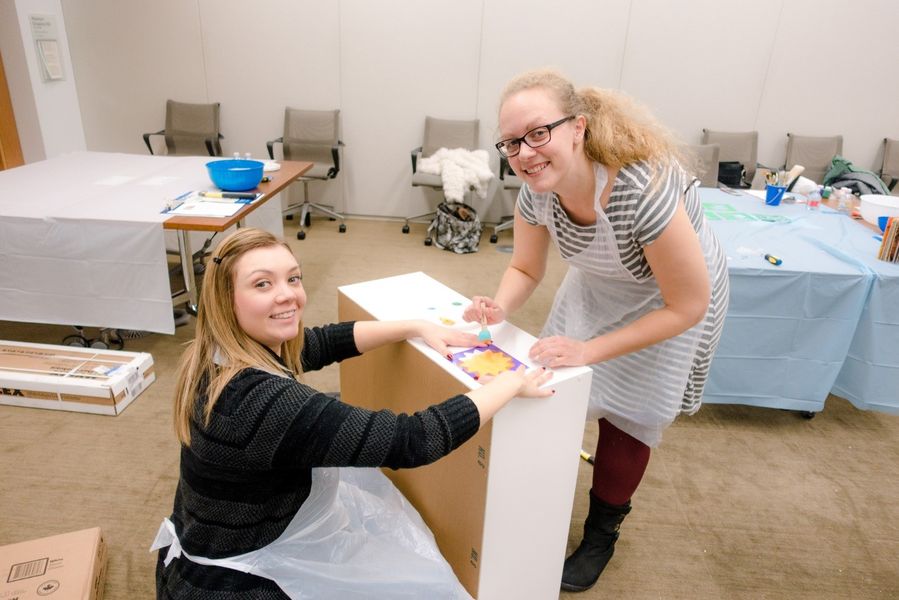
We know that every team has different needs and goals which is why we are adept at being flexible and have mastered the craft of creating custom events for any specifications.
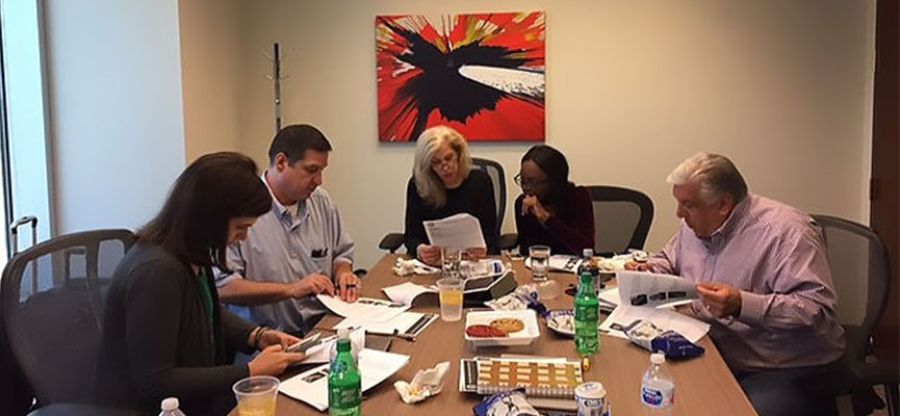
When the Seattle, Washington -based head office of the Bill & Melinda Gates Foundation – a world-renowned philanthropic organization – approached us in search of a unique charity event, we knew we needed to deliver something epic. Understanding that their team had effectively done it all when it comes to charity events, it was important for them to be able to get together as a team and give back in new ways .
Our team decided the best way to do this was to create a brand-new event for the Bill & Melinda Gates Foundation which had never been executed before. We created an entirely new charitable event – Bookworm Builders – for them and their team loved it! It allowed them to give back to their community, collaborate, get creative, and work together for a common goal. Bookworm Builders has since gone on to become a staple activity for tons of other Outback Team Building & Training customers!
To learn more about how it all came together, read the case study: A Custom Charity Event for the Bill & Melinda Gates Foundation .
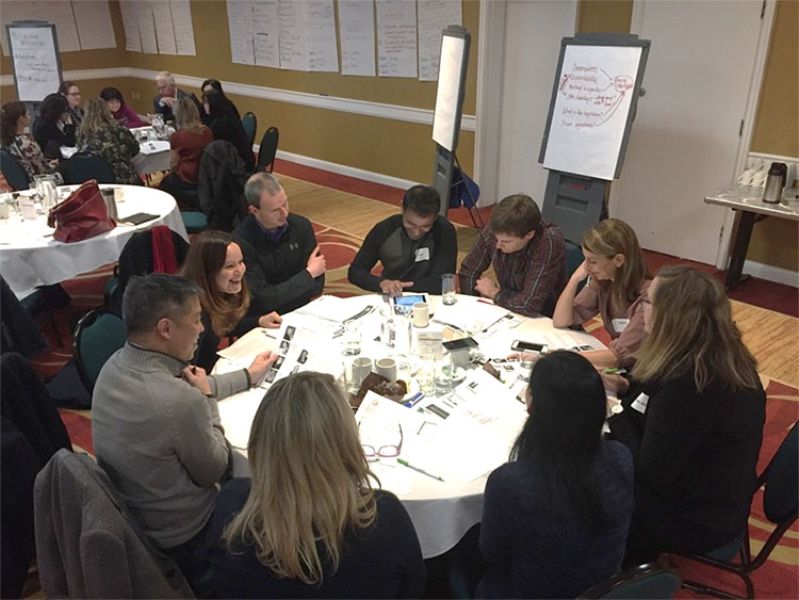
Who said hosting an impactful training program means having your full team in the same place at the same time? Principia refused to let distance prevent them from having a great team, so they contacted us to help them find a solution. Their goals were to find better ways of working together and to create a closer-knit company culture among their 20 employees and contractors living in various parts of the country.
We worked with Principia to host an Emotional Intelligence skill development training event customized to work perfectly for their remote team. The result was a massive positive impact for the company. They found they experienced improved employee alignment with a focus on company culture, as well as more emotionally aware and positive day-to-day interactions. In fact, the team made a 100% unanimous decision to bring back Outback for additional training sessions.
To learn more about this unique situation, read the full case study: How Principia Built a Stronger Company Culture Even with its Remote Employees Working Hundreds of Miles Apart .
We know that employee training that is tailored to your organization can make the difference between an effective program and a waste of company time. That’s why our team jumped at the opportunity to facilitate a series of custom development sessions to help the Royal Canadian Mint discover the tools they needed to manage a large change within their organization.
We hosted three custom sessions to help the organization recognize the changes that needed to be made, gain the necessary skills to effectively manage the change, and define a strategy to implement the change:
- Session One: The first session was held in November and focused on preparing over 65 employees for change within the company.
- Session Two: In December, the Mint’s leadership team participated in a program that provided the skills and mindset required to lead employees through change.
- Session Three: The final session in February provided another group of 65 employees with guidance on how to implement the change.
To learn more, read the full case study: Custom Change Management Program for the Royal Canadian Mint .
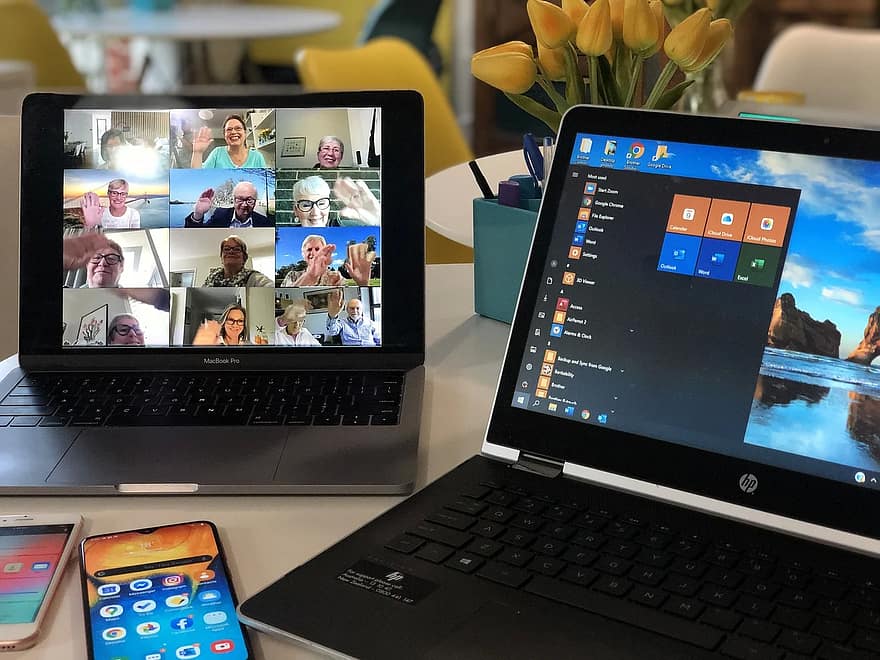
When Greenfield Global gathered a team of its A-Players to undertake a massive, challenging project, they knew it was important to build rapports among colleagues, encourage collaboration, and have some fun together.
So, we helped them host an Express Clue Murder Mystery event where their team used their unique individual strengths and problem-solving approaches in order to collaboratively solve challenges.
To learn more, read the full case study: Greenfield Global Uses Express Team Building to Boost Morale and Camaraderie During a Challenging Project .
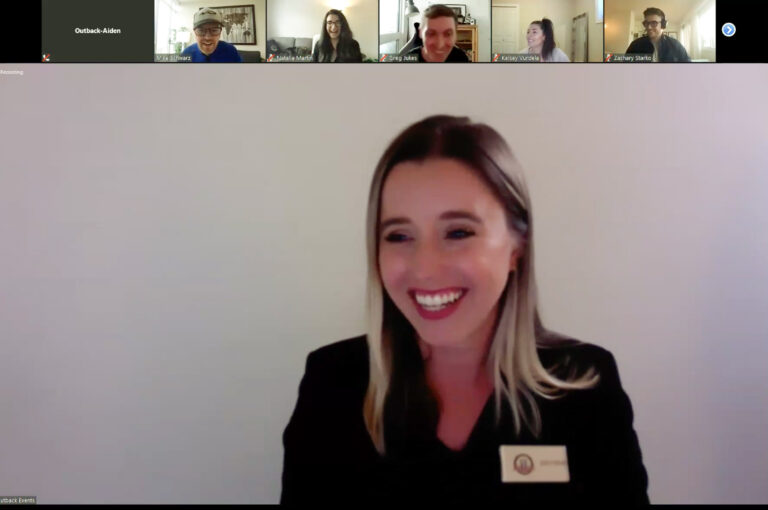
When the COVID-19 pandemic struck, we were proud to be able to continue supporting our customers’ goals with virtual team building activities and group training sessions.

With remote work being mandated as self-quarantine requirements are enforced on a global scale, companies began seeking ways to keep their newly-remote teams engaged and ensure morale remained as high as possible.
And MyZone was no exception. When the company found themselves feeling the effects of low employee morale and engagement, they noticed a decrease in productivity and motivation.
To make matters even more difficult, MyZone’s team works remotely with employees all over the world. This physical distancing makes it challenging for them to build a strong rapport, reinforce team dynamics, and boost morale and engagement.
The company was actively searching for an activity to help bring their employees closer together during this challenging time but kept running into a consistent issue: the majority of the team building activities they could find were meant to be done in person.
They reached out to Outback Team Building and Training and we were able to help them achieve their goals with a Virtual Clue Murder Mystery team building activity.
To learn more, read the case study here: How MyZone Used Virtual Team Building to Boost Employee Morale During COVID-19.
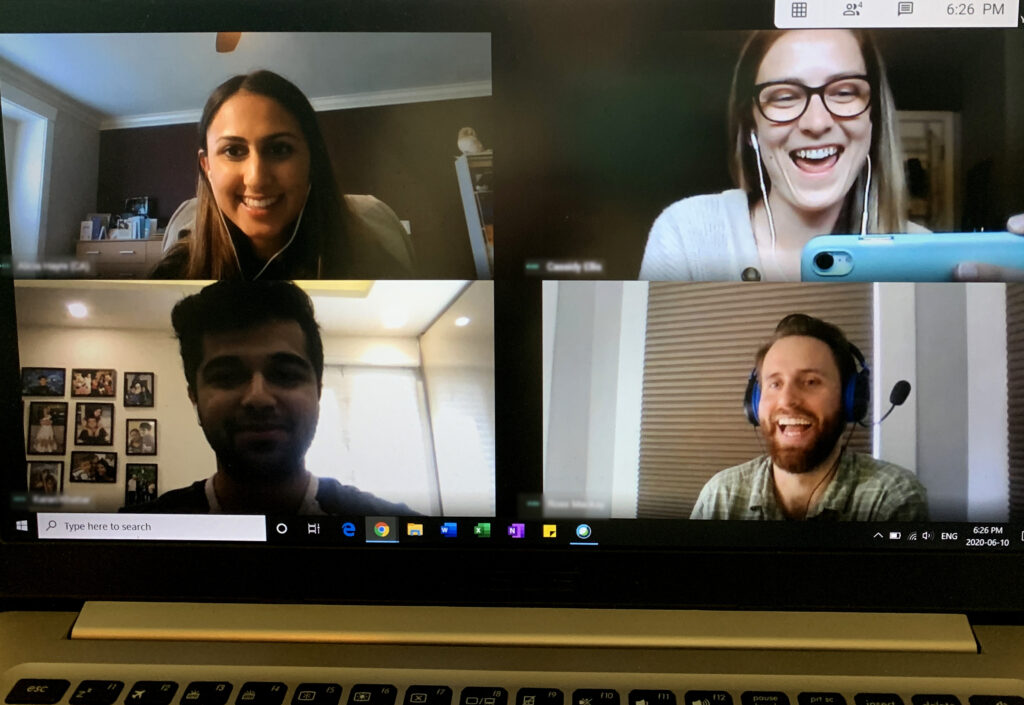
AmeriCorps members are dedicated to relieving the suffering of those who have been impacted by natural disasters. And to do so, they rely on the support of a team of temporary staff members who work one-year terms with the organization. These staff focus on disseminating emergency preparedness information and even providing immediate assistance to victims of a disaster.
During its annual midyear training period, AmeriCorps gathers its entire team of temporary staff for a week of professional development seminars aimed at both helping them during their term with the company as well as equipping them with skills they can use when they leave AmeriCorps.
But when the COVID-19 pandemic got underway, AmeriCorps was forced to quickly re-evaluate the feasibility of its midyear training sessions.
That’s when they reached out to Outback. Rather than having to cancel their midyear training entirely, we were able to help them achieve their desired results with four virtual group training sessions: Clear Communication , Performance Management Fundamentals , Emotional Intelligence , and Practical Time Management .
Find all the details in the full case study: AmeriCorps Equips 90 Temporary Staff Members for Success with Midyear Virtual Training Sessions.

With the COVID-19 pandemic taking a significant toll on the morale of its employees, Microsoft’s Azure team knew they were overdue for an uplifting event.
It was critical for their team building event to help staff reconnect and reengage with one another. But since the team was working remotely, the activity needed to be hosted virtually and still be fun, engaging, and light-hearted.
When they reached out to Outback Team Building and Training, we discussed the team’s goals and quickly identified a Virtual Clue Murder Mystery as the perfect activity to help their team get together online and have some fun together.
For more information, check out the entire case study: How Microsoft’s Azure Team Used Virtual Team Building to Lift Spirits During the COVID-19 Pandemic.

The Indiana CPA Society is the go-to resource for the state’s certified public accountants. The organization supports CPAs with everything from continuing education to networking events and even advocacy or potential legislation issues that could affect them.
But as the time approached for one of INCPAS’ annual Thanksgiving event, the Indiana CPA Society’s Social Committee needed to plan a modified, pandemic-friendly event for a group of people who were burnt out my online meetings and experiencing Zoom fatigue.
So, we helped the team with a Self-Hosted Virtual Code Break team building activity that INCPAS staff loved so much, the organization decided to host a second event for its Young Pros and volunteers.
For INCPAS’ Social Committee, the pressure to put on an event that everyone will enjoy is something that’s always on their mind when planning out activities. And their event lived up to their hopes.
For more information, check out the entire case study: Helping the Indiana CPA Society Host a Virtual Team Building Activity That Even the Most “Zoom Fatigued” Guests Would Love .

When Stemcell was looking for a way to celebrate the holidays, lift its team members’ spirits, and help connect cross-departmental teams during the pandemic, they contacted us to help host the perfect team building activity.
They tasked us with finding an event that would help team members connect, get in the holiday spirit, and learn more about the business from one another during the midst of a stressful and challenging time.
So, we helped them host a festive, virtually-hosted Holiday Hijinks team building activity for employees from across the company.
For more information, check out the entire case study: Stemcell Brightens Up the Holiday Season for its Cross-Departmental Team with a Virtually-Hosted Team Building Activity .
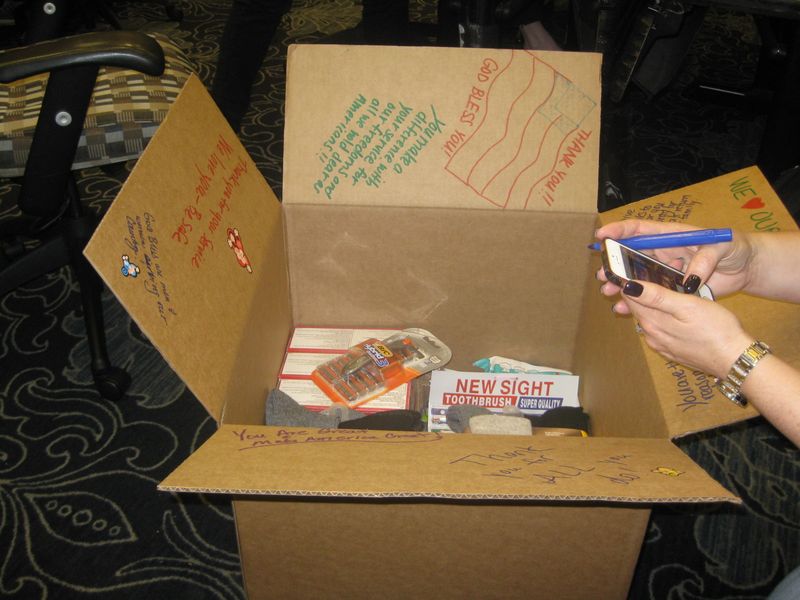
We take pride in being recommended by more than 14,000 corporate groups because it means that we’ve earned their trust through delivering impactful results.
We’ve been in this business for a long time, and we know that not everybody who’s planning a corporate event is a professional event planner. But no matter if it’s their first time planning an event or their tenth, we love to help make our customers look good in front of their team. And when an employee at Satellite Healthcare was tasked with planning a team building event for 15 of her colleagues, she reached out to us – and we set out to do just that!
Our customer needed a collaborative activity that would help a diverse group of participants get to know each other, take her little to no time to plan, and would resonate with the entire group.
With that in mind, we helped her facilitate a Military Support Mission . The event was a huge success and her colleagues loved it. In fact, she has now garnered a reputation as the team member who knows how to put together an awesome team building event.
To learn more, read the case study here: How a Satellite Employee “Garnered the Reputation” as Her Team’s Pro Event Planner .
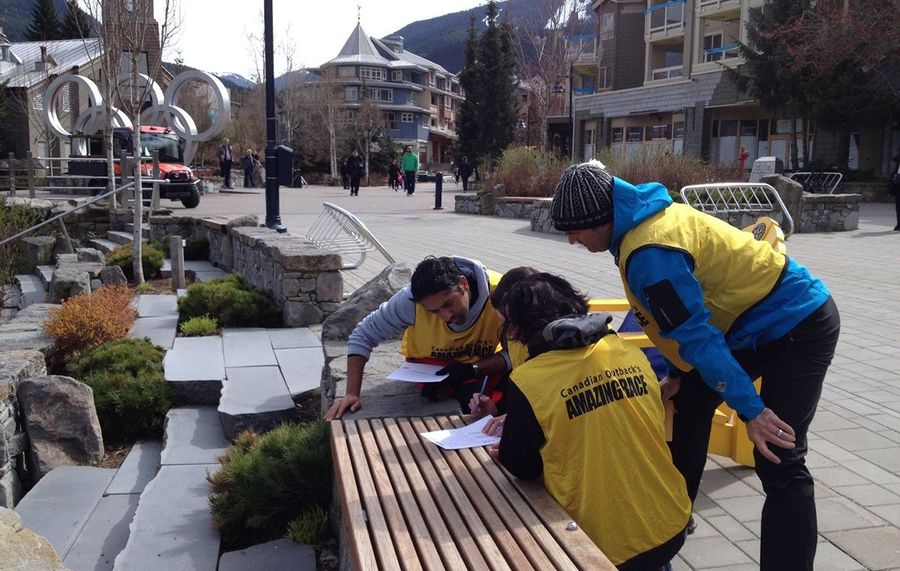
In 2013, international dating service POF (formerly known as PlentyOfFish) reached out to us in search of an exciting outdoor team building activity that they could easily put to work at their annual retreat in Whistler, B.C . An innovative and creative company, they were in search of an activity that could help their 60 staff get to know each other better. They also wanted the event to be hosted so that they could sit back and enjoy the fun.
The solution? We helped them host their first-ever Amazing Race team building event.
Our event was so successful that POF has now hosted The Amazing Race at their annual retreat for five consecutive years .
To learn more, check out our full case study: Why PlentyOfFish Continues to Choose ‘The Amazing Race’ for Their Company Retreat .
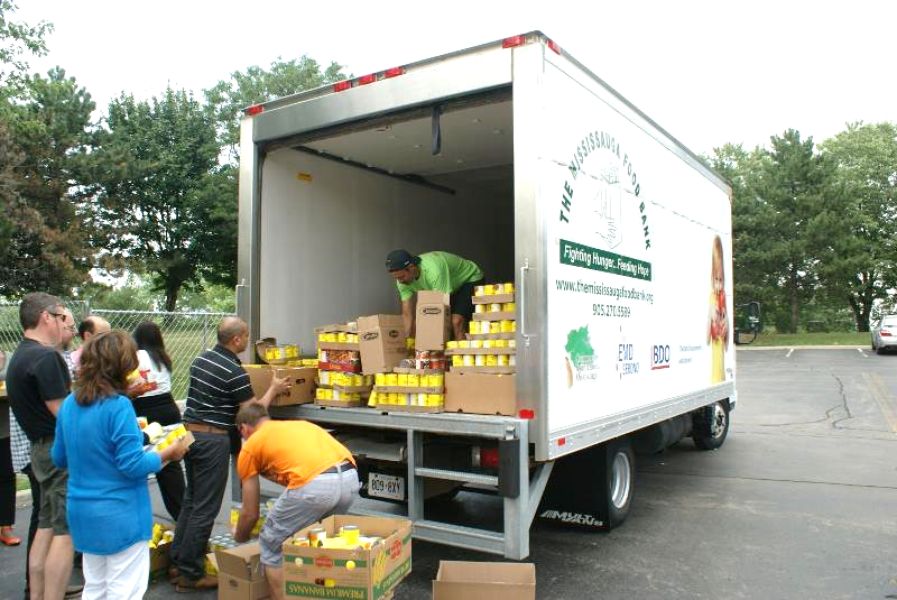
As one of our longest-standing and most frequent collaborators, we know that Microsoft is always in search of new and innovative ways to bring their teams closer together. With a well-known reputation for being avid advocates of corporate social responsibility, Microsoft challenged us with putting together a charitable team building activity that would help their team bond outside the office and would be equal parts fun, interactive, and philanthropic.
We analyzed which of our six charitable team building activities would be the best fit for their needs, and we landed on the perfect one: End-Hunger Games. In this event, the Microsoft team broke out into small groups, tackled challenges like relay races and target practice, and earned points in the form of non-perishable food items. Then, they used their cans and boxes of food to try and build the most impressive structure possible in a final, collaborative contest. As a result, they were able to donate a truckload of goods to the local food bank.
For more details, check out the comprehensive case study: How Team Building Helped Microsoft Employees Donate a Truckload of Food .
Time isn’t always a luxury that’s available to our customers when it comes to planning a great team activity which is why we make sure we are fast, agile, and can accommodate any timeline.
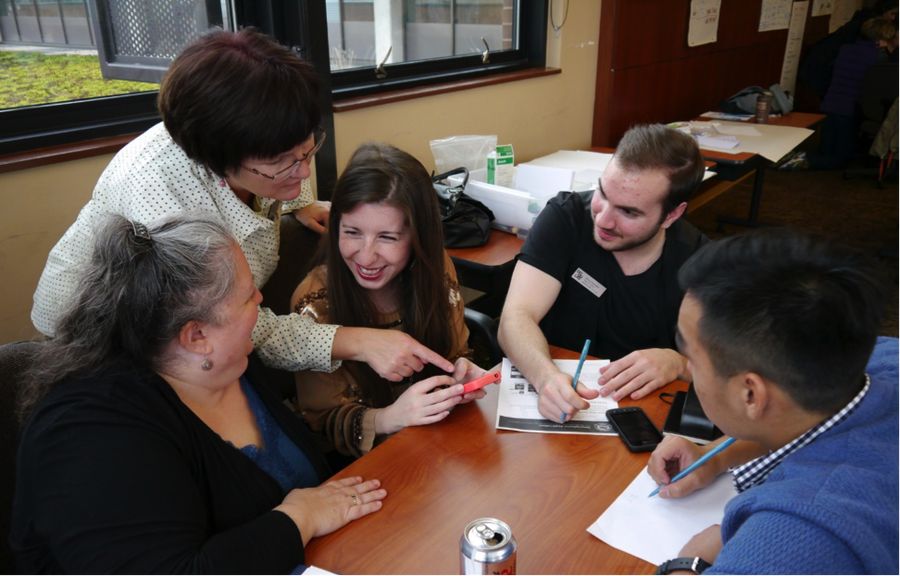
Nothing dampens your enjoyment of a holiday more than having to worry about work – even if it’s something fun like a team building event. But for one T-Mobile employee, this was shaping up to be the case. That’s because, on the day before the holiday weekend, she found out that she needed to organize a last-minute activity for the day after July Fourth.
So, she reached out to Outback Team Building & Training to see if there was anything we could do to help – in less than three business days. We were happy to be able to help offer her some peace of mind over her holiday weekend by recommending a quick and easy solution: a Code Break team building activity. It was ready to go in less than three days, the activity organized was stress-free during her Fourth of July weekend, and, most importantly, all employees had a great experience.
For more details, check out the full story here: Finding a Last-Minute Activity Over a Holiday .
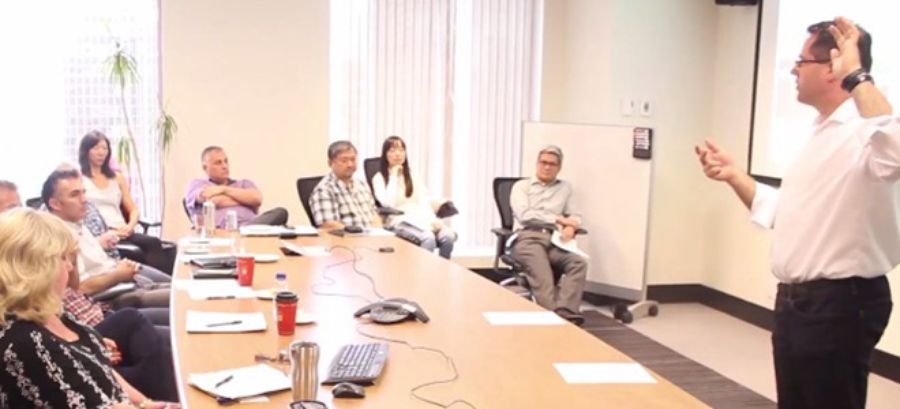
At Outback Team Building & Training, we know our customers don’t always have time on their side when it comes to planning and executing an event. Sometimes, they need answers right away so they can get to work on creating an unforgettable experience for their colleagues.
This was exactly the case when Black & McDonald approached us about a learning and development session that would meet the needs of their unique group, and not take too much time to plan. At 10:20 a.m., the organization reached out with an online inquiry. By 10:50 a.m., they had been connected with one of our training facilitators for a more in-depth conversation regarding their objectives.
Three weeks later, a group of 14 Toronto, Ontario -based Black & McDonald employees took part in a half-day tailor-made training program that was built around the objectives of the group, including topics such as emotional intelligence and influence, communication styles, and the value of vulnerability in a leader.
To learn more about how this event was able to come together so quickly, check out the full story: From Inquiry to Custom Call in Under 30 Minutes .
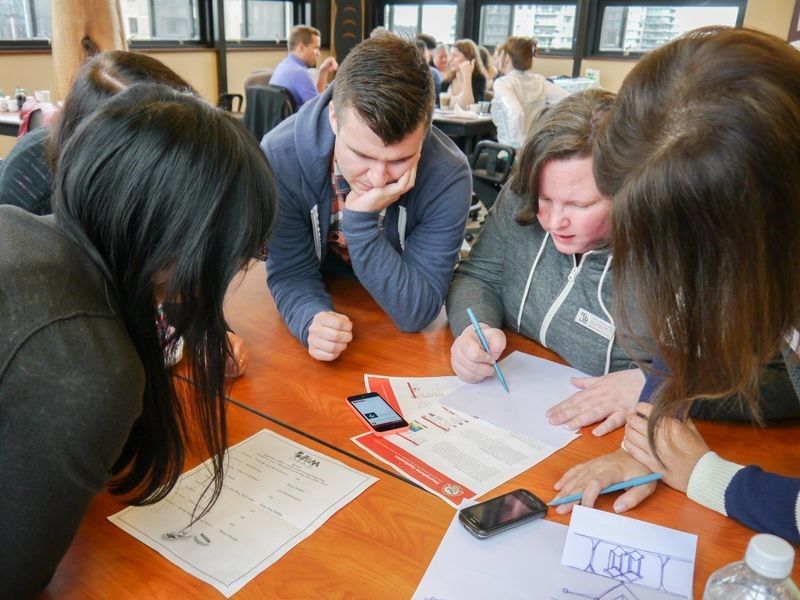
When Conexus Credit Union contacted us on a Friday afternoon asking if we could facilitate a team building event for six employees the following Monday morning, we said, “Absolutely!”
The team at Conexus Credit Union were looking for an activity that would get the group’s mind going and promote collaboration between colleagues. And we knew just what to recommend: Code Break Express – an activity filled with brainteasers, puzzles, and riddles designed to test the group’s mental strength.
The Express version of Code Break was ideal for Conexus Credit Union’s shorter time frame because our Express activities have fewer challenges and can be completed in an hour or less. They’re self-hosted, so the company’s group organizer was able to easily and efficiently run the activity on their own.
To learn more about how we were able to come together and make this awesome event happen, take a look at our case study: A Perfect Group Activity Organized in One Business Day .
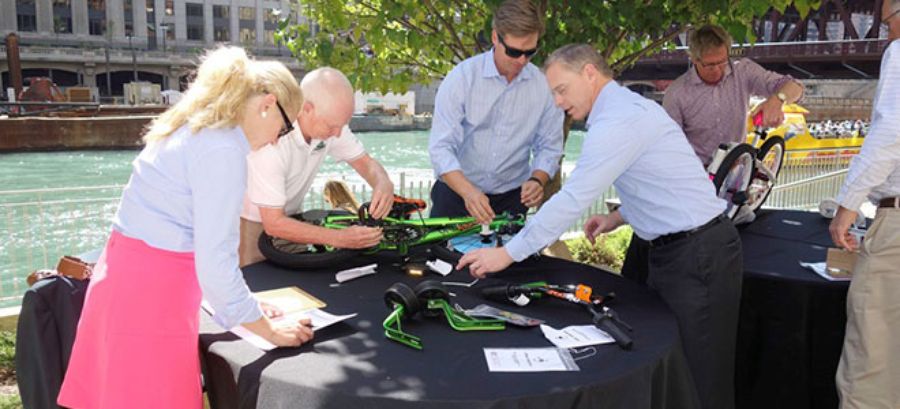
We’ve been lucky enough to work with Accenture – a company which has appeared on FORTUNE’s list of “World’s Most Admired Companies” for 14 years in a row – on a number of team building activities in the past.
The organization approached us with a request to facilitate a philanthropic team building activity for 15 employees. The hitch? They needed the event to be planned, organized, and executed within one week.
Staying true to our brand promise of being fast to act on behalf of our customers, our team got to work planning Accenture’s event. We immediately put to work the experience of our Employee Engagement Consultants, the flexibility of our solutions, and the organization of our event coordinators. And six days later, Accenture’s group was hard at work on a Charity Bike Buildathon , building bikes for kids in need.
To learn more about how we helped Accenture do some good in a short amount of time, read the full case study: Delivering Team Building for Charity in Under One Week .
Learn More About Team Building, Training and Development, and Coaching and Consulting Solutions
For more information about how Outback Team Building & Training can help you host unforgettable team activities to meet your specific goals and needs on virtually any time frame and budget, just reach out to our Employee Engagement Consultants.
Subscribe To Our Newsletter
And stay updated, related articles.
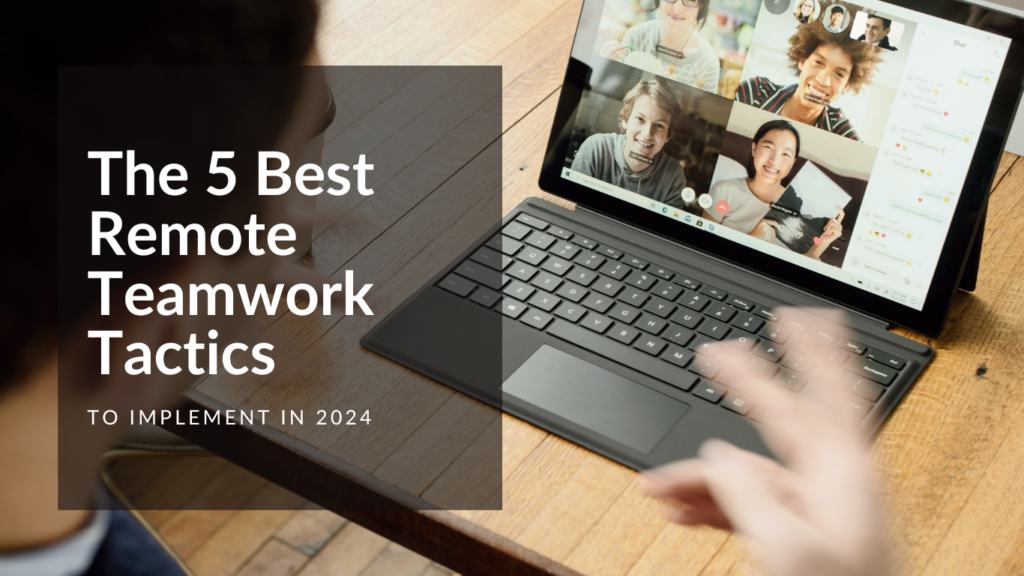
The 5 Best Remote Teamwork Tactics to Implement in 2024

How to Create an Engaging And Productive Virtual Internship Program
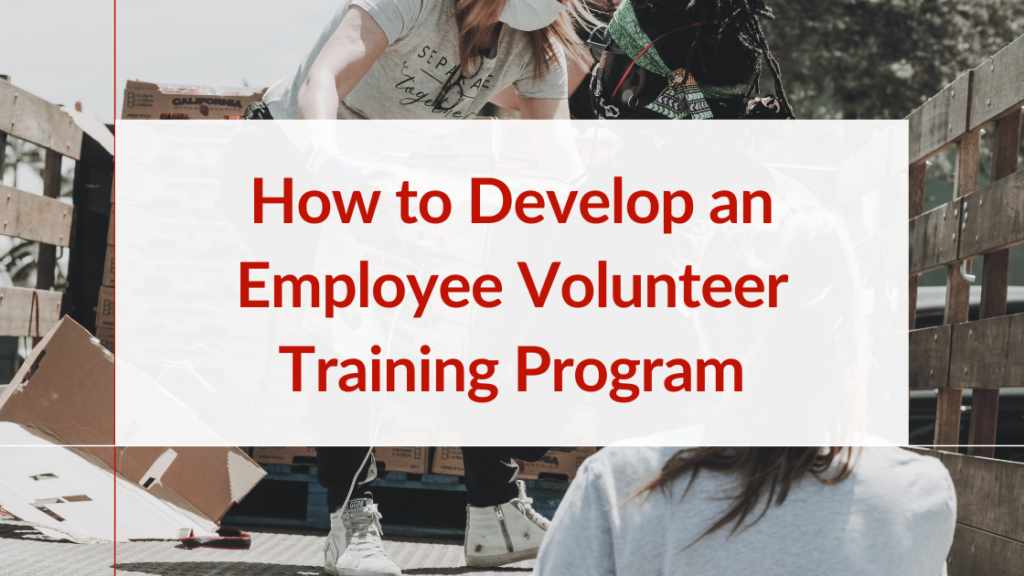
How to Develop an Employee Volunteer Training Program
From corporate groups to remote employees and everything in between, the key to a strong business is creating a close-knit team. That’s why you need to do team-building sessions as much as you can.
Thank you for visiting nature.com. You are using a browser version with limited support for CSS. To obtain the best experience, we recommend you use a more up to date browser (or turn off compatibility mode in Internet Explorer). In the meantime, to ensure continued support, we are displaying the site without styles and JavaScript.
- View all journals
- My Account Login
- Explore content
- About the journal
- Publish with us
- Sign up for alerts
- Open access
- Published: 06 May 2021
Interpersonal relationships drive successful team science: an exemplary case-based study
- Hannah B. Love ORCID: orcid.org/0000-0003-0011-1328 1 ,
- Jennifer E. Cross ORCID: orcid.org/0000-0002-5582-4192 2 ,
- Bailey Fosdick ORCID: orcid.org/0000-0003-3736-2219 2 ,
- Kevin R. Crooks 2 ,
- Susan VandeWoude 2 &
- Ellen R. Fisher 3
Humanities and Social Sciences Communications volume 8 , Article number: 106 ( 2021 ) Cite this article
9156 Accesses
13 Citations
3 Altmetric
Metrics details
- Complex networks
- Science, technology and society
Scientists are increasingly charged with solving complex societal, health, and environmental problems. These systemic problems require teams of expert scientists to tackle research questions through collaboration, coordination, creation of shared terminology, and complex social and intellectual processes. Despite the essential need for such interdisciplinary interactions, little research has examined the impact of scientific team support measures like training, facilitation, team building, and expertise. The literature is clear that solving complex problems requires more than contributory expertise, expertise required to contribute to a field or discipline. It also requires interactional expertise, socialised knowledge that includes socialisation into the practices of an expert group. These forms of expertise are often tacit and therefore difficult to access, and studies about how they are intertwined are nearly non-existent. Most of the published work in this area utilises archival data analysis, not individual team behaviour and assessment. This study addresses the call of numerous studies to use mixed-methods and social network analysis to investigate scientific team formation and success. This longitudinal case-based study evaluates the following question: How are scientific productivity, advice, and mentoring networks intertwined on a successful interdisciplinary scientific team? This study used applied social network surveys, participant observation, focus groups, interviews, and historical social network data to assess this specific team and assessed processes and practices to train new scientists over a 15-year period. Four major implications arose from our analysis: (1) interactional expertise and contributory expertise are intertwined in the process of scientific discovery; (2) team size and interdisciplinary knowledge effectively and efficiently train early career scientists; (3) integration of teaching/training, research/discovery, and extension/engagement enhances outcomes; and, (4) interdisciplinary scientific progress benefits significantly when interpersonal relationships among scientists from diverse disciplines are formed. This case-based study increases understanding of the development and processes of an exemplary team and provides valuable insights about interactions that enhance scientific expertise to train interdisciplinary scientists.
Similar content being viewed by others
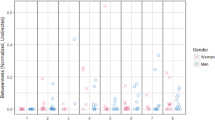
Towards understanding the characteristics of successful and unsuccessful collaborations: a case-based team science study
Hannah B. Love, Bailey K. Fosdick, … Ellen R. Fisher
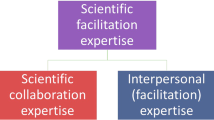
Science facilitation: navigating the intersection of intellectual and interpersonal expertise in scientific collaboration
Amanda E. Cravens, Megan S. Jones, … Hannah B. Love
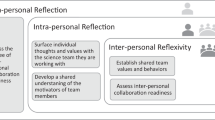
A framework for developing team science expertise using a reflective-reflexive design method (R2DM)
Gaetano R. Lotrecchiano, L. Michelle Bennett & Yianna Vovides
Introduction
Scientists are increasingly charged with solving complex and large-scale societal, health, and environmental challenges (Read et al., 2016 ; Stokols et al., 2008 ). These systemic problems require interdisciplinary teams to tackle research questions through collaboration, coordination, creation of shared terminology, and complex social and intellectual processes (Barge and Shockley-Zalabak, 2008 ; De Montjoye et al., 2014 ; Fiore, 2008 ). Thus, to successfully approach complex research questions, scientific teams must synthesise knowledge from different disciplines, create a shared terminology, and engage members of a diverse research community (Matthews et al., 2019 ; Read et al., 2016 ). Despite significant time, energy, and money spent on collaboration and interdisciplinary projects, little research has examined the impact of scientific team support measures like training, facilitation, team building, and team performance metrics (Falk-Krzesinski et al., 2011 ; Klein et al., 2009 ).
Studies examining the development of scientific teaming skills that result in successful outcomes are sparse (Fiore, 2008 ; Hall et al., 2018 ; Wooten et al., 2014 ). The earliest studies of collaboration in science used bibliometric data to search for predictors of team success such as team diversity, size, geographical proximity, inter-university collaboration, and repeat collaborations (Borner et al., 2010 ; Cummings and Kiesler, 2008 ; Wuchty et al., 2007 ). Building from these studies, current research focuses on team processes. Literature suggests that to successfully frame a scientific problem, a team must also engage emotionally and interact effectively (Boix Mansilla et al., 2016 ) and that scientific collaboration involve consideration of the process, collaborator, human capital, and other factors that define an scientific collaboration (Bozeman et al., 2013 ; Hall et al., 2019 ; Lee and Bozeman, 2005 ). Similarly, Zhang et al. ( 2020 ) used social network analysis to examine how emotional intelligence is transmitted to team outcomes through team processes. Still more research is needed, and Hall et al. ( 2018 ) called for team science studies that use longitudinal designs and mixed-methods to examine project teams as they develop in order to move beyond bibliometric measures of success and to explore the complex, interacting features in real-world teams.
Fiore ( 2008 ) explained that much of what we know about the science of team science (SciTS), training scientists and team learning in productive team interactions, is anecdotal and not the result of systematic investigation (Fiore, 2008 ). Over a decade later there is still a paucity of research on how scientific teams develop the type of expertise they need to create new knowledge and further scientific discovery (Bammer et al., 2020 ). Bammer et al. ( 2020 ) has identified and defined two types of expertise: (1) contributory expertise, expertise required to make a contribution to a field or discipline (Collins and Evans, 2007 ); and (2) interactional expertise, socialised knowledge that includes socialisation into the practices of an expert group (Bammer et al., 2020 ). These forms of expertise are often tacit, codified by “learning-by-doing,” and augmented from project to project; therefore, they are difficult to measure and rarely documented in literature (Bammer et al., 2020 ).
Wooten et al. ( 2014 ) outlined three types of evaluations—developmental, process, and outcome—needed to understand how teams develop and to provide information about their future success (Wooten et al., 2014 ). A developmental evaluation focuses on the continuous process of team development, and a process evaluation focuses on team interactions, meetings, and engagement (Patton, 2011 ). Both development and process evaluations have the common goal of understanding the team’s future success or failures, also known as the team’s outcomes (e.g., grants, publications, and awards) (Patton, 2011 ). The majority of published work on outcome metrics is evaluated by archival data analysis, not individual team behaviour and assessment (Hall et al., 2018 ). Albeit informative, these studies are based upon limited outcome metrics such as publications and represent only a selective sampling of teams that have achieved success. To collect these three types of evaluation data, it is recommended to engage mixed-methods research such as a combination of social network analysis (SNA), participant observation, surveys, and interviews, although these approaches have not been widely employed (Bennett, 2011 ; Borner et al., 2010 ; Fiore, 2008 ; Hall et al., 2018 ; Wooten et al., 2014 ).
A few key studies have provided insight into successful collaboration strategies. Duhigg ( 2016 ) found that successful teams provided psychological safety, had dependable team members, and relied upon clear roles and structures. In addition, successful teams had meaningful goals, and team members felt like they could make an impact through their work on the team (Duhigg, 2016 ). Similarly, Collins ( 2001 ) explained that in business teams, moving from “Good to Great” required more than selecting the right people; the team needed development and training to achieve their goals (Collins, 2001 ). Woolley et al. ( 2010 ) found that it is not collective intelligence that builds the most effective teams, but rather, how teams interact that predicts their success (Woolley et al., 2010 ). The three traits they identified as most associated with team success included even turn-taking, social sensitivity, and proportion female (when women’s representation nears parity with men) (Woolley et al., 2010 ). Finally, Bammer et al. ( 2020 ) recommended creating a knowledge bank to strengthen knowledge about contributary and interactional expertise in scientific literature to solve complex problems. Collectively, these studies argue that the key to collective intelligence is highly reliant on interpersonal relationships to drive team success.
This article reports on a longitudinal case-based study of an exemplary interdisciplinary scientific team that has been successful in typical scientific outputs, including competing for research awards, publishing academic articles, and training and developing scientists. This analysis examines how scientific productivity, advice, and mentoring networks intertwined to promote team success. The study highlights how the team’s processes to train scientists (e.g., developing mentoring and advice networks) have propelled their scientific productivity, fulfilled the University’s land grant mission (i.e., emphasises research/discovery; education/training; and outreach/engagement) and created contributory and interactional expertise on the team. Team dynamics were evaluated by social network surveys, participant observation, focus groups, interviews, and historical social network data over 15 years to develop theory and evaluate complex relationships contributing to team success (Dozier et al., 2014 ; Greenwood, 1993 ).
Case study selection
The [BLIND] Science of team science (SciTS) team consisted of scientists trained in four different disciplines and research administrators. The SciTS team monitored twenty-five interdisciplinary teams at [BLIND] for 5 years from initiation of team formation to identify team dynamics that related to team success. This case is thus presented as part of an ongoing study of the 25 teams, supported by efforts through the [BLINDED] to encourage and enhance collaborative, interdisciplinary research and scholarship. Team outcomes were recorded annually and included extramural awards, publications, presentations, students trained, and training outcomes. An exemplary case-based study is appropriate when the case is unusual, the issues are theoretically important, and there are practical implications (Yin, 2017 ). Further, cases can illustrate examples of expertise and provide guidance to future teams (Bammer et al., 2020 ). An “exemplary team designation” was given to this team by the SciTS evaluators. Metrics used to designate an exemplary team included: team outcomes; highly interdisciplinary research; longevity of the team; fulfilment of all aspects of the land grant mission (research/discovery; education/training; and outreach/engagement); integration of team members; and use of external reviewers.
Social network survey
The exemplary team included Principle Investigators (PIs), postdoctoral researchers (postdocs), graduate students, undergraduate students, and active collaborators external to the University. The entire team was surveyed annually 2015–2019 about the extent and type of collaboration with other team members. In 2015, the team was asked about prior collaborations, and in subsequent years they were asked about additional interactions since joining the team. Possible collaborative activities included research publications, scientific presentations, grant proposals, and serving on student committees. Team members were also asked the types of relationships they had with each team member, including learning, leadership, mentoring, advice, friendship, and having fun (Supplementary 2 ). Data were collected using a voluntary online survey tool (Organisational Network Analysis Surveys). All subjects were identified by name on the social network survey but are not identified in any network diagrams or analyses. SNA software programmes R Studio (R Studio Team, 2020 ) and UCINET (Borgatti et al., 2014 ) were used to analyse data and Visone (Brandes and Wagner, 2011 ) was used to create visualisations. The response rate for the survey was 94% in 2015, 83% in 2016, 95% in 2017, and 81% in 2018. All data collection methods were performed with the informed consent of the participants and followed Institutional Review Board protocol #19-8622H.
Data from the social network survey were combined to create three different network measures: scientific productivity, mentoring, and advice. The scientific productivity network was a combination of four survey measures: research/consulting, grants, publications, and serving on student committees. Scientific productivity represents a form of cognitive or contributory expertise: expertise required to contribute to a field or discipline (Bammer et al., 2020 ; Boix Mansilla et al., 2016 ). The mentoring and advice networks were created from social network survey questions: “who is your mentor?” and “who do you go to for advice?”, respectively. Mentor and advice are tacit forms of interactional expertise: socialised knowledge that includes socialisation into the practices of an expert group (Collins and Evans, 2007 ). Other studies have also found a connection between social characteristics of interdisciplinary work and other factors like productivity, career paths, and a group’s ability to exchange information, interact, and explore together (Boix Mansilla et al., 2016 ).
Social network data were summarised using average degree, sometimes split into indegree and outdegree. Outdegree is a measure of how many team members a given individual reported getting advice, or mentorship, from. Similarly, the indegree of an individual is a measure of how many other team members reported receiving advice, or mentorship, from that person. Average degree is the average number of immediate connections (i.e., indegree plus outdegree) for a person in a network (Giuffre, 2013 ; R. Hanneman and Riddle, 2005 a, 2005 b). To further explore the mentoring and advice networks, we calculated the average degree/outdegree/indegree of postdocs, graduate students, and faculty separately to directly compare demographic groups.
The advice, mentoring, and scientific productivity networks were directly compared using the Pearson correlation between the corresponding network adjacency matrices. We predicted a positive correlation between the advice, mentoring, and scientific productivity matrices. Statistical significance ( p < 0.05) of correlations was assessed with the network permutation-based method Quadratic Assignment Procedure (QAP) (R. A. Hanneman and Riddle, 2005 a, 2005 b).
Historical social network data
A historical network survey was created to determine how the connections in the network formed, developed, and changed from project-to-project. The historical social network was constructed from three forms of data: interviews with the PIs, a historical narrative written by the PIs describing the team formation process, and team rosters that listed the 81 team members since the inception of the team.
Retrospective team survey
A retrospective team survey was administered at the end of the study to determine what skills team members developed and codified through participating on the team, how membership on the team supported members personally and professionally, and their favourite aspects of the team. The survey was sent to 22 members from the 2018 team roster using Qualtrics (Qualtrics Labs, 2005 ) with an 86% response rate.
Two semi-structured, one-hour interviews were conducted with two PIs in 2018 to learn about the history of the team. The interviews were digitally recorded and transcribed.
Participant observations
Participant observation was conducted from 2015–2019 at four annual three-day, off-campus retreats and 1–2 additional meetings each year. Students, PIs, external collaborators, and families were all invited to attend the retreats and meetings. Field notes about team interactions were recorded immediately after each interaction. The analytic field notes captured how team members interacted across disciplines, tackled scientific problems, and engaged with others at different career stages. Analysis occurred as field notes were written, during observations, and again during data analysis.
An exemplary team
The SciTS Team identified one team from the larger study and designated it as exemplary based on six (tacit and non-tacit) elements. First, the team had outstanding team outcomes. From 2004–2018, notable accomplishments include 33 extramural awards totalling over $5.6 million, including two large federal awards totalling over $4.5 million; 58 peer-reviewed publications with 39 different universities, 13 state agencies, and 11 other organisations; 141 presentations, 21 graduate students and 15 postdocs trained; and receipt of an [BLIND]institution-wide Interdisciplinary Scholarship Team Award. Participants received many individual honours, including one of the PIs being named to the National Academy of Sciences.
Second, this interdisciplinary team combined scientific expertise from many different backgrounds, including ecologists, wildlife biologists, evolutionary biologists, geneticists, veterinarians, and numerous collaborators. Principal Investigators were housed in five main universities: Colorado State University, University of Wyoming, University of Minnesota, University of California-Davis, and University of Tasmania. They also engaged collaborators from national and international universities, federal, state, and local governmental agencies, veterinary centres, and animal shelters. Collectively, team members represented 39 different universities, 11 federal agencies, 13 state agencies, and 11 other organisations listed on their peer-reviewed publications. The team has published globally with co-authors from every continent but Antarctica.
The third element identified was the team’s 15-year history and how they evolved project-to-project (Supplementary Video S1 ). In 2003, a graduate student proposed a collaborative research project between two faculty members who became two of the founding team PIs (Fig. 1 ). The team was formed in 2004 with four members—two faculty PIs, a postdoc, and a Ph.D. student (Fig. 1 ). Initial grant proposals submitted in 2005 and 2006 were not funded; however, in 2007, the team received a large federal research award from the US National Science Foundation (NSF). The team roster increased from four to nine, and a second large expansion occurred after receipt of another NSF award in 2012. By 2014, membership increased to 31 people, and at the end of analysis in 2018, the roster comprised 43 members. Over the course of observation, 81 different individuals, including students, faculty, and collaborators, had participated in research activities supported by the team.
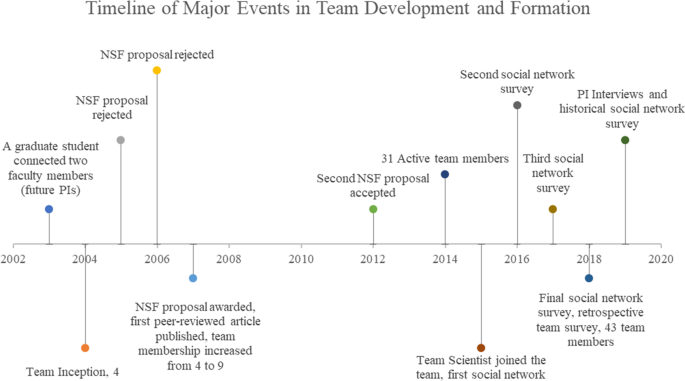
Significant events occurring over 15 years during the development and formation of an exemplary team.
The fourth reason this team was deemed exemplary was because it intertwined the components in the Land Grand mission, including research/discovery, teaching/training, and extension/engagement (Fig. 2 ). The team included undergraduates conducting research and presenting at conferences, graduate students working in multiple labs, and postdocs mentoring all the researchers in the lab. An external advisor said at the end of a retreat, “It’s really cool that students are part of the conversations that are both good/bad/ugly etc. It is not just good. It is not just one-on-one conversations. They hear it all.” A Ph.D. student wrote in the Retrospective Survey about the skills he developed: “I have developed the ability to talk about my research to people outside my field. I have also worked on broadening my understanding of disease ecology as a whole. I have been given the opportunity [to] begin placing my work in the larger framework of ecosystem health.” Faculty also wrote about what they learned, “[I] Learned from leadership of team (especially [blinded], and other PIs) how to develop and conduct research team work well - am using what I am learning to develop new research teams…. how to develop and nurture and respect interpersonal relationships and diversity of opinions. This has been an amazing experience, to be part of a well-functioning team, and to examine why and how that is maintained”
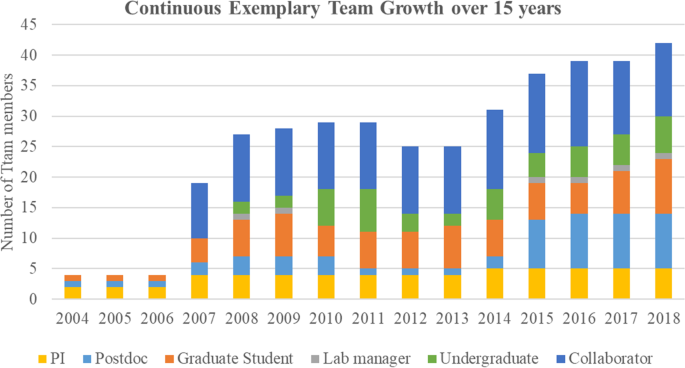
The team grew from 4 members in 2004 to 42 members in 2018. Much of the growth occurred by the addition of students and external collaborators.
Fifth, the team was effective at onboarding and integrating new members. To do so, they used two key strategies (Fig. 3 ). First, 15 of the students held co-advised graduate research positions. This shared model of mentorship provided students with opportunities to work in multiple labs, collaborate with additional team members, and gain a broader academic experience. A Ph.D. student wrote in the Retrospective Survey about the skills she learned from being a member of the team: “Leadership skills, communicating science to those in other fields, scientific writing skills, technical laboratory skills, interpersonal communication skills, data sharing experience, and many others.” The shared model supported the team’s interdisciplinary mission by providing opportunities to train future scientists to communicate, network, and conduct research across disciplines. Second, as team members developed through participation on the team, they assumed more mature scientific roles. Fourteen members of the team changed positions within the team. Many of these transitions were from undergraduate student to Ph.D. student or Ph.D. student to postdoctoral researcher. In 2012, one postdoc became a PI on the grant.
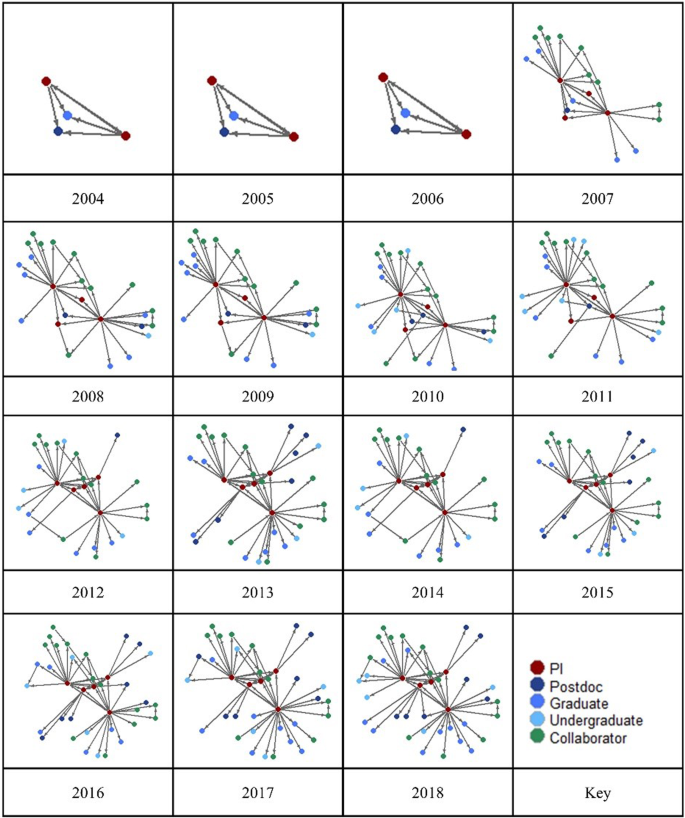
Social network diagrams of team growth and development from 2004–2018. This network reports onboarding and integration of all members, including their primary position when they joined the team. The nodes are sized by average degree (see text). Colours denote different roles on the team.
Finally, the 2018 team retreat included external reviewers. At the end of 2018 team retreat, they were asked if they had any feedback for the team. An external reviewer said: “You can check all of the boxes of a good team.”; “This is a dream team.”; “I am really impressed.”. Another external reviewer said:
The ambitiousness to execute the scope of the project, to have this many PIs, to be able to communicate; the opportunities for new insights; and the opportunities it presents for trainees are rare. There are a lot of people exposed in this. This is a unique experience for someone in training. And it extends to elementary school. I don’t think there are many projects that have this type of scope. I was impressed with just the idea that scientists are taking this across such a great scope and taking on such great questions.
Scientific productivity network
Prior to 2016, the average degree of the scientific productivity network was 8.8 (Fig. 4 ). In 2016, four faculty nodes were in the core of the network, and the periphery nodes included graduate students, postdocs, and external collaborators (Fig. 5 ). The average degree dropped slightly to 6.2 when the team integrated new members and re-formed around new roles and responsibilities on a new grant (Fig. 4 ). In 2017, the average degree peaked at 9.7 (Fig. 4 ) and faculty were still core, but graduate students and postdocs were more central than before (Fig. 5 ). During this time, productivity was at its highest as team members were working together to meet the objectives of a 5-year interdisciplinary NSF award. The network evolved further in 2018; two of the postdoc nodes overlapped with the faculty nodes in the core of the network (Fig. 5 ).
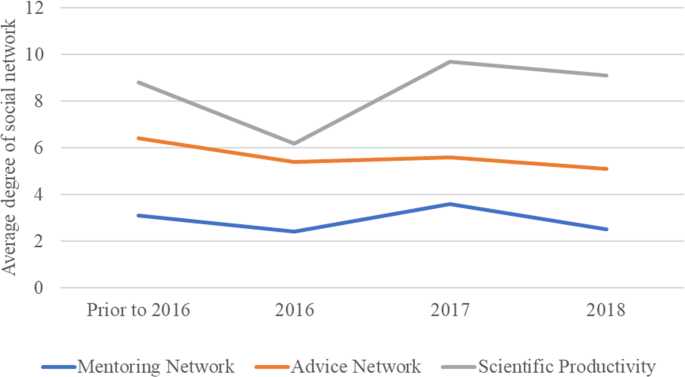
Average degree of social networks diagrams (mentoring, advice, scientific productivity) indicated strong social ties among team members.

Social network measures of productivity (research/consulting, grants, publications, and serving on student committees) were recorded over time. Each node represents a person on the team, and nodes are sized by average degree (see text). Colours denote different roles on the team. The node label indicates the number of years a person has been part of the team.
Mentoring is integral in the collaborative network
Team members reported between an average of 2.4–3.1 mentors (average outdegree) each year on the team (Fig. 6 ). More specifically, graduate students reported 6.0–7.7 mentors, whereas postdocs reported 2.4–3.5 mentors (Table 1 ). Faculty team members reported having an average of 2.2 to 4.3 mentors on the team (Table 1 ), with the highest average outdegree in 2018.

This diagram was created by using participant answers to the social network question, “who is your mentor?” Each circle or node represents a person on the team. The nodes are sized by outdegree to show who reported receiving mentorship. Node size indicates how many mentors an individual reported, and arrows indicate nodes that served as mentors. Colours denote different roles on the team.
The highest indegree for an individual was the lead PI, with an indegree ranging from 13 to 14 each year (i.e., each year, 13–14 team members reported this individual provided mentorship). In response to an interview question about this PIs favourite part of the team, this individual said, “…and of course, I really like the mentorship of the students…They are initially naive, and some people are initially underconfident, but eventually they become fluent in their subject area.” Many students wrote about the mentoring they received from the team. An undergraduate student wrote:
I have improved my communication skills after needing to collaborate with several mentors across different time zones. I’ve also improved willingness to ask questions when I don’t understand a concept. I’ve also learned what concepts I find basic in my field that others outside my discipline are less familiar with.
Faculty also wrote about the mentoring they received, such as, “I continually learn from members in the team and mentorship by the more experienced members has supported my own career progression.”
Advice is integral in the collaborative network
In the 2015–2017 advice network diagrams, the faculty were tightly clustered (Fig. 7 ). In 2018, the cluster separated as postdocs and graduate students joined the centre of the network. On average, team members reported 5.1 to 6.4 people they could go to for advice (Fig. 4 ).

This diagram was created by using participant answers to the social network question, “who do you go to for advice?” Each circle or node represents a person on the team. The nodes are sized by outdegree to show who reported receiving mentorship. Node size indicates how many mentors an individual reported, and arrows indicate nodes that served as mentors. Colours denote different roles on the team.
In a survey, faculty responded to the question, “How has the team supported you personally and professionally?” One faculty member wrote: “Just today I asked three members of the team for professional advice! And got a thoughtful and prompt response from all.” Another team member wrote: “Being a member of the…team has allowed me to develop skills in statistical analysis, scientific writing, and critical thinking. This team has opened my eyes to what is possible to achieve with science and has provided me with opportunities to network and expand my horizons both within the field of study and outside of it.” These quotes further suggest that the mentoring and advice from a large interdisciplinary team were important to train future scientists.
Interpersonal relationships as driver for scientific productivity
The mentoring and advice networks supported and built on the scientific productivity network and vice versa. The correlation between the collaboration, mentoring, and advice networks would not be possible if the networks were not intertwined. In the retrospective survey, a faculty member described how tacit interpersonal relationships were correlated with their scientific productivity:
Being a part of this grant has helped me both personally and professionally by teaching me new skills (disease ecology, team dynamics), developing friendships/mentors from the team, and strengthening my CV and dossier for promotion to early full professorship.
A Ph.D. student also described how the relationships on the large team propelled their research.
Membership on this team has provided me with a lot of mentorship that I would not otherwise receive were I not working on a large multi-disciplinary for my doctoral research. It has also allowed me to network more effectively.
Between 2015 and 2018, the mentor and advice networks were significantly correlated with the scientific productivity network, demonstrating that personal relationships are associated with scientific collaboration (Table 2 ).
To date, the literature examining successful interdisciplinary scientific team skills that result in successful outcomes is sparse (Fiore, 2008 ; Hall et al., 2018 ; Wooten et al., 2014 ). The majority of published work in this area is evaluated by archival data analysis, not individual team behaviour and assessment (Hall et al., 2018 ). This study answers the call of numerous researchers to use mixed-methods and SNA to investigate scientific teams (Bennett, 2011 ; Borner et al., 2010 ; Hall et al., 2018 ; Woolley et al., 2010 ; Wooten et al., 2015 ). Our case-based study also increases understanding of the development and processes of an exemplary team by providing valuable insights about how the interactions that enhance scientific productivity are synergistic with the interactions that train future scientists. There are four major implications of our findings: (1) interactional and contributory expertise are intertwined; (2) team size, tacit knowledge gained from previous project, and interdisciplinary knowledge were used to effectively and efficiently train scientists; (3) the team increased scientific productivity through interpersonal relationships; and (4) the team fulfilled the land grant mission of the University by integrating teaching/training, research/discovery, and extension/engagement into the team’s activities.
Interactive and contributory expertise are intertwined
Previous literature on scientific teams has found that great teams are not built on scientific expertise alone, but on the processes and interactions that build psychological safety, create a shared language, engage members emotionally, and promote effective interactions (Boix Mansilla et al., 2016 ; Hall et al., 2019 ; Senge, 1991 ; Woolley et al., 2010 ; Zhang et al., 2020 ). The team highlighted in this report created a shared language and vision through the mentoring and advice networks that helped fuel the team’s scientific productivity (Hall et al., 2012 ). To solve complex problems requires more than contributory expertise, it also requires interactional expertise (Bammer et al., 2020 ). These forms of expertise are often tacit and internalised through the process of becoming an expert in a field of study (Collins and Evans, 2007 ). Learning-by-doing is augmented from project-to-project, with expertise codified over time (Bammer et al., 2020 ). Further, cognitive, emotional, and interactions are key components of successful collaborations (Boix Mansilla et al., 2016 ; Bozeman et al., 2013 ; Zhang et al., 2020 ). Using social network analysis, our case-based analysis found that the mentoring and advice ties were intertwined with the scientific productivity network.
Training scientists to be experts
The Retrospective Survey asked what personal and professional skills respondents learned from being a member of a team. We hypothesised that many respondents would report tangible skills. Surprisingly, 82% of the open-ended responses were about tacit skills. Students frequently had co-advised graduate research positions, worked in multiple labs, and communicated regularly with practitioners. Moreover, the team translated research to different disciplines within the team, mentored others, and managed interpersonal conflicts. These interactions built expertise because training was not limited to research in a single lab or only in an academic setting. Simple, discrete, and codified knowledge is relatively easy to transfer; however, teams need stronger relationships to gain complex and tacit knowledge, (Attewell, 1992 ; Simonin, 1999 ). On this team, interactions and the ability to practice communication were especially influential for students, junior scientists, and new members. These individuals provided survey responses reporting they learned a wide variety of skills ranging from leadership, scientific and interpersonal communication, networking across disciplines, scientific writing, laboratory techniques, and data sharing standards. Further, respondents noted they had gained experience in developing, nurturing, and respecting interpersonal relationships and diversity of opinions. This was reinforced with participant observation data. In other interdisciplinary groups studied in conjunction with this exemplary team, students were not typically exposed to the inner workings of the team such as leadership meetings. On this team, students were exposed to all conversations, which became an important component of the mentoring and advice structure, serving to train future scientists in all aspects of team integration and leadership development. Belonging to this large interdisciplinary team was effectively training, building, and structuring the team.
Interpersonal relationships increase scientific productivity
Longevity of relationships is an important factor in creating social cohesion, reducing uncertainty, and increasing reliability and reciprocity (Baum et al., 2007 ; Gulati and Gargiulo, 1999 ; Phelps et al., 2012 ). Previous literature has, however, rarely documented the importance of time in building the structure of the network (Phelps et al., 2012 ) and few longitudinal studies of scientific teams exist. Further, it has long been hypothesised that greater interaction among people increases the quality and innovativeness of ideas generated, which may in turn increase productivity (Cimenler et al., 2016 ). Our case-based study found that the mentoring and advice ties existed in a symbiotic relationship with the scientific productivity network where the practices of the team were simultaneously training scientists. This aligns with social network literature that interactions can structure the social network and the network structure influences interactions (Henry, 2009 ; Phelps et al., 2012 ). Second, intentional mentoring programmes have demonstrated a positive relationship between interdisciplinary mentoring and increased research productivity outcomes such as grant funding and publications (Spence et al., 2018 ). Finally, this finding also aligns with literature on the generation of new knowledge (Phelps et al., 2012 ). Knowledge creation has traditionally been framed in terms of individual creativity, but recent studies have placed more emphasis on how the contribution of social dynamics are influential in explaining this process (Boix Mansilla et al., 2016 ; Csikszentmihalyi, 1998 ; Phelps et al., 2012 ; Sawyer, 2003 ; Zhang et al., 2009 ). Thus, while we might think that science drives the team, in this case-based study, the team’s interpersonal relationships were the driver of the team’s scientific productivity.
Fulfilling the land grant mission
As noted above, this exemplary team fulfilled all three goals of the land grant mission. First, the team was training scientists at all levels, from undergraduate students, to graduate students, postdocs, new faculty, and external collaborators, including community partners. In many instances, the training and mentoring was structured in a vertically integrated manner. For example, postdocs were training graduate and undergraduate students, typical of many teams. In addition to the “top-down” scenarios, however, the team also encouraged training that went from the bottom up as well. Effectively, this is a hallmark of successful teams in other sectors such as emergency responders and elite military teams – whomever has the knowledge to drive the issue at hand is the effective “leader” in that mission (Kotler and Wheal, 2008 ). Second, the team excelled in research and discovery, partnering with a diversity of external collaborators to do so. This created a network structure wherein the team clearly utilised the collaborators for mentoring and advice. Organisations with a core-periphery network structure like this team have been reported to be more creative because ties on the periphery, such as external collaborators, can span boundaries and access diverse information (Perry-Smith, 2006 ; Phelps et al., 2012 ). Finally, because the team’s collaborators included community partners and practitioners, they were also influencing policy and practice. This resulted in an overall greater impact for the team’s science and allowed them to tailor their research to best meet the needs of society (Barge and Shockley-Zalabak, 2008 ).
Future research
This study provides a unique contribution to team science literature because it longitudinally studied the development and processes of a successful interdisciplinary team (Wooten et al., 2014 ). Future research on the elements of effective interdisciplinary teaming is required in five key areas. First, identification of best practices that inhibit or support teams is necessary (Fiore, 2008 ; Hall et al., 2018 ; Wooten et al., 2014 ). Second, previous research has found that small teams are best at disrupting science with new ideas and opportunities (Wu et al., 2019 ); however, practices large teams use to create new knowledge have been poorly documented. Third, successful training concepts for graduate students and postdoctoral researchers need additional consideration (Knowlton et al., 2014 ; Ryan et al., 2012 ; Sarraj et al., 2017 ). Fourth, we hypothesise that graduate students act as bridges in teams to connect scientific disciplines and prevent clustering the network. Future research should investigate the role of graduate students in creating knowledge through interdisciplinary teams. Finally, additional research is needed to better recognise and reward scientists who undertake integration and implementation (Bammer et al., 2020 ).
Data availability
The datasets generated during and analysed during the current study are available in the Mountain Scholar repository, https://doi.org/10.25675/10217/214187
Attewell P (1992) Technology diffusion and organizational learning: the case of business computing. Organ Sci 3(1):1–19. https://doi.org/10.1287/orsc.3.1.1
Article Google Scholar
Bammer G, O’Rourke M, O’Connell D, Neuhauser L, Midgley G, Klein JT, … Richardson GP (2020). Expertise in research integration and implementation for tackling complex problems: when is it needed, where can it be found and how can it be strengthened? Palgrave Commun, 6(1). https://doi.org/10.1057/s41599-019-0380-0
Barge JK, Shockley-Zalabak P (2008) Engaged scholarship and the creation of useful organizational knowledge. J Appl Commun Res 36(3):251–265. https://doi.org/10.1080/00909880802172277
Baum JAC, McEvily B, Rowley T (2007) Better with age? Tie longevity and the performance implications of bridging and closure. SSRN (vol. 23). INFORMS. https://doi.org/10.2139/ssrn.1032282
Bennett ML (2011) Collaboration and team science: a field guide-team science toolkit. Retrieved February 19, 2019, from https://www.teamsciencetoolkit.cancer.gov/Public/TSResourceTool.aspx?tid=1&rid=267
Boix Mansilla V, Lamont M, Sato K (2016) Shared cognitive–emotional–interactional platforms: markers and conditions for successful interdisciplinary collaborations. Sci Technol Human Value 41(4):571–612. https://doi.org/10.1177/0162243915614103
Borgatti SP, Everett MG, Freeman LC (2014) UCINET. Encyclopedia of social network analysis and mining. Springer New York, New York, NY, 10.1007/978-1-4614-6170-8_316
Google Scholar
Borner K, Contractor N, Falk-Krzesinski HJ, Fiore SM, Hall KL, Keyton J, Uzzi B (2010). A multi-level systems perspective for the science. Sci Transl Med 2: 49
Bozeman B, Fay D, Slade CP (2013, February 28). Research collaboration in universities and academic entrepreneurship: the-state-of-the-art. J Technol Transf https://doi.org/10.1007/s10961-012-9281-8
Brandes U, Wagner D (2011) Analysis and visualization of social networks. Springer, Berlin, Heidelberg, pp. 321–340. 10.1007/978-3-642-18638-7_15
Cimenler O, Reeves KA, Skvoretz J, Oztekin A (2016) A causal analytic model to evaluate the impact of researchers’ individual innovativeness on their collaborative outputs. J Model Manag 11(2):585–611
Collins H, Evans R (2007) Rethinking expertise. University of Chicago Press, Chicago
Book Google Scholar
Collins JC (2001) Good to great. HarperBusiness, New York, NY
Csikszentmihalyi M (1998) Implications of a systems perspective for the study of creativity. In: Sternberg R (ed) Handbook of creativity (pp. 313–336. Cambridge University Press, Cambridge, England. https://doi.org/10.1017/CBO9780511807916.018
Cummings JN, Kiesler S (2008) Who collaborates successfully? prior experience reduces collaboration barriers in distributed interdisciplinary research. Cscw: 2008 Acm conference on computer supported cooperative work, Conference Proceedings, pp. 437–446. https://doi.org/10.1145/1460563.1460633
De Montjoye YA, Stopczynski A, Shmueli E, Pentland A, Lehmann S (2014) The strength of the strongest ties in collaborative problem solving. Sci Rep 4. https://doi.org/10.1038/srep05277
Dozier AM, Martina CA, O’Dell NL, Fogg TT, Lurie SJ, Rubinstein EP, Pearson TA (2014) Identifying emerging research collaborations and networks: method development. Eval Health Prof 37(1):19–32. https://doi.org/10.1177/0163278713501693
Article PubMed Google Scholar
Duhigg Ch (2016) What google learned from its quest to build the perfect team-The New York Times. Retrieved December 2, 2017, from https://www.nytimes.com/2016/02/28/magazine/what-google-learned-from-its-quest-to-build-the-perfect-team.html
Falk-Krzesinski HJ, Contractor N, Fiore SM, Hall KL, Kane C, Keyton J, Trochim W (2011) Mapping a research agenda for the science of team science. Res Eval 20(2):145–158. https://doi.org/10.3152/095820211X12941371876580
Article PubMed PubMed Central Google Scholar
Fiore SM (2008) Interdisciplinarity as teamwork. Small Group Res 39(3):251–277. https://doi.org/10.1177/1046496408317797
Giuffre K (2013) Communities and networks: using social network analysis to rethink urban and community studies, 1st edn. Polity Press, Cambridge MA, 10.1177/0042098015621842
Greenwood RE (1993) The case study approach. Bus Commun Q 56(4):46–48. https://doi.org/10.1177/108056999305600409
Gulati R, Gargiulo M (1999) Where do interorganizational networks come from? Am J Sociol 104(5):1439–1493. https://doi.org/10.1086/210179
Hall KL, Vogel AL, Croyle RT (2019) Strategies for team science success: handbook of evidence-based principles for cross-disciplinary science and practical lessons learned from health researchers. Springer Nature, Switzerland
Hall KL, Vogel AL, Huang GC, Serrano KJ, Rice EL, Tsakraklides SP, Fiore SM (2018) The science of team science: a review of the empirical evidence and research gaps on collaboration in science. Am Psychol 73(4):532–548. https://doi.org/10.1037/amp0000319
Hall KL, Vogel AL, Stipelman BA, Stokols D, Morgan G, Gehlert S (2012) A four-phase model of transdisciplinary team-based research: goals, team processes, and strategies. Transl Behav Med 2(4):415–430. https://doi.org/10.1007/s13142-012-0167-y
Hanneman RA, Riddle M (2005a) Introduction to social network methods: table of contents. Riverside, CA. Retrieved from http://faculty.ucr.edu/~hanneman/nettext/
Hanneman R, Riddle M (2005b) Introduction to social network methods. Retrieved from http://www.researchgate.net/profile/Robert_Hanneman/publication/235737492_Introduction_to_social_network_methods/links/0deec52261e1577e6c000000.pdf
Henry AD (2009). Society for human ecology the challenge of learning for sustainability: a prolegomenon to. source: human ecology review (Vol. 16). Retrieved from https://www-jstor-org.ezproxy2.library.colostate.edu/stable/pdf/24707537.pdf?refreqid=excelsior%3Ae9ffb98fef69c055ab05ead486b9ca7e
Klein C, DiazGranados D, Salas E, Le H, Burke CS, Lyons R, Goodwin GF (2009) Does team building work? Small Group Res 40(2):181–222. https://doi.org/10.1177/1046496408328821
Knowlton JL, Halvorsen KE, Handler RM, O’Rourke M (2014) Teaching interdisciplinary sustainability science teamwork skills to graduate students using in-person and web-based interactions. Sustainability (Switzerland) 6(12):9428–9440. https://doi.org/10.3390/su6129428
Kotler S, Wheal J (2008) Stealing fire: how silicon valley, the navy seals, and maverick scientists are revolutionising the way we live and work. Visual Comput (vol. 24). Retrieved from https://qyybjydyd01.storage.googleapis.com/MDA2MjQyOTY1NQ==01.pdf
Lee S, Bozeman B (2005) The impact of research collaboration on scientific productivity. Soc Stud Sci 35(5):673–702. https://doi.org/10.1177/0306312705052359
Matthews NE, Cizauskas CA, Layton DS, Stamford L, Shapira P (2019) Collaborating constructively for sustainable biotechnology. Sci Rep 9(1):19033. https://doi.org/10.1038/s41598-019-54331-7
Article ADS CAS PubMed PubMed Central Google Scholar
Patton MQ (2011) Developmental evaluation: applying complexity concepts to enhance innovation and use. Guilford Press
Perry-Smith JE (2006) Social yet creative: the role of social relationships in facilitating individual creativity. Acad Manag J 49(1):85–101. https://doi.org/10.5465/AMJ.2006.20785503
Phelps C, Heidl R, Wadhwa A, Paris H (2012) Agenda knowledge, networks, and knowledge networks: a review and research. J Manag 38(4):1115–1166. https://doi.org/10.1177/0149206311432640
Qualtrics Labs I (2005). Qualtrics Labs, Inc. Provo, Utah, USA
R Studio Team (2020) RStudio: Integrated Development for R. RStudio, PBC, Boston, MA, http://www.rstudio.com/
Read EK, O’Rourke M, Hong GS, Hanson PC, Winslow LA, Crowley S, Weathers KC (2016) Building the team for team science. Ecosphere 7(3):e01291. https://doi.org/10.1002/ecs2.1291
Ryan MM, Yeung RS, Bass M, Kapil M, Slater S, Creedon K (2012) Developing research capacity among graduate students in an interdisciplinary environment. High Educ Res Dev 31(4):557–569. https://doi.org/10.1080/07294360.2011.653956
Sarraj H, Hellmich M, Chao C, Aronson J, Cestone C, Wooten K, Allan, B (2017) Training future team scientists: reflections from translational course. In: Team science training for graduate students and postdocs. Clearwater, FL. Retrieved from www.scienceofteamscience.org
Sawyer RK (2003) Emergence in creativity and development. In: Sawyer RK, John-Steiner V, Moran S., Sternberg RJ, Nakamura J et al. (eds.) Creativity and development. Oxford University Press, Oxford, England, pp. 12–60
Chapter Google Scholar
Senge PM (1991) The fifth discipline, the art and practice of the learning organization. Perform Instruct 30(5):37–37. https://doi.org/10.1002/pfi.4170300510
Simonin BL (1999) Ambiguity and the process of knowledge transfer in strategic alliances. Strateg Manag J 20(7):595–623. 10.1002/(SICI)1097-0266(199907)20:7<595::AID-SMJ47>3.0.CO;2-5
Spence JP, Buddenbaum JL, Bice PJ, Welch JL, Carroll AE (2018) Independent investigator incubator (I3): a comprehensive mentorship program to jumpstart productive research careers for junior faculty. BMC Med Educ 18(1):1–11. https://doi.org/10.1186/s12909-018-1290-3
Stokols D, Misra S, Moser RP, Hall KL, Taylor BK (2008). The ecology of team science. Understanding contextual influences on transdisciplinary collaboration. Am J Prevent Med https://doi.org/10.1016/j.amepre.2008.05.003
Woolley AW, Chabris CF, Pentland A, Hashmi N, Malone TW (2010) Evidence for a collective intelligence factor in the performance of human groups. Science 330(6004):686–688. https://doi.org/10.1126/science.1193147
Article ADS CAS PubMed Google Scholar
Wooten KC, Calhoun WJ, Bhavnani S, Rose RM, Ameredes B, Brasier AR (2015) Evolution of multidisciplinary translational teams (MTTs): insights for accelerating translational innovations. Clin Transl Sci 8(5):542–552. https://doi.org/10.1111/cts.12266
Wooten KC, Rose RM, Ostir GV, Calhoun WJ, Ameredes BT, Brasier AR (2014) Assessing and evaluating multidisciplinary translational teams: a mixed methods approach. Eval Health Profession 37(1):33–49. https://doi.org/10.1177/0163278713504433
Wu L, Wang D, Evans JA (2019) Large teams develop and small teams disrupt science and technology. Nature 1. https://doi.org/10.1038/s41586-019-0941-9
Wuchty S, Jones BF, Uzzi B (2007) The increasing dominance of teams in production of knowledge. Science 316(5827):1036–1039. https://doi.org/10.1126/science.1136099
Yin RK (2017) Case study research and applications: design and methods (6th edn.). Sage Publications
Zhang HH, Ding C, Schutte NS, Li R (2020) How team emotional intelligence connects to task performance: a network approach. Small Group Res 51(4):492–516. https://doi.org/10.1177/1046496419889660
Article CAS Google Scholar
Zhang J, Scardamalia M, Reeve R, Messina R (2009) Designs for collective cognitive responsibility in knowledge-building communities. J Learn Sci 18(1):7–44. https://doi.org/10.1080/10508400802581676
Download references
Acknowledgements
A special thank you to Elizabeth Scodfidio for helping with data, images and more!. The research reported in this publication was supported by Colorado State University’s Office of the Vice President for Research Catalyst for Innovative Partnerships Programme. The content is solely the responsibility of the authors and does not necessarily represent the official views of the Office of the Vice President for Research. Supported by NIH/NCATS Colorado CTSA Grant Number UL1 TR002535. Contents are the authors’ sole responsibility and do not necessarily represent official NIH views. Funding and support were provided by grants from the National Science Foundation’s Ecology of Infectious Diseases Programme (NSF EF-0723676 and NSF EF-1413925).
Author information
Authors and affiliations.
Divergent Science LLC, Fort Collins, CO, USA
Hannah B. Love
Colorado State University, Fort Collins, CO, USA
Jennifer E. Cross, Bailey Fosdick, Kevin R. Crooks & Susan VandeWoude
University of New Mexico and Colorado State University, Fort Collins, CO, USA
Ellen R. Fisher
You can also search for this author in PubMed Google Scholar
Contributions
HBL conceptualised the study, developed the methodology, curated the data, analysed the data, conducted the investigation, worked as the project manager, managed the software, validated the data, created visualisations, reviewed and edited the paper; BF conceptualised the study, developed the methodology, curated the data, analysed the data, managed the software, validated the data, supervised all aspects of the research, created visualisations, reviewed and edited the paper; JC conceptualised the study, developed the methodology, acquired funding, supervised data collection, and reviewed and edited the paper; KC and SV wrote the paper, secured funding, reviewed and edited the paper; and ERF conceptualised the study, developed the methodology, supervised all aspects of the research, acquired funding, created the visualisations, reviewed and edited the paper; All authors reviewed the manuscript.
Corresponding author
Correspondence to Hannah B. Love .
Ethics declarations
Competing interests.
HBL, BF, JC, and ERF declare no competing interests. KC and SV are members of the exemplary team
Additional information
Publisher’s note Springer Nature remains neutral with regard to jurisdictional claims in published maps and institutional affiliations.
Supplementary information
Supplementary information, supplementary data, rights and permissions.
Open Access This article is licensed under a Creative Commons Attribution 4.0 International License, which permits use, sharing, adaptation, distribution and reproduction in any medium or format, as long as you give appropriate credit to the original author(s) and the source, provide a link to the Creative Commons license, and indicate if changes were made. The images or other third party material in this article are included in the article’s Creative Commons license, unless indicated otherwise in a credit line to the material. If material is not included in the article’s Creative Commons license and your intended use is not permitted by statutory regulation or exceeds the permitted use, you will need to obtain permission directly from the copyright holder. To view a copy of this license, visit http://creativecommons.org/licenses/by/4.0/ .
Reprints and permissions
About this article
Cite this article.
Love, H.B., Cross, J.E., Fosdick, B. et al. Interpersonal relationships drive successful team science: an exemplary case-based study. Humanit Soc Sci Commun 8 , 106 (2021). https://doi.org/10.1057/s41599-021-00789-8
Download citation
Received : 02 January 2021
Accepted : 14 April 2021
Published : 06 May 2021
DOI : https://doi.org/10.1057/s41599-021-00789-8
Share this article
Anyone you share the following link with will be able to read this content:
Sorry, a shareable link is not currently available for this article.
Provided by the Springer Nature SharedIt content-sharing initiative
Quick links
- Explore articles by subject
- Guide to authors
- Editorial policies
Internal Communication Case Studies: The Terrible & The Terrific
It’s a question that often comes up: ‘How do other businesses do this?’. Whether you’re implementing a new sales structure or updating your software systems, it’s always helpful to consider how similar companies approached the issue. This is particularly relevant for internal communications , where there is no one-size-fits-all solution. Each organisation has its own unique set of challenges and needs to tailor its internal communication strategy accordingly. Internal communication case studies can help you evaluate your approach, by exploring comparable situations and their outcomes.
In this blog, we’ve selected some of the best internal communication examples from the world of business. Not all were successful. In fact, some were complete disasters. But these failures, along with the success stories, are great examples of internal communication in action. When you’re looking for the answers to effective internal communication , nothing speaks more clearly than real-life examples.
We have grouped the following internal communication case study examples under the ‘seven golden rules’. These rules were proposed by Fitzpatrick in his ground-breaking publication Internal Communications: A Manual for Practitioners. These fundamental rules of internal communication best practices help us to categorise the relative successes and failures of these examples.
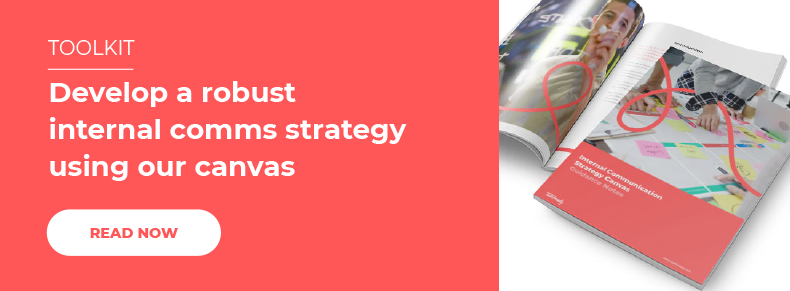
Rule 1: Activity means nothing without results
The starting point for every IC has to be: “What do we want people to do?” Being busy and generating a constant stream of campaigns, videos and newsletters is a waste of time if nothing changes as a result. When you’re looking at improving internal communications , always keep track of the outcome as well as the action. This is where the true significance lies.
Case Study 1 - Nationwide Building Society
Background: Nationwide Building Society ran an award-winning five-week BIG Conversation, gathering ideas from all its 18,000 employees in a company-wide collaboration. The aim was directed to reinvigorating Nationwide’s sense of purpose.
Approach: The activity included TalkBack events, online surveys and a huge listening exercise to give staff and members the chance to contribute to its future. By implementing a company-wide internal communications survey , Nationwide opened up a free-flowing conversation with its workforce.
Outcome: The result has been a refreshed strategy and a marketing campaign based on the new concept of ‘building society, nationwide’ – helping people improve the quality of their lives. This business communication case study demonstrates the power of actively listening and acting on employee’s suggestions.
Verdict: Success
Rule 2: Value benefits the business
You will only be adding real value if your employee communication links directly to the business needs of your organisation and helps to achieve a defined strategy or a specific project. The benefits of good internal communication only become apparent when you define your desired outcomes and set actual targets.
Case Study 2 – XPO Transport and Logistics
Background: XPO wanted to leverage great ideas from its colleagues across its 104 UK sites to help its customers improve productivity and reduce costs. Its large, flexible and hard-to-reach workforce (from drivers for Asda to B&Q warehouse contractors) don’t usually have a company phone or laptop. Of all the case studies on communication in the workplace, this large-scale exercise is remarkable in its scope.
Approach: To spark engagement, Talkfreely developed the Ideas Matter App, which every employee was able to download to their personal phone. An internal communications app is the ideal way to connect with remote workers and hard-to-reach employees.
Outcome: Linked directly to business needs, the internal communications platform proved to be exceptional value. The generation of ideas has been significant; 1 in 4 of all ideas submitted are being put into practice. In addition, it showed a remarkable return on investment of 6.5:1 with £156,000 of savings in the first year alone.
Rule 3: In the thick of it
When you’re looking for new ideas, trying to work out what your employees are really thinking or wondering why a previous internal communications plan went wrong, don't sit pondering at your desk or researching online. Leave your office and start talking. Once you talk and listen to your employees, you will begin to understand what motivates them, what concerns them and how they feel about the company. Of all the internal communication ideas , this one is key if you want to keep track of engagement levels.
Case Study 3 – AOL
Background: AOL announced it was slashing its Patch local news network by a third. This was a large-scale change affecting many employees across the company and required careful handling in its communication.
Approach: CEO Tim Armstrong set up a conference call with 1,000 employees with the aim of boosting morale across the workforce. As Armstrong talked, Patch Creative Director Abel Lenz began taking pictures of him. He was immediately sacked, in front of the 1,000 staff on the conference call.
Outcome: Perhaps Armstrong did not know that Lenz’s job included photographing meetings with key leaders for the Patch intranet, for the benefit of remote workers. But he should have. If he had been in touch with his workforce, he would have been fully aware of the roles of individual employees. This employee communication case study gives a clear indication of the importance of understanding your employee’s job roles.
Verdict: Failure
Rule 4: Shut up and listen
Communicating with employees should be a two-way street. The megaphone approach is never going to work best because people only feel connected and motivated if they are part of a conversation. It’s vital to put internal communication channels in place that allow employees to comment on the messages coming down from the top. Listen to what they have to say … and learn.
Case Study 4 – PayPal
Background: The digital payment company needed to address an internal report that revealed not all their employees were not using the PayPal app. The President, David Marcus, wrote a company-wide memo to all staff regarding the problem.
Approach: David Marcus took a heavy-handed approach to the matter. He told his staff to use the product or quit: “If you are one of the folks who refused to install the PayPal app or if you can’t remember your PayPal password, do yourself a favor, go find something that will connect with your heart and mind elsewhere”.
A better policy would have been to find out why his employees weren’t using the payment app, whether they felt competitor products had better features and ask for their suggestions.
Outcome: The memo was leaked to the press. It generated widespread coverage across the media and left customers wondering what was wrong with an app that PayPal’s own staff wouldn't use. Internal communications best practice case studies demonstrate that opening a two-way channel for feedback will improve both internal and external communication .

Rule 5 – I did it their way
Understand the working methods of those you need to convince. If leaders seem bound up in stats and spreadsheets, give them what they want. Gather data to prove your ideas work, show them a process, outline a clear outcome and they’ll soon be on your side. Measuring internal communications will help to provide the rationale behind your ideas. Equally, if the types of internal communication you are using don’t seem to be connecting with your employees, don’t be afraid to try a different approach.
Case Study 5 – Seymour House
Background: Seymour House runs ten outstanding childcare nurseries and wanted to get staff across the group engaging better with each other to share great practice. They needed to identify the best methods of internal communication that would resonate with their unique team-based workforce.
Approach: Talkfreely innovated with an internal communications app called Community. Community replaces static web pages and posts with highly personalised, bite-sized chunks of information presented on boards displaying relevant cards. These communicate quick stories and are far better at connecting people across teams.
Outcome: The Seymour House teams instantly connected with the Community app. Engagement levels took an immediate uplift as the communication and understanding between teams and individuals improved. This internal communications case study shows how crucial it is to connect with employees in a way that suits their style of interaction.
Rule 6: Make the most of managers
Your leadership team are crucial to the success of your strategy. However big or small your organisation, line managers and local leaders are your allies. They are essential to motivating employees and getting them on board: through discussion, allaying fears and leading by example. When you’re pulling together your internal communication definition , make sure leadership is one of the key points.
Case Study 6 – Yahoo
Background: The tech pioneer defined a need for remote workers return to the office environment. There was no longer a role for staff working from home and all employees needed to be office-based moving forward. The job of communicating this message was handed to the HR department.
Approach: Yahoo’s Head of HR sent out a motivational memo full of praise for the company’s “positive momentum”, “the buzz and energy in our offices”, “remarkable progress” and promising “the best is yet to come”. At the end of this message was the directive that all staff working from home must move back into the office or quit.
Outcome: A communication of this importance should have come from the head of the business. By trying to hide the order as a motivational HR message, it failed to provide a strategic business rationale. This is where the CEO needed to be a visible presence, sharing the reasoning behind this unpopular decision. Internal communication case study examples show time after time that leadership visibility is an essential element, especially when communicating change .
Rule 7: There is no silver bullet
We’d love to be able to reveal the secret to implementing that perfect internal communication strategy. Social media, the employee intranet , digital screens, email – they have all at some stage promised to revolutionise internal communications and make everything else redundant. But it hasn’t happened, which means the role of the internal communicator remains absolutely pivotal. Cut yourself slack in how you judge success, because every organisation has a different set of challenges and issues to overcome.
Case Study 7 – West Sussex County Council
Background: West Sussex Country Council has a workforce of over 6,000 staff spread across a wide geographic area in a variety of locations. In addition, around 25% of staff members have limited access to IT equipment and/or limited IT knowledge. The channels of internal communication in operation were outmoded and ineffective, leading to misinterpretation and inconsistencies.
Approach: Talkfreely developed a bespoke internal communications app designed to connect the disparate council workforce. Called ‘The Big Exchange’, the app allowed for real-time communication over a variety of digital platforms. Available 24 hours a day, 365 days a year, it allowed for flexibility in work patterns, increasing its appeal for all employees.
Outcome: By the end of the first quarter, a third of the employee base were actively using the app. In some sectors, 33% would be a pretty modest engagement score. For West Sussex Country Council however, it has connected with those hard-to-reach employees for the very first time. In addition, it proved that there is a real council workforce appetite to get involved. For example - there were 25,200 page views in the first month which means on average, each active user visited over 25 pages of content per month. Read the full case study .
“The TalkFreely app has helped improve, beyond recognition, the way we communicate with our 6000 strong workforce, many of whom are hard to reach. This has become even more evident over the last few weeks in our local response to the coronavirus crisis, helping us to get critical, time-sensitive information out to staff quickly and easily wherever they are across the county.” William Hackett, Communications & Engagement Lead, West Sussex County Council
Final thoughts
It’s clear, when looking at this selection of communication case studies, that not every internal communication is destined for success. And, if handled incorrectly, a poorly targeted message can actually do more harm than good. Internal communication mistakes are very costly, to both morale and the bottom line. However, if you take the time to plan carefully, the positive impact of a good internal communication exchange can be considerable. When assessing internal communications case studies, it’s also vital to consider the arena in which the company is operating before judging the relative success of the campaign. Ultimately, every organisation will need to take a different approach, tailored to suit their unique set of circumstances.

Engage every employee with your own branded Internal Comms App

Featured Resources

The big book of employee engagement ideas
If you are looking to improve employee engagement, this guide is a great place to start. Packed with 44 pages of ideas, insights and inspiration to help you engage your workforce.
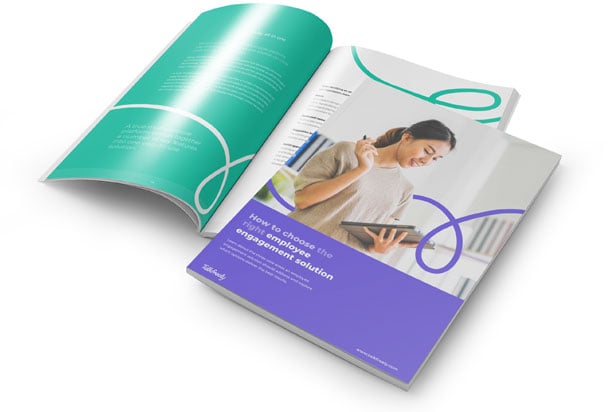
How to choose the right employee engagement solution
Navigating the world of employee engagement solutions can be overwhelming. Download our guide to help you choose the best option for you, your employees and your business.
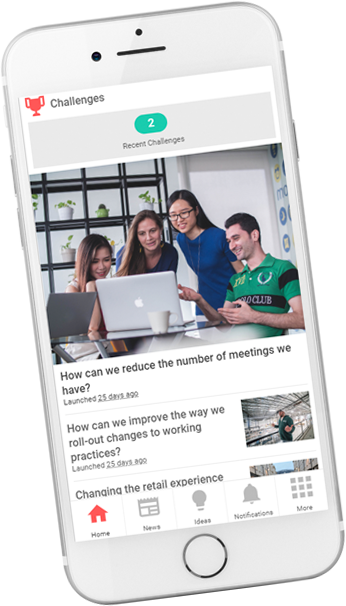
Try Talkfreely for FREE
Explore Talkfreely FREE for 14 days.
Get access to all our employee engagement tools plus support to help you get the most from your trial.
*Trial limited to one trial per person. Each trial will provide unlimited access to all features for 14 days.
Internal communication: everything you need to know.
With so many potential benefits to both employer and employee, this eBook details everything decision-makers and business leaders need to know about internal communication.

Tasked with improving employee engagement
Find out how an employee engagement app can play a pivotal role in delivering an employee engagement strategy.
You might also like...

The Seven Key Internal Communication Trends for 2024

Internal Communications Metrics: Five Steps To Success
- Browse All Articles
- Newsletter Sign-Up
GroupsandTeams →
No results found in working knowledge.
- Were any results found in one of the other content buckets on the left?
- Try removing some search filters.
- Use different search filters.

Want to create or adapt books like this? Learn more about how Pressbooks supports open publishing practices.
Case Study #1
Erika pribanic-smith, department of communication, project description.
My goal was to determine if interventions to improve team cohesion through interpersonal communication would result in better team performance as measured by presentation cohesiveness on the final project. I conducted this assessment in a required course for all majors in the Department of Communication. Initial enrollment for the course was 123 students; four withdrew before the semester ended, and nine additional students stopped attending class but did not drop.
Each semester, students self-select into teams of 6-7 students on the first day of class. Students work in these teams throughout the semester on discussion exercises after lecture, team quizzes, and ultimately, a team presentation. In previous semesters, teams that communicated well with each other delivered excellent presentations, but most delivered the dreaded “patchwork project”; team members independently completed their tasks and then cobbled everything together at the last minute without knowing what others on the team were doing. Furthermore, Student Feedback Surveys indicated that a few students loved the team aspect of the course, but many hated it.
Employing team cohesion literature as well as Decision Emergence and Social Penetration theories, I hypothesized that developing stronger interpersonal ties among teammates via self-disclosure would assist in developing team cohesion, which in turn would motivate students to achieve team goals as a unit and keep each other accountable. I encouraged self-disclosure by developing discussion exercises that required students to come up with examples from their own lives for theoretical application. The disclosures grew more personal over the first half of the semester, starting with “Describe a situation in which you were misunderstood” (General Semantics Theory) and progressing to “Describe a situation in which someone shared your secret or you shared someone else’s” (Communication Privacy Management). A second intervention I employed to improve communication involved guided in-class team meetings, in which I assigned specific tasks related to the presentation assignment and provided instruction on the teamwork behaviors that should be exhibited at that stage of the project.
To measure team cohesion, students completed a team cohesion assessment survey (adapted from a Group Communication textbook’s team cohesion index) at four points during the semester: Week 2, Week 6, Week 10, and Week 14; the index consisted of 20 Likert-scale questions and one open-response question (“Is there anything you’d like to add?”). A Toastmasters list of criteria for group presentation cohesiveness was converted into a rubric for analyzing team performance on the final presentation.
Project Evaluation
Overall, the team cohesion assessment revealed a steady decline in team cohesion from the Week 2 survey to the Week 10 survey, then a spike between the Week 10 and Week 14 surveys. However, the literature recommends assessing team cohesion at both the individual level and the group level, and each level of analysis told a slightly different story in this project. The assessment survey included both individual-level and group-level questions, such that most individual-level questions (e.g., “I identify with the team and its members”) had a group-level counterpart (e.g., “Members of the team identify with the team”). The index of questions that gauged individual team members’ level of connection and commitment to the team demonstrated a relatively even measure of cohesion across the first three surveys with a slight bump in the second survey; the individual-level index rose sharply for the fourth survey. However, the index of questions that asked students to assess their fellow team members’ level of connection and commitment to the team sharply declined from Week 2 to Week 6, stayed nearly the same from Week 6 to Week 10, and then sharply rose by Week 14. In each survey, the individual-level index was higher than the group-level index, though the two indices were closer at Weeks 2 and 14 than in Weeks 6 and 10. (See figure below.)
Significantly, the Week 6 survey coincided with a presentation progress report deadline, and the Week 10 survey occurred around the deadline for teams’ presentation outlines. The open-ended responses at Week 10 in particular indicated that tensions were running high on teams in which students perceived their teammates were not doing their parts to complete the work. The Week 14 survey fell in the middle of presentations, and the overwhelming success of the presentations seems to have generated good will among most of the respondents.
Only one out of the 20 teams failed to score 100 percent on the presentation cohesiveness rubric, for an overall average of 96.4 percent (per Blackboard statistics). Nearly all of the presentations had good flow, consistent visuals (design of each PowerPoint slide), and consistent voice. In most cases, each teammate demonstrated knowledge of what each other teammate was doing. The presentations were tight and well-rehearsed. In short, most teams met the criteria for presentation cohesiveness. However, some went well beyond the Toastmasters criteria. Some teams coordinated their wardrobes; a few even coordinated the size and color of their notecards. Overall, with only one exception, the presentations were engaging and informative. Anecdotally speaking, they were the best presentations I have seen in my seven years teaching theory at UTA. A few even drew enthusiastic ovations from their peers.
Therefore, the class achieved the ultimate goal of cohesive team presentations, and despite dips in the middle, team cohesion was higher at the end of the semester than at the start. I do not believe the self-disclosure intervention affected team cohesion as anticipated, however. Reflections submitted the last week of the semester revealed that several students learned communication is a crucial part of effective teamwork, and some students even indicated that getting to know their teammates made a difference. I think much of that communication and bonding occurred outside of class, though. More significantly, because the team cohesion index increased amid successful presentations, team achievement affected team cohesion more than team cohesion affected team performance. I believe improved communication affected presentation cohesiveness directly rather than affecting team cohesion as a mediating factor .
Though a few students stubbornly insist that teamwork is terrible and they do better work on their own, the end-of-semester reflection responses were overwhelmingly positive, demonstrating that students found the teamwork experience this semester to be not only valuable but also enjoyable. Several students indicated they made close friends or at least expanded their campus network, and some said they loved the class because of their teams. (See responses to the teamwork reflection in Appendix A.)
In sum, I believe the project was successful, not only at improving the team presentations but also at improving most of my students’ ability to work in teams and their view of teamwork in an academic setting.
Despite the successes outlined above, some issues arose that limited the development of team cohesion in some teams and specifically hampered the self-disclosure intervention. These are issues I hope to address in future semesters:
- Several students were absent the first class, and a handful missed the whole first week. Therefore, some students were placed into groups that already had formed and were not able to self-select into teams, and a few of those students were vocal about disliking the teams to which I assigned them. Significantly, the one team that consisted entirely of people who first attended on the second day of class had a disastrous presentation, and direct communication with some of the students on that team revealed they never gelled.
- Attendance throughout the semester became an issue for multiple teams. Based on open-ended survey responses, some students who missed a lot of class did not bond with their teammates as much as students who did attend, and those students also missed a lot of the decision-making and task-planning for the presentation, so they were not as involved or invested in the project as other team members.
- Some teams did not fully and properly engage in the self-disclosure exercises. I eventually discovered that some teams skipped the discussion altogether and just had the person who was providing the real-life example write out the discussion report due at the end of class to save time. Therefore, the members of those teams weren’t learning about each other at all; they just treated the exercise as something they had to turn in for a participation grade. Furthermore, although a different person was supposed to provide an example each time so that everyone was disclosing about themselves, some groups had the same person sharing an example every time.
- Attrition occurred on a handful of teams as some students officially dropped the class or simply stopped coming. Two teams suffered severely; both began the semester with seven members, but one presented with three members at the semester’s end, and another ended the term with only two members. Those few teammates certainly bonded, but their view of the team experience was negative.
Future Direction
Given the general success of this project, I will continue emphasizing communication in future semesters. However, to overcome some of the issues I encountered this semester, I will make a few changes.
- I feel self-selection works great for the most part. However, I will shift team selection to the second day of class to reduce the number of students who are absent at the time of selection and do not get to select their own teams.
- I will monitor the self-disclosure exercises more closely to ensure that teams are a) actually discussing and b) distributing the self-disclosure across team members more evenly. Though it will make attendance record-keeping more difficult and eliminate a valuable check on students’ understanding of the concepts, I will consider doing away with the written report so that students are more focused on the discussion and not just submitting something for a grade.
- I will have more in-class team meetings. We only had three this semester, and they were in the last half-hour of quiz days because I knew most students would be present for the quizzes. Some students stated in their open-ended responses that coordinating schedules outside of class was difficult, though, and they wished we had some full class periods designated for team work. Therefore, I will work some full-class work days into the schedule next time. Deadline stress and failure of teammates to contribute seemed to hamper team cohesion more than anything else, but hopefully having more time to work together in person will increase participation in the project and decrease tension. Doing so in class also will give me more opportunity to guide their communication and teamwork behaviors.
- Some students still will skip class and fail to become a true part of the team or contribute meaningfully to the project. Therefore, I will do more to monitor and alleviate those situations earlier in the semester. Some teams exercised their ability to “fire” team members after the outline, but others didn’t realize or remember that was an option and complained that they presented with teammates who hadn’t contributed to the research and writing. Furthermore, teams only exercised the firing option after the outline was due; none did so earlier in the semester. I believe completing a large component of the project with dead weight increased tension and decreased team cohesion. I will make sure at every checkpoint that students remember they can remove teammates who are not participating in the project, and I will increase the number of peer evaluations students complete to facilitate this process. After they present, students complete a peer evaluation that evaluates each teammates’ cooperation, timeliness of contribution, preparation (research, writing, selecting/producing visuals), and presentation performance. I considered implementing a modified version of that evaluation at each checkpoint but decided against it because I didn’t want students to confuse the peer evaluations with the team cohesion assessments or become overwhelmed with paperwork. I will discontinue the team cohesion assessments, though, and have students complete peer evaluations more frequently instead. These will alert me to issues earlier while encouraging students to think critically about their teammates’ contributions throughout the process and take action as needed. Hopefully issues coming to light sooner will enable me to combine teams that may end up with few members well before the presentation.
Reflection: What is the most important thing you learned about teamwork this semester? (unedited responses)
Be flexible when working with everyone’s schedules
Being ahead of the curve.
being flexible and allowing others to contribute
Coming together in person can make a lot of things a lot simpler as opposed to doing it all online
Communication is the key for a successful team environment.
Communication so the team can adjust to fit everyones’ needs.
Don’t let negativity ruin a good presentation.
Everybody has to work together toward the team’s goals. One person can’t carry the team effectively and if one or more people don’t do their work it make the rest of the team’s jobs much harder and more frustrating. With that said, when people do actually participate it helps to bond those members together and make a better, cohesive, end project.
How to collaborate
How to communicate & get things done on time by planning as a team.
How without fail, working as a team is awful.
I didn’t learn it because I already knew it, but the most important thing I already know is that I work better alone and I still really don’t like group work with random people.
I know now to be here the first day of class, so I can pick my own group members considering I have to pay over a thousand dollars a class.
I learned how to better understand people’s opinions and what they had to say about the issues we were talking about.
I learned that a lot of the time someone on the team will not put in as much effort and will just float along in which the other members will have to carry the extra weight.
I learned that if everyone is on the same page and at least somewhat dedicated to the end goal, the group work will be successful and maybe even enjoyable, which contradicted my previous ideas of group work.
I learned that if you set up expectations for how you want your team to work, it will be more successful.
I learned that most people are not willing to work on teams no matter how old they are or the level of education they have.
I learned that working on big teams is difficult and its important to find meeting times.
I learned that you cannot expect the same amount of effort from each team member, but that oftentimes other members of the team will step up and fill the gaps made. The best strategy for success is to work well with those who demonstrate a willingness to give their time and effort to making the project the best it can be.
If you don’t get to know the people you are in a group with, it makes it hard to work with them.
It definitely takes a lot of work to make your team effective. You must always put in effort to try to restructure your schedule so everyone can meet. You also have to trust and depend on one another.
It is tough to have all team members focus on a task and be organized, especially when we each have much more going on in our lives, but as long as we all communicate well the job can definitely be done. Communication is key, for sure.
Leaders shape the future, and every team needs a strong leader to succeed.
Learning to speak up and state my own opinion even when I’m not entirely confident. Communication and openness is key in order to fully thrive in a group project. I enjoyed my group and the time we spent working together. I consider them my friends.
making new friends 🙂
Making sacrifices to achieve the big picture the team set out to attain.
Most people do things last minuet and you can’t make anyone do anything on your time frame.
Not everyone is going to do their part, but what counts is that the other members have the integrity to step up and cover the people who are slacking.
Organization is important
Planning and communication are key
Sometimes, you gotta pick it up and be leader.
Start the team project ahead of time and not wait until last minute because then you might get some team members that do not contribute.
Teams hold me down and block me from my shine I learned I don’t work well well with others. But the assignment was cool. Groups make my head hurt
that communication is very important
That everyone needs to do their part to make the team run smoothly. Also, communication is key.
That google docs saves lives. It is very easy for everyone to be working on the same slides at once and that automatically save once you stop typing so nothing gets lost.
That some people are disrespectful. I also learned that others are extremely respectful. Projects definitely can’t be pushed back to the last minute. I also learned that understanding concepts after a lesson were much easier to understand working in a group because we were able to apply them to things we knew in real life.
That time is a key concept in getting things done in the time allotted, giving us the opportunity to finish our work thoroughly to where we have time to go over it a second time.
That time managing is essential to being prepared.
That we all have busy lives and we all work differently but we all trusted each other and that we would get all of our parts done, not micro manage each other and it would all workout.
The important thing I learn is that communication is one of the most important things to make a team successful. We kicked a few people out of our team because they did not execute their role as agreed. Once they were notified they were kicked out they were offended because the rest of the team did not understand their personal life situations, nonetheless, they never spoke about the problems they had at all to maybe find an alternate way as a team to complete each task as we had agreed to. We could not help them at the end nor feel empathic because they were not communicating with us how they said they were. Everyone was open about their situations they had going on outside of class, either school related, work or even personal but those people never did. They would agree to everything and say they would do it but at the end they did not and we did not feel compassionate about it because they never once did communicate anything about the possible encounters they could have or had been facing.
The longer we worked together the more stuff we had in common and accomplished our goals.
The most important thing I learned about being on a team is that unplanned circumstances happen and you have to be ready for them.
The most important thing I learned about working in a team is that sometimes, you can’t count on everyone to keep their word.
The most important thing I learned about working with a team this semester was planning and working around difficult schedules, improvising to get the job done.
The most important thing I learned from working in a team, was mostly time management and working together to achieve the same goal. Our theory had a lot to do with how our team functioned so it was nice to incorporate the two together.
The most important thing I learned on this team is that its best to not be last minute about things but to be ahead of things.
The most important thing I learned this semester about working in a team is how busy schedules can impact your plans. This led to working even harder in finding the best solution, where sometimes it meant dividing up who meets up on one day and who the other, with some meeting both days. Figuring out schedules can be the most daunting task but it can easily have a solution if you begin making a plan.
The work gets done when everyone is involved!
Things move better when you work together
This has been one of my favorite classes yet and I am thrilled to have gotten to meet every member in my group. I personally believe we will all never forget each other.
This semester i learned that even in a college setting where everyone is here to learn and get a good grade you may still encounter other that don’t play well. Sometimes it takes someone to be the bigger person and groom the team to just understand that we are all here just to get the job done.
To be more assertive in all aspects of my life.
To listen more than anything because there are so many things to learn and value about one another. We all come different places but somehow we all ended up in the same group! I love my team!!
To make sure that I am available to the team and to organize my time around the team’s schedule so as to make sure we get everything done.
to properly plan and create timetables for the group assignment.
We’re all different and unique, but yet we all think as one, all have the same mindset in order to reach our goal for this semester.
When everyone puts out and carries their own responsibilities like they should, the team can take ideas and form them into what we need, be it for an assignment or anything else.
Working in a big team is difficult but if at least most of the members coordinate to work towards the same goal then the team can create a fantastic piece of work.
Working in a team requires a lot of organization and patience. Now that we are in college, we all have different schedules and sometimes is hard to contact each member of the group however it’s not impossible. I have seen many people with busy schedules and still made the effort to contribute to the team. I have learn that we must be willing to work hard, have patience, and organization in order to have a strong contributing team. I am glad this class requires to grade our members because in that way I can show the great or minimal effort that each member did on the project.
You have to be willingly to sacrifice your schedule in order to work effectively with a team.
You need to be patient with people, but you can’t be a pushover.
Teamwork: An Open Access Practical Guide - Instructor Companion Copyright © 2020 by Andrew M. Clark and Justin T. Dellinger is licensed under a Creative Commons Attribution-NonCommercial-ShareAlike 4.0 International License , except where otherwise noted.
Share This Book
- SUGGESTED TOPICS
- The Magazine
- Newsletters
- Managing Yourself
- Managing Teams
- Work-life Balance
- The Big Idea
- Data & Visuals
- Reading Lists
- Case Selections
- HBR Learning
- Topic Feeds
- Account Settings
- Email Preferences
Business communication
- Business management
- Managing yourself
Swimming in Data? Three Benefits of Visualization
- John Sviokla
- December 04, 2009
Encourage Foreign-Born Employees to Participate More in Meetings
- Andy Molinsky
- January 30, 2014

Research: Amplifying Your Colleagues' Voices Benefits Everyone
- Kristin Bain
- Tamar A Kreps
- Nathan L Meikle
- Elizabeth R Tenney
- June 17, 2021
How to Reverse a Mistake in the Middle of It
- Peter Bregman
- December 08, 2009
Power Failure in Management Circuits
- Rosabeth Moss Kanter
- From the July 1979 Issue
Which Behaviors Must Leaders Avoid?
- Muriel Maignan Wilkins
- May 28, 2013
Stop Mixing Business with Pleasure
- Jodi Glickman
- March 22, 2011
Managers Can Drive Their Subordinates Mad
- Manfred F. R. Kets de Vries

Structure Your Presentation Like a Story
- Nancy Duarte
- October 31, 2012
What Time of Day Are You Most Charismatic?
- Cristiano Guarana
- Christopher M. Barnes
- December 02, 2021

The Problem with Saying “My Door Is Always Open”
- Megan Reitz
- John Higgins
- March 09, 2017

Conquer Your Self-Doubt in Meetings
- Sabina Nawaz
- June 21, 2021
How Presidents Persuade
- David Gergen
- Gardiner Morse
- From the January 2003 Issue

Why Criticism Is Good for Creativity
- Roberto Verganti
- July 16, 2019

What Are Your KPIs Really Measuring?
- Graham Kenny
- September 14, 2020
How to Survive a Direct Attack
- Jerry Weissman
- July 13, 2011

How To Moderate a Panel Like a Pro
- Scott Kirsner
- May 30, 2013

No, Remote Employees Aren't Becoming Less Engaged
- Andrew Brodsky
- Mike Tolliver
- December 06, 2022

Meetings: When to Present and When to Converse
- March 24, 2015

Salespeople, Stop Worrying About Being Liked
- March 22, 2019

Slighting Urgency: A Cross-Cultural Reexamination of the Crash of Avianca Flight 052
- Christine Pearson
- August 01, 2019
- Michael Hattersley
- September 19, 1991
Breaking the Silence at Work (A): Taboo Topics
- Kanina Blanchard
- Alison Konrad
- Karen MacMillan
- October 14, 2021
Tingvong Homestay: The First Homestay in Dzongu
- Agnitra Das Sarma
- Rakesh Gupta
- August 31, 2021
The Canons of Rhetoric
- Brian Moriarty
- March 16, 2018
AT&T: Managing Technological Change and the Future of Telephone Operators in the 20th Century
- Daniel P. Gross
- William R. Kerr
- January 05, 2018
What Went Wrong with Boeing's 737 Max?
- William W. George
- Amram Migdal
- June 28, 2020

HBR 20-Minute Manager Boxed Set (10 Books) (HBR 20-Minute Manager Series)
- Harvard Business Review
- May 05, 2015
Pitcher Perfect: Visualizing Interactive Beer Profiles
- Anthony Palomba
- December 18, 2022
Twenty Five Questions to Ask as You Begin to Develop a New Case Study
- Mary Gentile
- August 13, 1990
Leadership Voice and Style
Mini usa: finding a new advertising agency (a).
- David B. Godes
- December 07, 2007
NBA Biometric Data: Privacy vs. Performance
- Scott F. Johnson
- February 08, 2017
Maternal and Child Health in Uttar Pradesh, India: A Mother's Story
- Claire Donovan
- Julie Rosenberg
- Rebecca Weintraub
- February 01, 2018
Managing Workplace Diversity: Alex (A)
- Havovi Joshi
- January 12, 2016
YourStory: Strategically Communicating Entrepreneurial Journeys
- Atul Arun Pathak
- Sunil Kumar Sarangi
- September 22, 2017
Prestige Telephone Co.
- William J. Bruns Jr.
- May 22, 1997
Making Target the Target: Boycotts and Corporate Political Activity
- Nien-he Hsieh
- April 12, 2017
Jamie Turner at MLI, Inc.
- John J. Gabarro
- Colleen Kaftan
- February 09, 2011
A Public Relations Campaign for Rwanda
- July 23, 2014

The Rise and Fall of Carlos Ghosn: Part 2
- William Sposato
- Hans Greimel
- Curt Nickisch
- June 10, 2021
The Video-Streaming Wars in 2019: Can Disney Catch Netflix?, Teaching Note
- Anita Elberse
- June 10, 2020
David's Bridal: Customer Relationship Management in the Digital Age (TN)
- Kimberly A Whitler
- Paul W. Farris
- Virginia Weiler
- November 24, 2015
Popular Topics
Partner center.
5 Internal Communication Case Studies and Best Practices To Follow
Alex Cleary
Apr 6, 2022
Internal Communications
From employee engagement to workplace culture to change management, businesses often face similar challenges to each other even if those businesses are radically different. While the specifics of these challenges may differ, how other businesses solve these challenges can give you new insights into addressing your own.
We’re always interested in how our customers use ContactMonkey to solve their internal communications challenges, which is why we publish customer case studies. Learn how other businesses solve their communication challenges and get inspiration on ways you can improve your business by using an internal communications tool .
Improve your internal communications today.
Create and track internal messages with ContactMonkey.

What is an Internal Communication Case Study?
An internal communication case study examines how a company addressed a specific problem facing their organization, or achieved a specific goal. Communication is crucial for every business, and communication challenges can manifest in all kinds of situations.
An effective internal communication case study will clearly outline the problem, solution, and result of the business’ efforts to reach their goal. An internal communication case study should also outline best practices that were developed in this process, and how those best practices serve the business going forward.
Why are internal communication case studies important?
A good internal communication case study should not only explain the circumstances around a specific business’ problems and solution. It should also help others develop new ways to approach their own internal communication challenges , and shed light on common communication pitfalls that face a majority of businesses.
Whenever you’re facing a particular communication problem at your workplace, we recommend searching out a relevant internal communication case study about businesses facing similar issues. Even though the particulars may be different, it’s always important to see how internal communications problems are solved .
Featured Resource: Internal Email Benchmark Report 2023
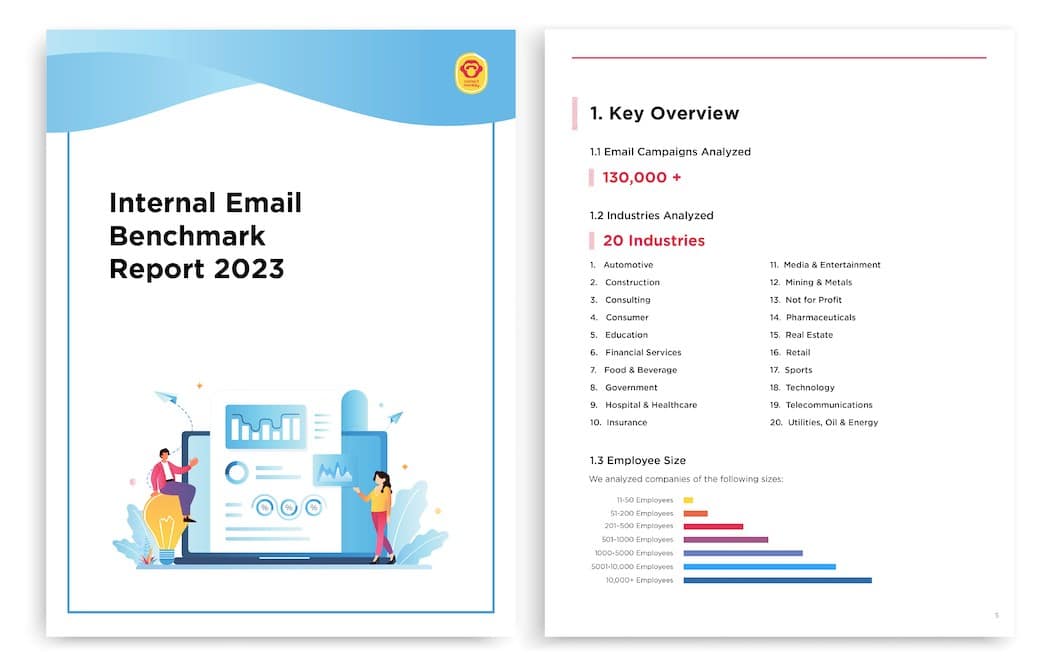
How do your internal email performance metrics compare to 20 key industries?
5 Best Internal Communications Case Studies
We put together this list of our favourite ContactMonkey case studies that best demonstrate the many problems our internal communications software can be used to solve. If you want to learn more about any of these customers and see other case studies, check out our Customers page .
Create engaging internal emails today.
Start a 14-day trial. No credit card is necessary. Zero risk.
1. Mettler Toledo Saves Days on their Internal Communications with ContactMonkey
When Kate Kraley began as Mettler Toledo’s Marketing Communications Specialist, she wanted to use internal communications to increase engagement and improve communication with employees.
But Mettler Toledo —a global manufacturer of precision instruments for various industries—had a confusing and ineffective array of internal communications channels . Here’s how Kate took charge of internal communications at Mettler Toledo with ContactMonkey.
Kate came to an internal communications department tasked with reaching employees through a number of channels. Email was the main focus of their approach, but this encompassed many forms of communication based on email like employee newsletters, eNews, and quarterly email updates.
Kate wanted to improve the quality of their internal communications. She used a variety of tools to create their newsletters, including using Mailchimp and online HTML template builder. But because Mailchimp is not for internal communications , Kate and her team found themselves spending over 8 hours a week building their internal communications:
“We faced challenges with Mailchimp. Since we had to leave Outlook to use Mailchimp, we found it was double the work to maintain distribution lists in both Outlook and Mailchimp. The HTML builder in Mailchimp was also difficult to use as it didn’t work well with older versions of Outlook, compromising the layout.”
Kate also needed a way to determine whether Mettler Toledo employees were actually reading her internal communications. She used Mailchimp to track open rate, but wanted more in-depth measures of engagement. That’s when she switched to ContactMonkey.
Kate found ContactMonkey via the IABC Hub in 2018, and began testing it out. ContactMonkey’s all-in-one internal communications software removed the need to switch from tool to tool. Using our email template builder , Kate now builds visually stunning email newsletters and templates without having to navigate away from Outlook:
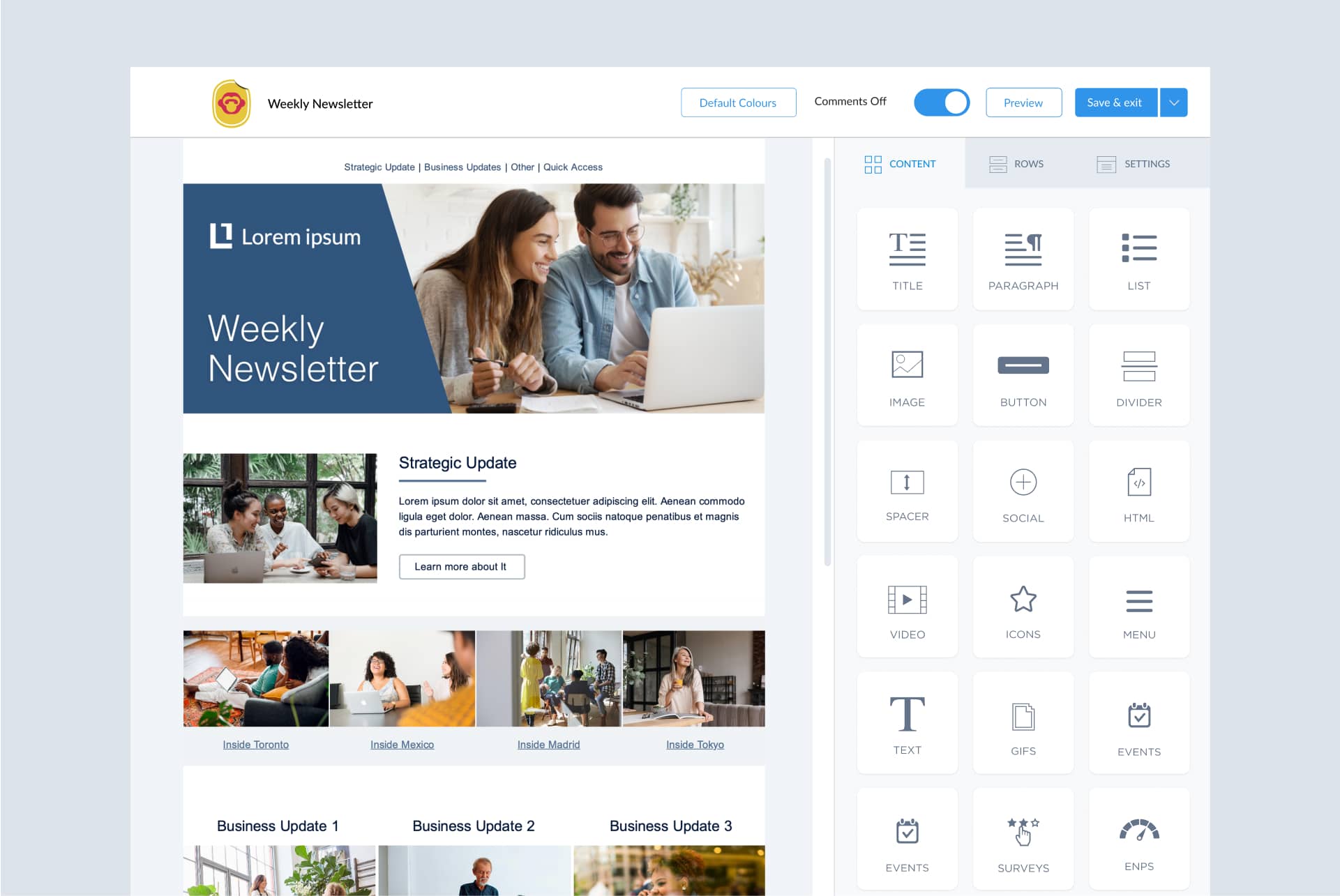
She also now has access to her own analytics dashboard . Kate analyzes numerous email metrics like open rate, click-through rate, read time, opens by device and location, and more to see which communications are driving the most engagement. With this new centralized approach, Kate knew she had found the right solution:
“Once I started using ContactMonkey, I realized I was able to save 4 hours of work a week, which translated to 25 days saved per year! ContactMonkey has helped us understand what employees are interested in!”
Save time with ContactMonkey
Build and send professional emails in minutes, not hours.
2. BASF Manages Their Remote Workforce with ContactMonkey
Mark Kaplan is the Global Communications Manager at BASF’s Agricultural Group —a department of the German chemical company BASF SE. Because BASF has offices and production sites around the world, Mark coordinates with other internal communicators across the company to drive employee engagement.
With the success of any business comes new challenges, and BASF isn’t any different. While Mark knew he had to keep others informed of the latest news from the BASF Agricultural Group, he was aware employees would be receiving news from other parts of the company as well.
With many different departments sending their own internal communications, Mark faced a difficult task: keeping employees engaged while being careful not to overwhelm them with countless emails and updates.
“We try to be very strategic with what we’re sending out because people are already getting a lot.”
Not only did Mark have to find a solution that made his email communications more engaging, but he also had to prove the value of whatever solution he chose to management. How could Mark show that he was increasing employee engagement while avoiding tuning out from oversaturation?
Mark began using ContactMonkey to create better internal communications for BASF employees. Using our drag-and-drop email template builder, he designs emails that maximized communication and minimized distractions, keeping information to just what his recipients needed to know.
Mark uses ContactMonkey’s email template library to save time on his email design process. He also uses the easy drag-and-drop format of the email template builder to add multimedia into his email communications to save space and increase their effectiveness:
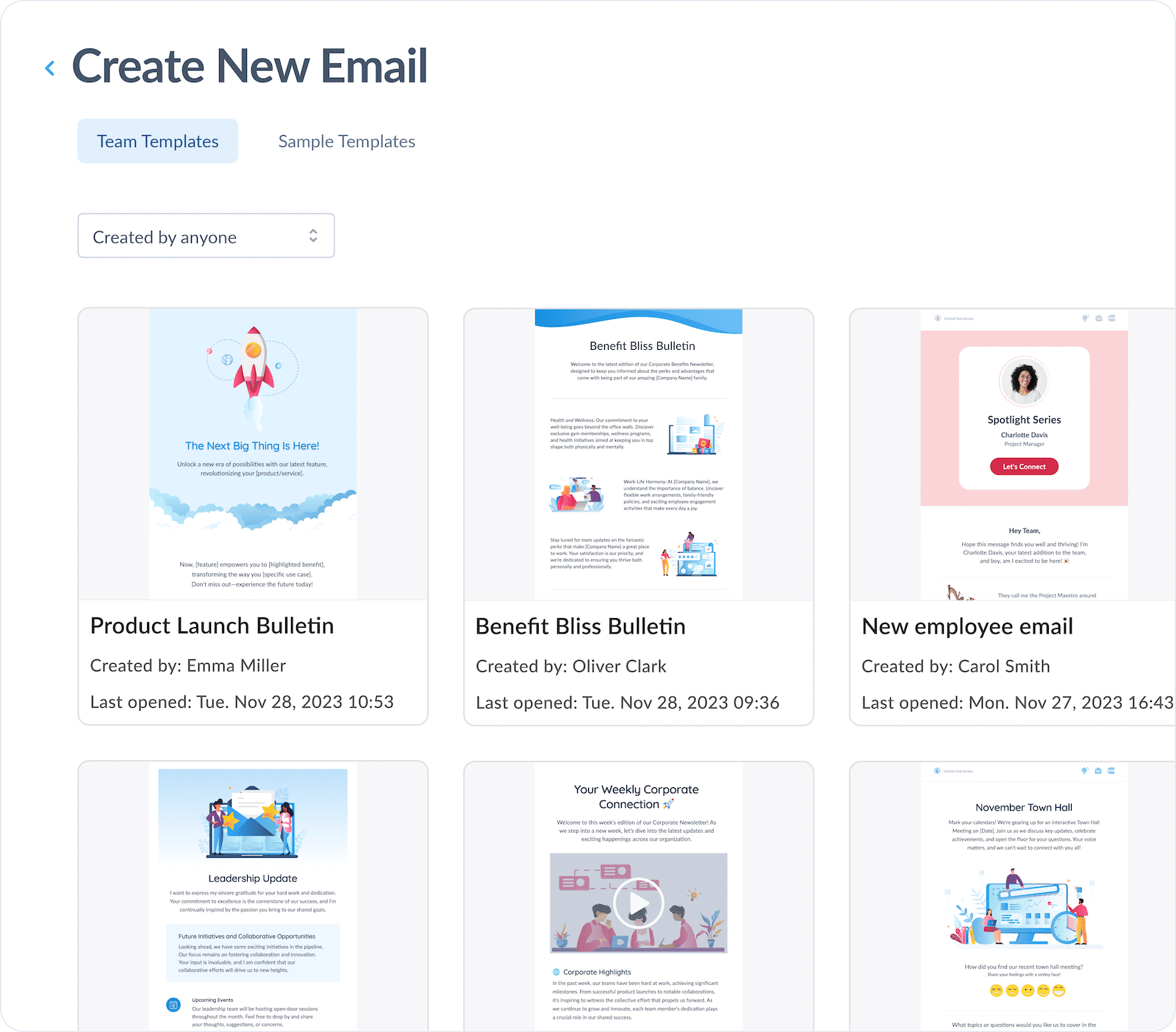
Mark uses the email analytics provided by ContactMonkey to determine the best times to send internal emails . Not only does email analytics help Mark increase engagement on his employee emails, but he now has hard data he can show management to prove the value of his internal communications.
“ContactMonkey has been great in that I can download a report, attach it to an email, and send it to our top leadership and say, ‘Oh, wow. 88% of the organization opened this in the last 24 hours, I think we should do more of this.’ It’s that little extra credibility.”
Build professional emails with ContactMonkey
Access beautiful email templates out of the box.
3. Alnylam Drives Remote Employee Engagement Using ContactMonkey
Employee engagement is crucial for ongoing productivity and growth, and Alnylam’s Brendon Pires wanted to leverage their internal communications to increase engagement.
Brendon is an internal communications specialist at Alnylam —the world’s leading RNAi therapeutics company—and is tasked with keeping their 2000+ employees engaged and informed. But Brendon’s existing internal communications process was leading to issues all over the place.
Like many companies, Alnylam shifted to remote work when the COVID-19 pandemic hit. Brendon knew that employees would be relying on his emails to stay up-to-date on the latest company news and announcements, but their existing internal communications tool wasn’t up to the task:
- Scheduled emails were prevented from being sent out.
- Email design was a chore with a difficult-to-use email builder.
- Intranet traffic was down and Brendon’s emails weren’t driving traffic to it.
- Email tracking was limited as many internal emails were being flagged by their tracking software’s firewall.
“We were having consistent issues and it had been going on for like a couple of months. It was one issue after the other, between emails not sending because they were getting caught in our firewall, and then tracking not being consistent. So at the end of the day it was kind of like that’s really important, you know? Obviously if I can’t send that email that’s a problem. So that’s what really drove us to look at other solutions like ContactMonkey”
Brendon and Alnylam use Outlook for their employee emails, so he began looking for alternatives to his current software. That’s when Brendon found ContactMonkey.
Right away Brendon had a much easier time creating internal emails using our email template builder. He can create stellar internal emails and email templates that drive more engagement.
Brendon also uses ContactMonkey’s embedded star ratings to let Alnylam employees rate the emails they’re receiving. This helps Brendon and his team zero-in on their most engaging email content. He also uses our email analytics to measure engagement via open rate and click-through rate. He maximizes his results on these metrics by using ContactMonkey’s scheduled email sending:
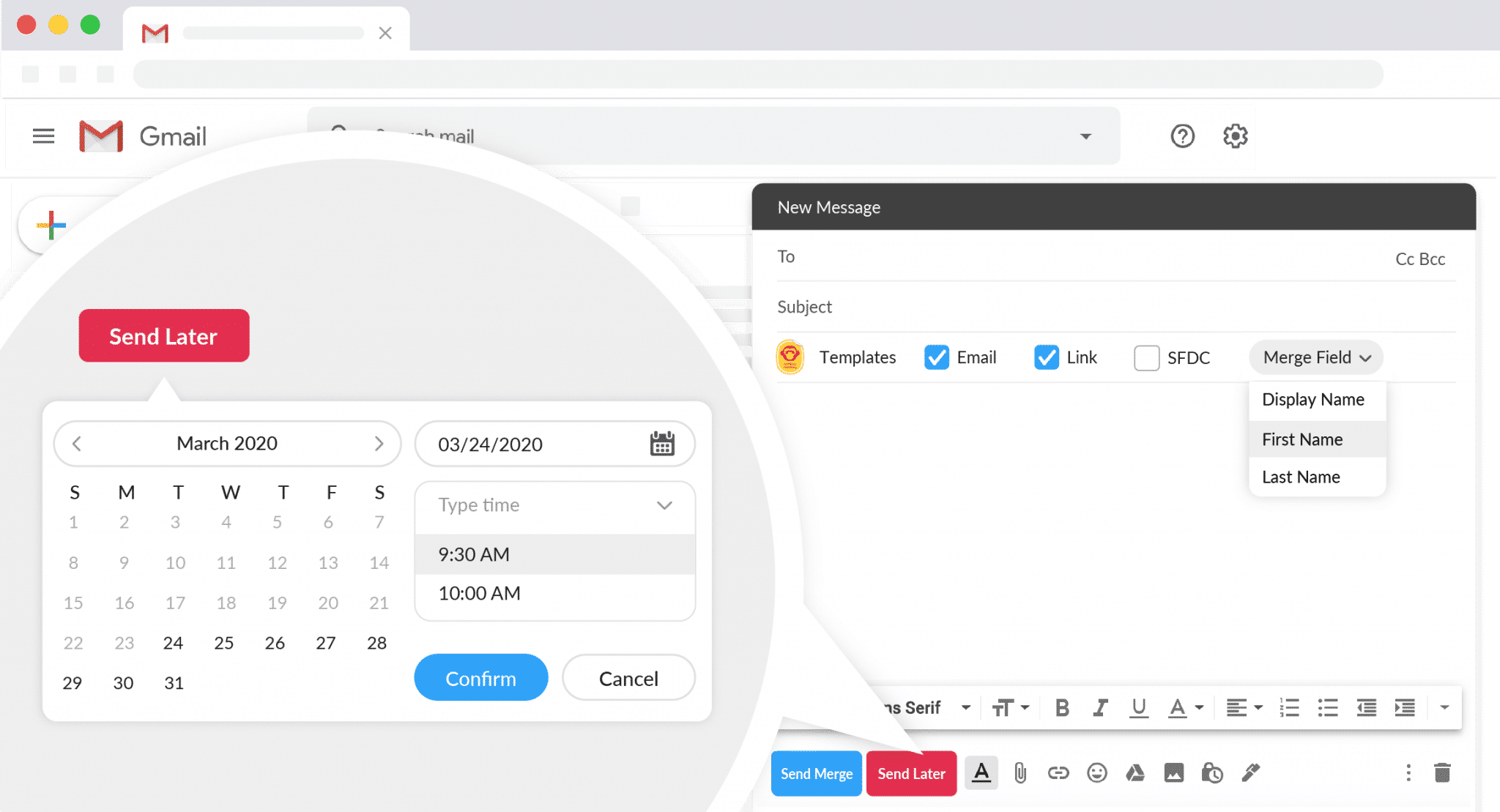
Using ContactMonkey, Brendon was able to increase email engagement and drive traffic to Alnylam’s internal intranet . He now sends emails without worry of encountering sending errors that can hinder engagement—like Outlook not rendering HTML emails .
“ContactMonkey is really easy to use and allows me to create really nice content. There’s enough customization so we can do what we really want and have some creative freedom.”
4. Travel Counsellors Ltd. Stays Connected with Remote Employees Using ContactMonkey
In an economy deeply impacted by COVID-19, countless companies had to adapt to new challenges. As Community Manager at Travel Counsellors , Dave Purcell experienced firsthand the effects on morale and engagement his over 1,900 partners experienced as result of the quarantine and resulting societal changes.
Dave wanted to regularly check-in on Travel Counsellors franchisees’ wellbeing, and measure their engagement over time. But Dave’s current method of checking-in on an audience of over 1,900 was not up to the task.
Using their existing email software, Dave encountered all sorts of problems when trying to gauge wellness and drive email engagement. He and his team were unable to create personalized internal communications , as they were told it just wasn’t possible with their existing “solution”. They also experienced numerous tracking issues, as they were receiving tracking numbers that didn’t make any sense.
“The stats we had previously were unusable and that’s the easiest way I can put it. I was getting 200% open rates, which was just impossible.”
Realizing that email tracking and personalization were must-have features for him and his team, Dave sought a new email software that could deliver what he was looking for.
With the aim of sending personalized emails and tracking wellness in his organization, Dave was immediately impressed by ContactMonkey. “I stumbled across ContactMonkey, and everything just screamed: ‘This is the right platform for us’. It’s pretty fantastic.”
Dave uses ContactMonkey’s merge tags to create personalized subject lines and body copy based on the recipient:
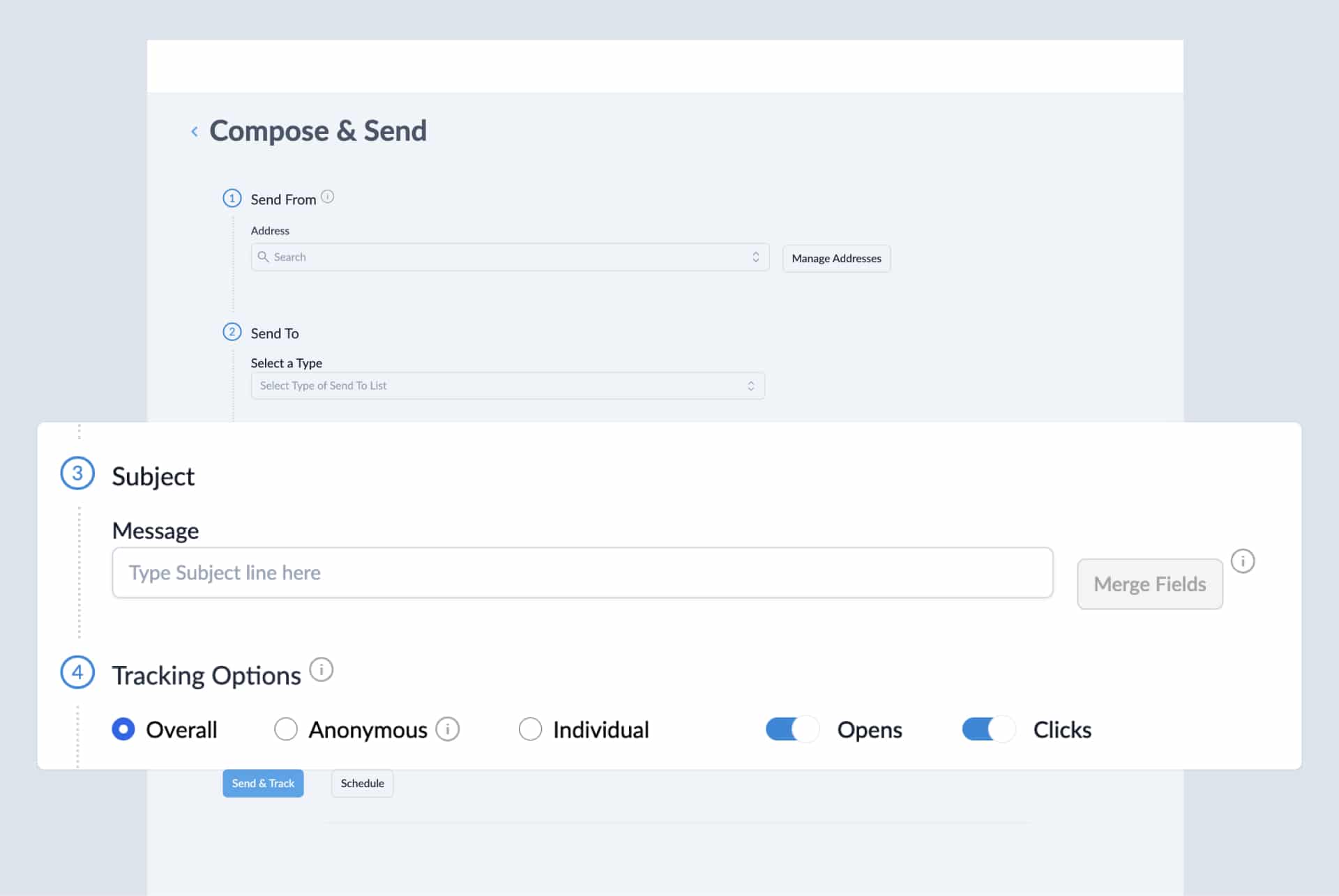
He also began using emoji reactions on his weekly employee newsletters , using them as a pulse check survey for his audience.
“Mindset and wellbeing have always been a big part of what we do. It’s even more so now. Our franchisees craved that personal interaction. ‘Welcome to a Brand New Week’ checks in with them on a Monday, sees how they’re feeling with emoji reactions. And we do the same on a Friday.”
In addition to customization and surveys, Dave uses our email template builder’s custom employer branding options to save time on creating his email newsletters. All of this is driven by email analytics that help Dave and his team determine which content is generating the greatest engagement.
“Our commercial team is looking at what people are engaging with in terms of link clicks and what they’re not engaging with and changing our tactic depending on that. We also send an update from our CEO and we can now track this more accurately. We’re getting a 90% open rate within two days.”
Capture your team’s attention
Use ContactMonkey AI assistant to write captivating copy.
5. Exemplis Boosts Internal Communications Engagement with ContactMonkey
When Corey Kachigan arrived at Exemplis as Engagement and Communications Lead, she knew she had her work cut out for her. Exemplis—the largest volume manufacturer of office seating in North America—was experiencing rapid growth but did not have any sort of internal communications strategy . Corey knew if she wanted to properly manage Exemplis’ ongoing growth, she’d need to make internal communications an indispensable part of the business.
Before Corey arrived, Exemplis’ existing internal communications consisted only of random announcements and update emails. They had no defined approach for sending internal communications, which lead to emails that can cause employees to tune out.
“Our receptionist would email: ‘Hey, whoever left their coffee mug in the sink, please clean it and take it back to your desk.’ And it’s like, okay, that just went to 200 people.”
Corey and her team knew they had to harness their email resources better, and wanted a way to measure what employees actually wanted to see.
“We need some metrics to gauge whether this is working or not. We’re rolling out all these things, but we can’t tell if employees are even clicking these emails. Our team is inundated with hundreds of emails a day. How do we know they are reading these and how do we know they find it valuable? We have no idea.”
They also wanted to use emails to align their ever-growing employee base with Exemplis’ core values and vision. Using Mailchimp—an external marketing email tool—resulted in more problems than solutions. Corey experienced issues with importing and tracking emails within Outlook. She realized that Mailchimp is not for internal communications , and set out to find a new solution to power her employee emails.
So Corey began searching for a new email software for internal communications. Creating a definite approach to internal communications was just one priority of hers; she also wanted to prove the value of internal communications to management using hard data.
What first stood out to Corey about ContactMonkey was the crisp layout and that it worked with Exemplis’ existing Outlook system. ContactMonkey uses your company’s existing email services, and this meant Corey would no longer encounter internal email problems caused by an external tool like Mailchimp.
Corey now uses email metrics and employee feedback to inform her internal communications approach. She features pulse surveys on her internal emails, and uses the results in combination with email metrics to pinpoint what Exemplis employees want to see.
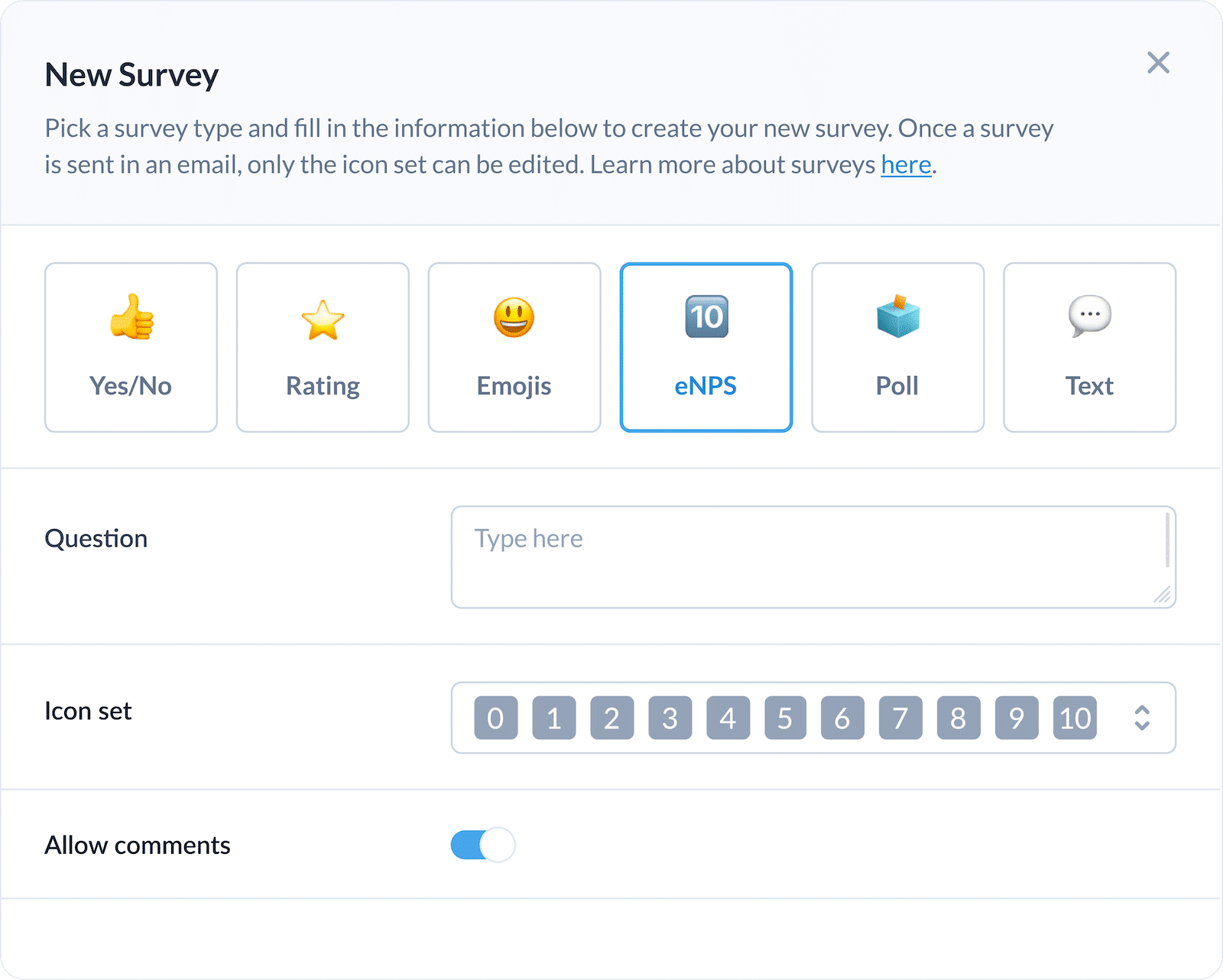
With ContactMonkey’s email analytics, Corey can point to real engagement data to back up her internal communications objectives.
“The thing I love about ContactMonkey is that it allows us to communicate more consistently with our team, but also be able to have the data to back it up. When we used to send out newsletters, we didn’t really have a way to see who did or didn’t open it, who clicked what and they couldn’t interact with the communication besides reply to me, which was super cumbersome.”
Boost employee engagement
Start gathering team feedback today.
Achieve Your Internal Communications Goals with ContactMonkey
Although internal communications is a common aspect of all businesses, everyone approaches it differently. Finding out the best email practices that work for your employees is a crucial step in the quest for increased engagement.
Read even one internal communication case study and you’ll see how ContactMonkey stands out among other internal communications tools. You can create, send, and track internal emails, and collect employee feedback and email metrics to develop innovative internal communication tactics . Whether you’re a seasoned internal communicator or new to the field, ContactMonkey can turn your internal communications into a powerful driver of productivity and growth at your organization.
Discover the power of modern internal comms tools.
See the benefits of ContactMonkey in about 15 minutes.
Want to see ContactMonkey in action? Book a free demo to see how our internal communications software can transform your employee emails:
Revamp your workplace comms with us, right from your inbox. Get started now!
Email Template Builder
Outlook Sending
Email Analytics
Integrations
SMS Communications
Customer Stories
Free Templates
Attend Live Demo
Help Center
[Webinar Alert] Employee Retention Playbook: Tree Top’s Journey to 20% Improvement
The Complete Guide to Effective Team Communication

Let’s break down what team communication actually means. According to Merriam-Webster, communication is “a process by which information is exchanged between individuals through a common system of symbols, signs, or behavior.” In other words, it’s an exchange of information.
Download our white paper on creating an effective internal communication strategy for more in-depth insights.
A team is a group of people “associated in work or activity.”
Putting the two together, team communication should be the exchange of information within a group of colleagues working towards a common goal .
Sounds pretty straightforward, right?
It is. But there’s also the potential for team communication to become mis communication instead. Just because there’s an exchange of information doesn’t mean it’s always done effectively .
Miscommunication can:
- Lead team members to make assumptions and expectations based on wrong information
- Create closed loops and make some team members feel left out
- Lead to conflict about how information should be perceived/interpreted
Group communication becomes a lot more complex when you have so many opportunities for it to fail. We’ll be looking at ways to improve team communication later, but first, it’s important to understand why we want to improve communication in the first place.
Why Improving Team Communication Matters
Ask any manager if they’d like to improve group communication and team productivity and they’ll likely say: of course.
Who wouldn’t want their team to stay connected and avoid misunderstandings?
After all, improving team communication can have a ripple effect across all aspects of your business.
Good team communication has several benefits:
1. Identify and Resolve Conflicts Early On
Many internal communication problems within big corporations start as simple miscommunications or misunderstandings that become problems because they’re not dealt with early enough.
Maybe managers give vague requests and employees are afraid to speak up. Or, maybe employees simply aren’t well informed on what the company’s goals are. Tasks may get delayed or employees might feel disconnected from their roles.
Healthy communication means that both managers and employees can detect these issues early and solve them before they escalate.
2. Improve Employee Engagement
An engaged employee is one that enjoys their job and wants to offer value to the company they work for. A dis engaged employee is not invested in their job and tends to do the bare minimum to keep it.
But why do employees become disengaged? Many times, it’s because of poor internal communication within the company. They may be disengaged because leadership is doing a poor job of communicating company goals. Or, they may feel like their feedback isn’t valued or noticed.
Employee engagement starts with improving team communication. If managers can encourage dialogue with their team, they can uncover why some employees may feel disengaged.
3. Encourage Bottom-Up Communication in Team Interactions
What exactly is bottom-up internal communication ? It’s an approach in which employees at all levels within an organization contribute their feedback and ideas. It focuses on building communication channels that cross traditional hierarchies. That way, the information doesn’t just trickle down from leadership. It flows in both directions, and it gives frontline employees the opportunity to submit their ideas and requests.
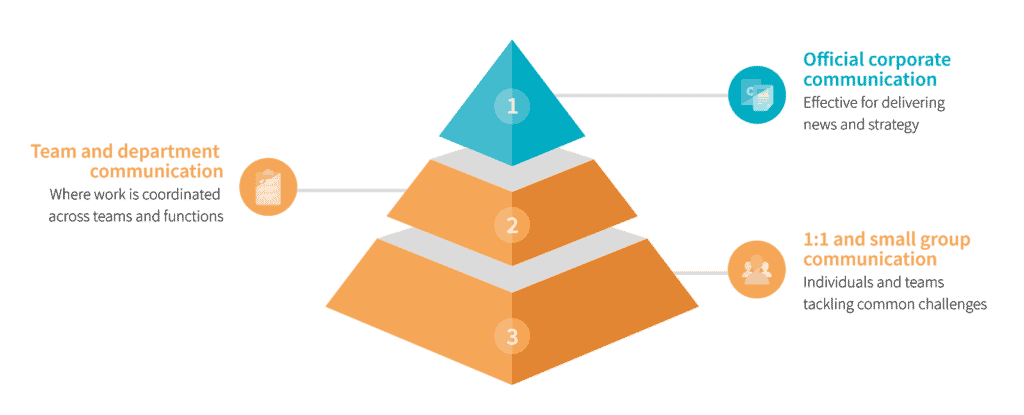
Team communication isn’t a one-way street. When companies invest in improving team communication, they’re also opening up opportunities for bottom-up internal communication. They’re giving employees the tools to contribute their feedback and know that it will have an impact on company-wide decisions.
4. Build a Transparent Company Culture
When employees think that there is a lack of transparency and open communication in their work environment, they’re more likely to look for opportunities elsewhere (or, at the very least feel frustrated and burnt out).
Rigid hierarchies that restrict what information gets delivered to employees have no place in a transparent company culture . By improving team communication, companies can encourage open dialogue that breaks down those barriers between hierarchies .
Ultimately, transparent company culture supported by communication in team interactions creates trust between leadership and employees. Investing in the employee experience with tools that help employees stay connected and engaged is the first step in creating transparent company culture.
How Does Effective Team Communication Work?
There’s no one-size-fits-all when it comes to effective communication in a team. What counts as “good” team communication is more about managing different communication styles than following one particular strategy.
The first step to improving team communication is understanding the different ways people communicate effectively in the workplace.
These workplace communication styles can include:
1. Analytical
Those with analytical communication styles like data and detail. They want their decision-making to be backed up by concrete facts and figures rather than emotion-based arguments. Logical reasoning sways them far more than emotional appeal.
Because they tend to take emotion out of the equation when communicating, analytical communicators can sometimes seem detached. But they thrive in a transparent work environment where they can have access to as much detail as possible and they are able to see where data comes from.
Giving feedback for analytical types works best when it’s supported by numbers and figures rather than vague value judgments.
2. Intuitive
On the opposite side of the spectrum, those with an intuitive communication style take a big-picture approach and don’t like to focus on the nitty-gritty details when getting their point across.
People with this effective communication style are most likely to contribute creative solutions and think outside the box. They might not appreciate details and numbers like an analytical type would. Instead, they want to hear the “why” behind a project and how it fits into a greater strategy.
3. Personal
Those with a personal communication style are often seen as diplomatic and good at both spotting and resolving conflicts. They approach communication through the lens of emotion and personal connection and they’re good at picking up on non-verbal communication.
Because they excel in one-on-one interactions, they might struggle with working remotely, especially as more companies embrace WFH policies due to COVID-19. Strong team communication becomes particularly important in keeping them motivated and engaged while working remotely.
Leading with data isn’t going to sway a personal communicator as much as an emotional connection. Like the intuitive communicator, they’re more responsive when they know the “why” behind a project. In their case, it’s a more personal “why.”
4. Functional
Closer to the analytical communicator than the intuitive or personal one, the functional communicator loves a detailed, step-by-step plan. If anyone on your team goes into “what-if” mode often, they’re likely a functional communicator.
They want to know all the details about a project so they can troubleshoot anything that might go wrong. When they hear about a new idea, they want to know exactly how it’s going to be executed.
Functional communicators may seem like a killjoy to an intuitive thinker, who would be more likely to get excited about the big-picture implications. But people with this communication style are often the practical backbone of any team.
How to Improve Team Communications
Which one of the communication styles mentioned above resonates with you the most? What about the people you work with?
Understanding different team communication styles in the workplace can help us share information, collaborate more effectively, and improve team productivity. If we know that our colleague is an analytical type, we can come prepared with data. If a co-worker is more intuitive, we can focus on the big picture to get our point across.
Every team has its own unique dynamic. But what about how to improve communication on a company-wide level?
That’s where pairing a team communication tool with an internal communication strategy comes into play.
Improving team communications starts with choosing the right tools. And as more people are working remotely, companies rely on digital tools to help their workforce stay connected.
Here are a few tips on choosing and integrating team communication tools:
1. Rethink Your Current Communication Model
Switching to an entirely different communication tool or set of tools can seem daunting, particularly for companies with a lot of employees. How do you know if everyone will embrace the new tool? How can you be sure that the adoption process won’t slow down communication?
But even if employees are comfortable with using a certain tool, that doesn’t mean it’s ideally suited to how they work. While phone calls and email are perhaps the most basic way to communicate effectively in the workplace, some industries don’t benefit from going that route.
For frontline workers, email is not the best solution, given that they are almost always on the go and have limited opportunities to sit down and check their email. Choosing a frontline success platform like Beekeeper is a better option because it’s designed specifically for frontline workers. With Beekeeper, workers can get instant updates about shift schedules and safety information on their mobile devices without the need for an email address.
If your current team communication model doesn’t align with the reality of how employees actually work, it might be time to rethink the tools you’re using and search for a better solution.
2. Create and Distribute Communication Guidelines
Setting clear expectations for how you want employees to communicate effectively can seem awkward at first. Telling people how they should talk to each other can sound like you’re micromanaging your team.
But creating guidelines around communication skills in a team can help to prevent misunderstandings and make adopting a new tool a more seamless process. For example, specifying how often you expect team members to check into their team app can prevent them from worrying that they will miss an important update.
Or, if you’ve implemented a communication tool that facilitates file sharing, specify that it should be used for all client files. Otherwise, there may be confusion when employees try to send files by email instead.
3. Listen to Employee Feedback
Gathering and analyzing employee feedback can often fall lower on the priority list. But making time to get feedback is key to improving team communication.
This is especially true for remote or distributed teams. Because managers and workers are often not in the same location, managers can’t be expected to know the ins and outs of how their team communicates and any struggles they may be facing. Feedback can come in the form of employee surveys , where you can ask questions focused on team communication:
- Do you feel like the tools you have allow you to stay informed about company updates?
- Are you comfortable communicating freely with colleagues and managers?
- Are there any expectations around communicating that you’re unsure about?
By getting feedback from employees, companies can adjust their team communication strategies to make it more effective, whether that means getting new tools or clarifying communication guidelines.
Best Practices for Cross-Team Communication
Teams don’t work in a vacuum. Cross-team communication involves people with different backgrounds and communication skills sets coming together to solve a problem or achieve a shared goal. Achieving company-wide goals and healthy communication will likely require the expertise of people from different departments.
But there’s a lot that can go wrong in cross-team communication:
- People who aren’t used to team collaboration don’t know about the different communication styles of the people they’re working with.
- Deadlines might not allow enough time to develop team dynamics.
- To avoid ruffling any feathers, people can hold back some of their potentially innovative ideas and opinions.
Some best practices for improving cross-team communication:
Eliminate Siloes
The HBR study found that one of the main reasons why cross-functional teams fail was because of self-perpetuating siloes. Perceptions about how teams work together fuel how they communicate. And if those perceptions are negative, establishing team communication is an uphill battle.
“Designers and engineers don’t work well together” is a typical example. If teams go into working together with that idea, they’re already off to a bad start.
Celebrating cross-team collaboration wins on a company app is one way to break down these siloes and show that teams with different backgrounds can work together effectively.
Make Accountability Crystal Clear for Communication in a Team
One of the simplest reasons why cross-team communication fails is that people miss meetings. They prioritize their own team’s tasks over the tasks that make up a cross-team project. They just don’t show up.
That’s usually because cross-functional teams don’t have a clear accountability leader or hierarchy that oversees all aspects of a team collaboration project.
Assigning someone the responsibility to check that all members of a cross-functional team are actively involved can keep projects from getting delayed. And specifying who has the last word in making decisions can keep projects on track.
Establish Goals and Objectives Early On
Defining goals and establishing what success looks like might seem tedious or unnecessary for every project. But when adhering to specifications and staying aligned with company goals are two of the major pitfalls for cross-functional teams, it might be worth taking the time to do so.
One of the best practices of operational excellence is outlining broad goals as well as specific KPIs that will measure success. That way, team members can anticipate any conflicting priorities that would potentially prevent them from participating in a cross-functional team.
By having clearly-defined goals, objectives, deadlines, and resources before a cross-functional team begins working on a project, companies can avoid being part of the dysfunctional 75%.
Want even more info on creating an effective team communication strategy in your company? Download our white paper to learn about setting goals, conducting analyses, and identifying the right communication targets.
Most frequently asked questions.
Good communication enables to identify and resolve conflicts early and to improve employee engagement. In addition, it encourages bottom-up internal communication and can build a transparent company culture.
Related Article

Don’t miss out on the latest from Beekeeper. Get our newsletter.
- Book a demo
- Try for free
By industries
Consultancy
Architecture & Engineering
Software & IT
Event Management
Operations Manager
Project Manager
Financial Manager
Team Member
Project Management
Quoting & Budgeting
Sales & CRM
Resource Planning
Time Tracking
Reporting & Dashboard
Cost Management
Collaboration
Integrations
Guides & E-books
4-Day Work Week
Success Stories
Webinars & Events
Help Center

Webinar: Revenue Forecasting for a Profitable Year Ahead
Watch the on-demand webinar and uncover practical tips on reliable Revenue Forecasting.

7 Stories That Prove The Importance of Teamwork

TEAMWORK SKILLS are important in every field of business. A good team enables you to be productive both as a group and as an individual. Today’s teams are different from the teams of the past. They’re more dispersed, digital, and diverse. But while collectives face new challenges, their success still depends on a core set of fundamentals that make a team a good team.
A study by Uri Hasses, a professor at the Princeton Neuroscience Institute, revealed surprising brain activity in audiences who engaged with stories. “Not only did all of the listeners show similar brain activity during the story, but the speaker and the listeners also had very similar brain activity despite the fact that one person was producing language and the others were comprehending it,” said Hasses.
Storytelling can be a driver of employee performance, making them feel, think, and respond like the characters in the story.
Here are seven inspirational stories emphasizing the importance of teamwork – in the workplace or personal life.
1. After years of intensive analysis, Google discovers the key to good teamwork
In the last decade, Google has spent millions of dollars on measuring nearly every aspect of its employees’ lives – from which traits the best managers share to how often particular people eat together. The tech giant was determined to find out how to compile ‘the perfect team’.
The company’s executives worked hard on finding the perfect mix of individuals necessary to form a stellar team. They believed that building good teams meant combining the best people. But it wasn’t that simple.
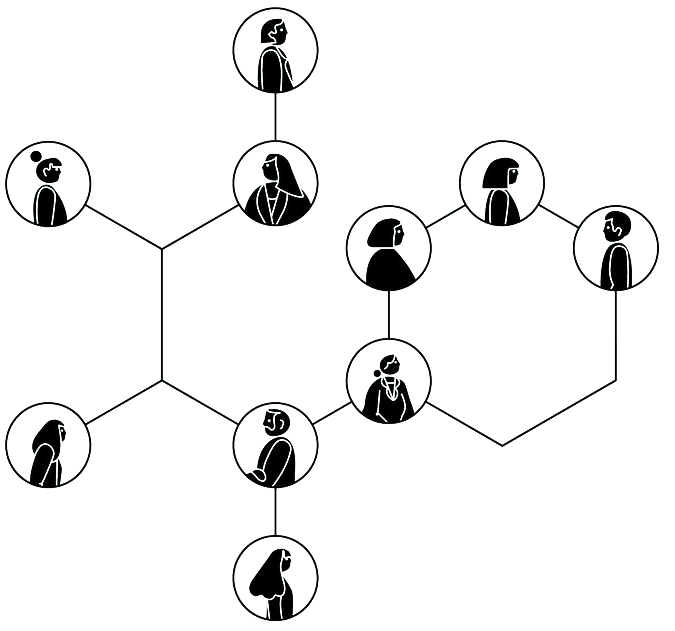
Image source
In 2012 Google ran a project known as Project Aristotle . It took several years and included interviews with hundreds of employees. They analyzed data about the people on more than 100 active teams at the company.
“We looked at 180 teams from all over the company. We had lots of data, but there was nothing showing that a mix of specific personality types or skills or backgrounds made any difference. The ‘who’ part of the equation didn’t seem to matter.’’ – Abeer Dubey , a manager in Google’s People Analytics division
Google’s intense data collection led to the same conclusions that good managers have always known: In the best teams, members show sensitivity, and most importantly, listen to one another.
Matt Sakaguchi, a mid-level manager at Google, was keen to put Project Aristotle’s findings into practice. He took his team off-site to open up about his cancer diagnosis. Although initially silent, his colleagues then began sharing their own personal stories.
At the heart of Sakaguchi’s strategy, and Google’s findings is the concept of “ psychological safety ” – a shared belief that the team is safe for interpersonal risk-taking.
Google now describes psychological safety as the most important factor in building a successful team.
Google ended up highlighting what leaders in the business world have known for a while: the best teams are mindful that all members should contribute to the conversation equally , and respect one another’s emotions . It has less to do with who is in a team, and more with how the members interact with one another.
Everything about your business, one click away
2. four seasons & a fresh croissant.
Steve Wynn, the founder of Wynn Resort & Casino, shared a story of his family’s vacation in Paris. They were staying at Four Seasons and had ordered breakfast in bed. His daughter only ate a half of a croissant, leaving the other half for later. Wynn and his family left to explore Paris, and upon returning to the hotel room, the pastry was gone. His daughter was disappointed, assuming the housekeeping had got rid of it.
On the telephone, there was a message from the front desk. They said that housekeeping had removed the half croissant from the room, assuming that upon arrival, they would prefer a fresh pastry. So the front desk contacted the kitchen to set aside a croissant, and room service was informed that upon request, they would need to deliver the pastry.
The level of teamwork and communication between different departments in the hotel was simply magical. All participants understood the end result – customer satisfaction. And everyone accepted their role in making the experience fantastic.
It shows that in order to achieve satisfaction on different levels within the organization, employees should be empowered to be creative, intuitive, thorough, and generous.
Read on: The Unexpected Benefits Of Team Management Software
3. Steve Jobs: “Technology alone is not enough.”
In 1986, shortly after he was forced out of Apple, Steve Jobs bought a small computer manufacturer named (drumroll) Pixar.
In 2000, he relocated the company to an abandoned Del Monte canning factory. The original plan called for three buildings, with separate offices for computer scientists, animators, and the Pixar executives. Jobs immediately scrapped it. Instead of three buildings, there was going to be a single vast space, with an atrium at its center.
“The philosophy behind this design is that it’s good to put the most important function at the heart of the building. Well, what’s our most important function? It’s the interaction of our employees. That’s why Steve put a big empty space there. He wanted to create an open area for people to always be talking to each other.” – Ed Catmull , the president of Pixar.
But for Jobs, it was not just about creating a space: he needed to make people go there. The primary challenge for Pixar, as he saw it, was getting its different cultures to work together and collaborate.
John Lasseter, the chief creative officer at Pixar, describes the equation this way: “Technology inspires art, and art challenges the technology.”
Jobs saw separated offices as a design problem. He began with shifting the mailboxes to the atrium. He then moved the meeting rooms, the cafeteria, the coffee bar, and the gift shop to the center of the building.
Brad Bird, the director of “The Incredibles” and “Ratatouille,” said, “The atrium initially might seem like a waste of space. But Steve realized that when people run into each other when they make eye contact, things happen.”
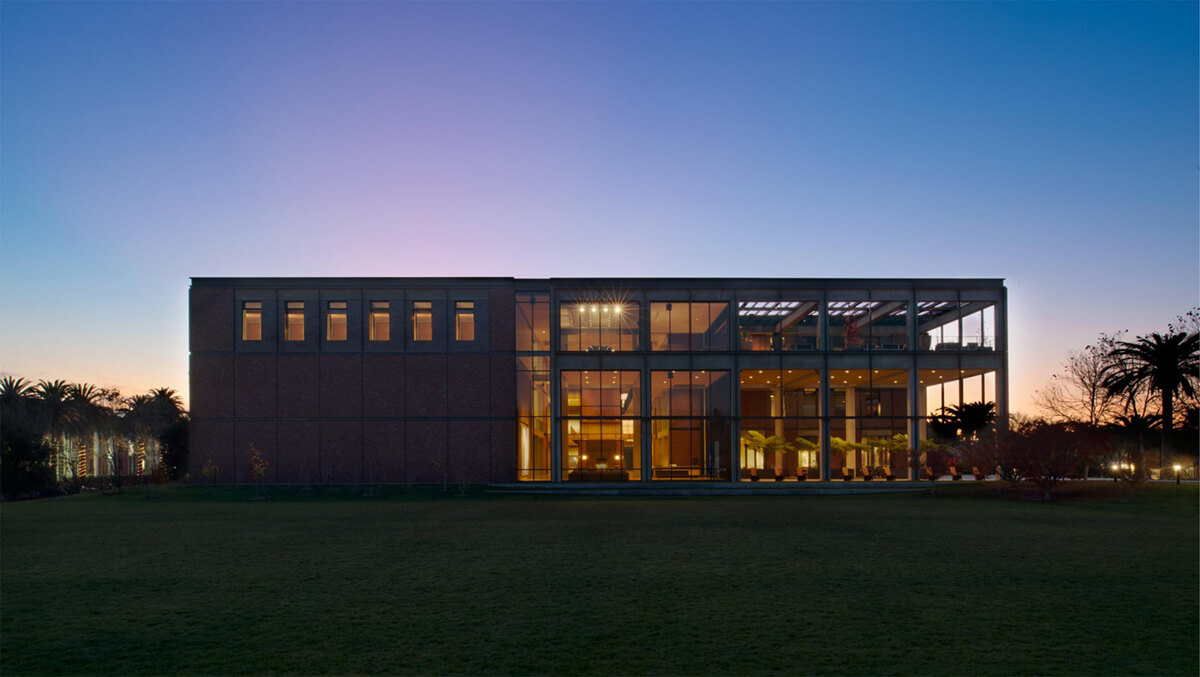
Even if it came at the expense of convenience, the emphasis on consilience has always been a defining trait of Steve Jobs. Jobs insisted that the best creations occurred when people from disparate fields were connected, especially in an age of intellectual fragmentation.
The Latin crest of Pixar University says it all: Alienus Non-Diutius. Alone no longer.
Read on: Infographic: Why Your Teamwork Isn’t Working
4. A rolling stone gathers no moss
Mick Jagger, Charlie Watts, Keith Richards, and Ronnie Wood – The Rolling Stones – have played together for more than 50 years. However, they still recognize the importance of practicing together.
They understand that for excellence to become a habit, you need to define a shared approach to working together. You need to practice it over and over until it becomes second nature.
Before every tour, the band typically commits two months to rehearsing . They appreciate the opportunity to reconnect with their collective rhythm. The practice enables the band to perform with almost telepathic communication.
Richards says that he knows exactly what’s happening by simply watching Watts’ left hand. If the tempo ever drags, one glance from Richards to Wood speaks volumes. Together they will then step up the pace.
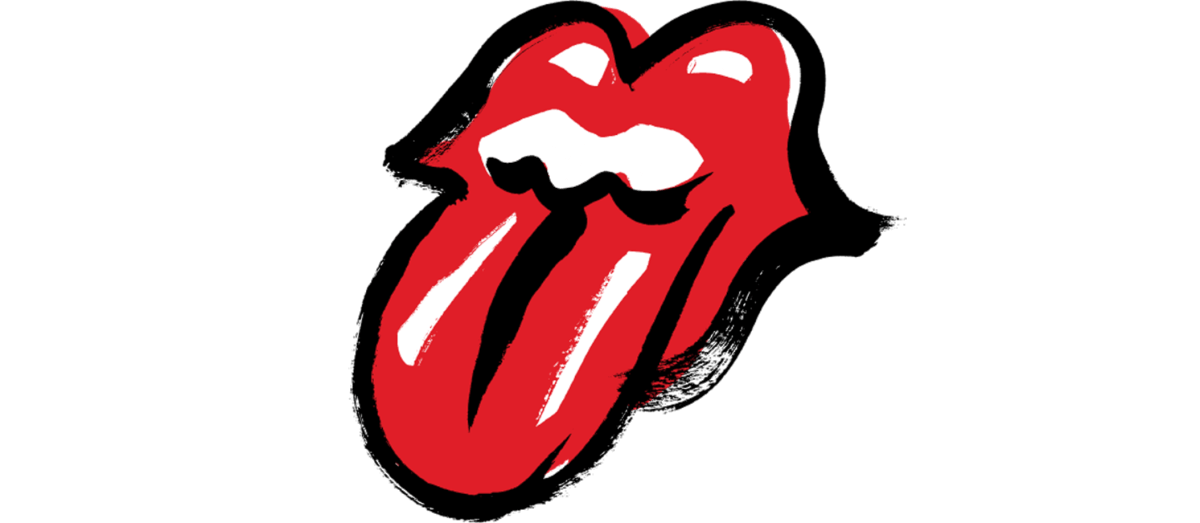
Image Source
The Stones’ success comes from each member having a distinctive yet complementary role . Richards is their spiritual leader, Watts the band’s backbone, Wood the mediator, and Jagger is in control of everything he can be – a chief executive in many ways.
Each of the band’s members is a talent in his own right, but it is the chemistry the band has on each of them that works best. Being part of the Rolling Stones remains the best way for each member to achieve their individual goals. The best teams are those who combine individual drive with understanding the importance and power of the team.
This is the secret to becoming an excellent team: There is no substitute for the ongoing commitment and deliberate practice required to build better teams.
Read on: 11 Phenomenal Company Cultures With Key Takeaways
5. Red Cross
A clear and motivating purpose is essential to attracting the right talent.
During the devastating Haiti earthquake of January 2010, the British Red Cross immediately went into action . They gathered thousands of workers, from volunteers to frontline disaster specialists, who would be mobilized into a community of purpose. The common factor among those people: they did great work, and they did it together. It didn’t matter whether they were on the ground in Haiti or at charity shops across the high streets of the UK.
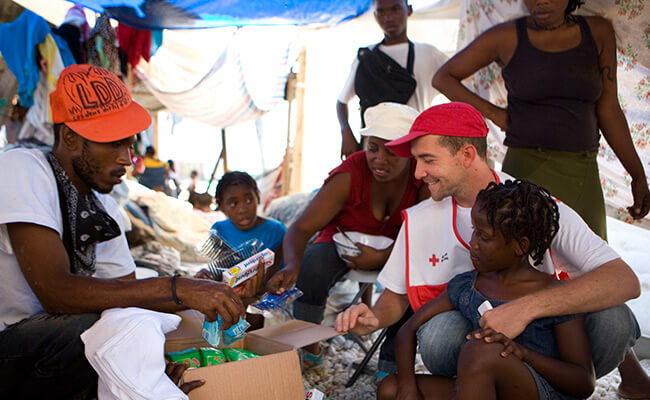
For most teams, there won’t be such an innate crisis to respond to, but there should still always be a sense of meaning in their work. For a team’s purpose to be potent, it needs to be compelling to its members. You need to inspire your team, connect the team’s work to an exciting, meaningful outcome, with a result that everyone finds personally worthwhile.
Read more: Software To Increase Your Team Productivity
6. ONE is better than one
Marvel’s The Avengers, featuring Iron Man, Captain America, the Hulk, and Thor is not just inspiring for comics fans. There’s a huge lesson about teamwork you might not have paid attention to. Not just teamwork – but the value of teams themselves.

The Avengers’ lesson is that ONE is better than one , meaning that one team is better than one person. It is universally different from five people versus one person. A group of five can probably accomplish more than one person alone, but it’s when those five people work together as a team when the magic happens.
The hard part is making those five individuals put their egos aside, trust each other, and act as a team. Captain America and Iron Man have a pretty different view of the world, and compromise doesn’t come easy. But they respect and trust one another despite their disagreements, and they can see the value the other brings to the table. The abandonment of ego is what allows you to become part of a whole that is greater than the sum of its parts.
When you’re part of a team, a truly cohesive unit that functions with a single purpose, you can accomplish wonders.
Read on: What Makes a Great Company Culture? Interview With Scoro’s People Operations Manager – Kadri Mäe
7. Who’s packing your parachute?
This last story proving the importance of teamwork is about a US jet fighter pilot in Vietnam – Charles Plumb . He had completed 75 combat missions when he was shot down. Plumb was ejected and parachuted into enemy hands, where he spent six years in a Vietnamese prison.
One day, a man came up to him and said, “You’re Plumb! You flew jet fighters in Vietnam from the aircraft carrier Kitty Hawk. You were shot down!”
Plumb was confused and asked how the man knew about that. “I packed your parachute,” the man replied.
The man then shook his hand and said, “I guess it worked!” Plumb assured him it had and said, “If your chute hadn’t worked, I wouldn’t be here today.”
Plumb thought a lot about that man who held the fate of someone he did not even know, in his hands. He kept pondering how many times he might have seen the guy, and not even said anything because he was a fighter pilot and the stranger was just a sailor.”
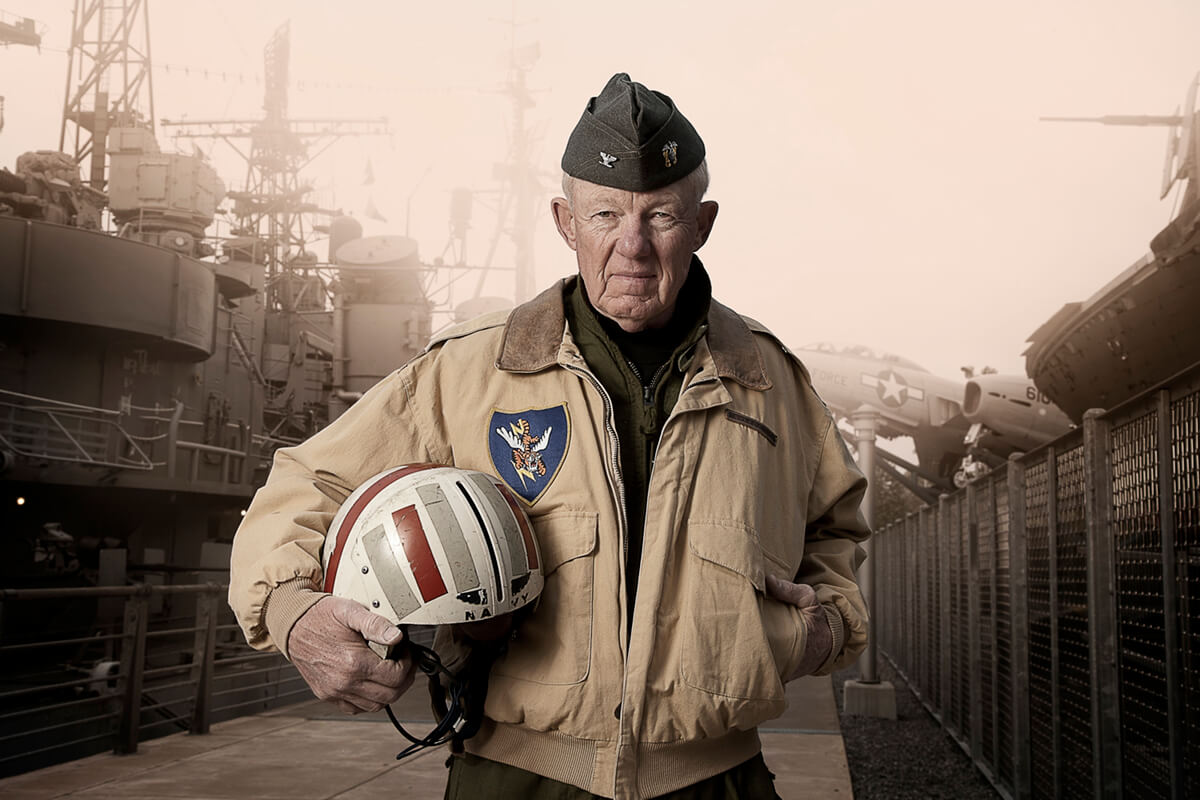
Charles Plumb is now a motivational speaker telling this story to hundreds. After telling it, he always asks his audiences, “Who’s packing your parachute?”
In our life, be it personal or work related, many people have a hand in our parachutes. Are you taking the time to acknowledge, thank, and reward them? It is very easy to overlook the work of many. It takes a lot of people to create a team.
Us versus them
Although teams are facing an increasingly complicated set of challenges, it’s the essentials that set the tone for successful teamwork – trust, collaboration, hard work, appreciation, purpose, agility, and creativity.
Modern teams are vulnerable to a corrosive problem – the “us versus them” thinking. Overcoming this requires a critical condition: a shared mindset.
Hopefully, these stories inspired you and helped to see teamwork from a new angle. Share them with your team, and learn from these lessons together.
Recommended articles
5 best agency time tracking software, 11 best project management tools for teams of all sizes, 5 best project budgeting software.
See how Scoro can help deliver projects and improve your profitability.
Start a free trial
Tour the product and try Scoro for free for 14 days, no credit card required.
Get started today!
Get a 14-day free trial and see how Scoro can work for your business.
Session 2. Teamwork and Communication in Health Care

Chapter 6. Case-Based Learning
At a glance, instructor’s guide.
Overview for instructors. The purpose of this didactic session is to introduce students to the concepts of interprofessional education and collaborative practice. Instructors will use two case studies to highlight the specific teamwork and communication skills individuals need to work effectively on an interprofessional health care team. Each case study uses little to no medical or dental terminology to embed oral health. As a result, this session is ideal for pre-licensure health sciences students with no clinical training.
Materials provided in this toolkit.
- Pre- and Post-Session Assessment Questionnaire
- Instructor’s Copy, Case Study: Jill
- Instructor’s Copy, Case Study: Mr. Jones
- Case Study: Jill
- Case Study: Mr. Jones
Instructor Preparation.
- Download slides 30–34 and the accompanying speaker notes from Smiles for Life Course 1: The Relationship of Oral to Systemic Health
Note: You must register as an educator before you can download individual slides and speaker notes. Slide numbers viewed through the web interface for Smiles for Life differ from the numbers on the downloaded slides. Slide numbers in this toolkit correspond to slides in the third edition of Smiles for Life in their downloaded format.
- Ask a faculty member from each of the participating programs to locate or draft a short description of the roles and responsibilities for his or her respective profession. Compile these descriptions into one Word document and make it available to your students through email, your preferred learning management system, or your website.
- Pre-Session Assignment: Teamwork and Communication in Health Care
Note : The survey portion of the Pre- and Post-Session Assessment Questionnaire is taken from the TeamSTEPPS ® Teamwork Attitudes Questionnaire , which looks at five core components of teamwork. TeamSTEPPS was developed jointly by the Department of Defense and the Agency for Healthcare Research and Quality to improve the quality and safety of patient care. To learn more about the system, which includes a full curriculum and other resources, visit TeamSTEPPS .
- Complete the Pre- and Post-Session Assignment: Teamwork and Communication in Health Care .
- Review the roles and responsibilities document provided by the instructor.
- Pre-assessment (2–5 minutes)
- Introduction (5 minutes)
- Discussion of the pre-session assignment (10 minutes)
- Smiles for Life Course 1: The Relationship of Oral to Systemic Health PowerPoint slides 30–34 (10 minutes)
- Case study for Jill (10 minutes)
- Case study for Mr. Jones (10 minutes)
- Wrap-up (5 minutes)
- Post-assessment (2–5 minutes)
Instructor’s Notes
This session will take approximately one hour, depending on the number of participants.
Pre-assessment (2–5 minutes). Ask students to complete the pre-session portion of the Pre- and Post-Session Assessment Questionnaire as they arrive.
Introduction (5 minutes). Review the learning objectives and purpose of the session. Ask students to identify themselves by hand as you note the professions represented in class. Then, ask a student volunteer from each profession to read the roles and responsibilities for his or her profession aloud.
Discussion of pre-session assignment (10 minutes). The purpose of this assignment is to provide students with a real-world example of substandard health care delivery.
Ask student volunteers to share their answers to the questions in the Pre-Session Assignment: Teamwork and Communication in Health Care . Use the following notes to enhance discussion for each question.
- The purpose of this question is to prompt students to think about their personal experiences with teamwork. Allow a few students to share their answers.
- The purpose of this question is to prompt students to identify specific examples of effective or ineffective teamwork.
- This question should prompt students to reflect on the consequences of poor health care delivery (i.e., what happens when teamwork, collaboration, and good communication are absent).
- This question asks students to contemplate what went wrong with Deamonte’s health care delivery.
If necessary, guide students toward an understanding of the ways better communication and teamwork could have resulted in the more timely care needed to save Deamonte’s life.
Smiles for Life Course 1: The Relationship of Oral to Systemic Health PowerPoint slides 30–34 (10 minutes). This portion of Smiles for Life Course 1: The Relationship of Oral to Systemic Health introduces the concepts of interprofessional education and collaborative practice. Take time to read the definition of each and point out that the purpose of this didactic session is to prepare students for collaborative practice.
Case study for Jill (10 minutes). Break students into interprofessional teams of five or six. If possible, place one student from each profession on each team.
Instruct students to read Jill’s case study silently, then answer the questions as a team. One student should take notes and be prepared to discuss the team’s answers.
Use the following notes to enhance discussion generated by the questions.
- Yes. Although Jill’s school nurse could have taken action earlier, the dentist, physician, and school nurse communicated in a positive manner that reflects collaborative practice.
- Yes. All U.S. states and territories have laws that mandate the reporting of suspected abuse by specified individuals. These typically include physicians, nurses, and other health professionals. The need to be alert to nonmedical issues also highlights a potentially overlooked aspect of patient-centered care delivery. All health care providers should be concerned about a patient’s overall health and wellbeing, including those conditions whose treatment extends beyond the provider’s training.
- Jill’s health care team exhibited effective communication, mutual respect, and concern for comprehensive care.
- The physician addressed Jill’s oral health concerns and provided a dental referral. This illustrates patient-centered, comprehensive care.
- The dentist followed up with Jill’s physician and also consulted with her school nurse. This illustrates effective communication and collaboration.
- Participate in interprofessional education opportunities such as this one.
- Learn about the roles and responsibilities of other health care providers.
- Contact local health care providers once in practice to facilitate collaboration.
Case study for Mr. Jones (10 minutes).
Option 1 Ask students to form new teams with at least one person from each profession present on each team. Teams should designate one person to take notes and report on team findings. After the students have formed teams, direct them to read the case study for Mr. Jones silently, then answer the questions as a team.
Option 2 Ask students to remain with their present teams but designate a new person to take notes and report findings. Direct students to read the case study for Mr. Jones silently, then answer the questions as a team.
- The primary care provider (PCP) prescribed oral medication—a poor choice for patients with difficulty swallowing—and failed to refer Mr. Jones to a dentist for further evaluation.
- The speech language pathologist (SLP) did not perform an adequate oral examination, even after noticing Mr. Jones’s bad breath and food accumulation.
- The pharmacist filled the prescription for oral antibiotics in pill form without questioning the patient’s ability to swallow, even though the pharmacist recognized his facial paralysis and difficulty speaking.
- Mr. Jones’s health care team members did not communicate or collaborate with one another regarding his health care delivery.
- The PCP could have spoken to the SLP over the phone and explained that he prescribed Mr. Jones antibiotics and pain medication for an infected tooth. This may have prompted the SLP to point out the need for liquid antibiotics to ensure patient compliance. It may also have prompted the SLP to follow up with Mr. Jones regarding his oral condition at his appointment.
- Even without a call from the PCP, the SLP could have performed a comprehensive oral examination as part of Mr. Jones’s appointment and noted the infected tooth, which should have prompted an immediate dental referral.
- The pharmacist could have questioned Mr. Jones about his facial paralysis and ability to swallow. This would have prompted a change in prescription from pill to liquid form, enabling Mr. Jones to take the oral antibiotics more easily.
- Yes, the PCP could have referred Mr. Jones to a dental provider when the oral antibiotics were prescribed.
- Yes, cost and unnecessary pain and stress for the patient.
Wrap-up (5 minutes).
To facilitate a wrap-up discussion, ask students the following questions.
- Did working with students from other professions highlight aspects of health care delivery that you had not considered before?
- How will you apply what you learned today about teamwork and communication in health care to your education and in practice?
To close the session, summarize the following points for your students.
- Patient-centered health care requires all health care providers to communicate and collaborate effectively.
- A lack of communication and teamwork has been shown to negatively impact patient health outcomes.
- Patient health and safety is at risk when health care providers do not work together.
Post-assessment (2–5 minutes). Ask students to complete the post-session portion of the Pre- and Post-Session Assessment Questionnaire before they leave. Impress upon them the value of their feedback in helping you hone the session for future students.
< Previous Page: Session 1. Team-Based Care
First Published: 10/2015 Last updated: 03/2016
Next Page: Chapter 6 Resources >

Case Studies: Successes and Failures in Interdisciplinary Teams
Discover the dynamic world of interdisciplinary teams in healthcare as we delve into a compelling collection of case studies. Successes and failures will be examined, providing valuable insights into the power of collaboration and the challenges that may arise.
From hospitals to primary care, chronic disease management to emergency medicine, these real-life stories will shed light on the impact of teamwork on patient outcomes.
Prepare to be captivated by the triumphs and tribulations of these interdisciplinary teams in healthcare.
Key Takeaways
- Clear roles and responsibilities for each team member are essential for the success of interdisciplinary teams.
- Effective communication and collaboration among team members are crucial for overcoming barriers and achieving positive outcomes.
- Addressing power dynamics and fostering a culture of trust and mutual respect are necessary for effective interdisciplinary teamwork.
- Adequate training and expertise are necessary to address patient needs and ensure the effectiveness of interdisciplinary teams.
Case Study 1: A Successful Integration of Interdisciplinary Teams in a Hospital Setting
You have successfully integrated interdisciplinary teams in a hospital setting. Lessons for success in this endeavor are rooted in effective team dynamics. By fostering collaboration and open communication among team members from different disciplines, you have created an environment that promotes optimal patient care and outcomes.
One key lesson for success is the importance of establishing clear roles and responsibilities for each team member. This ensures that everyone understands their specific contributions to the team and can work together seamlessly. By defining roles, you have minimized confusion and maximized efficiency within the interdisciplinary team.
Another crucial aspect of effective team dynamics is the cultivation of mutual respect and trust. Your team members have developed a deep understanding and appreciation for each other’s expertise and contributions. This has fostered a supportive and cohesive work environment where everyone feels valued and empowered to share their perspectives and ideas.
Regular team meetings and debriefings have also played a significant role in your success. These sessions provide an opportunity for open dialogue and reflection, allowing the team to identify areas for improvement and implement necessary changes. By continuously evaluating and adapting your team’s processes, you have ensured that your interdisciplinary approach remains effective and efficient.
Case Study 2: Lessons Learned From a Failed Attempt at Implementing Interdisciplinary Teams in Primary Care
In Case Study 2, you’ll examine the reasons behind the failure of implementing interdisciplinary teams in primary care. This includes analyzing the impact this failure had on patient care. By understanding these factors, you can gain valuable insights into the challenges and pitfalls that can arise when attempting to integrate interdisciplinary teams in a primary care setting.
This case study also aims to provide lessons that can be learned for future implementation. By studying the reasons for failure and the impact on patient care, you can make more informed decisions and improve outcomes in future initiatives.
Reasons for Team Failure
During the implementation process, interdisciplinary teams in primary care failed due to various reasons. One of the common challenges encountered was poor team dynamics. This refers to the interactions and relationships among team members, which can greatly impact the success of the team. Issues such as lack of trust, communication problems, and role ambiguity can hinder effective collaboration and decision-making within the team. To illustrate this point, consider the following table:
Addressing these team dynamics challenges is crucial for the successful implementation of interdisciplinary teams in primary care. Without a strong foundation of trust, effective communication, and clear roles, the team’s ability to provide high-quality care and achieve desired outcomes may be compromised.
Impact on Patient Care
One major lesson learned from a failed attempt at implementing interdisciplinary teams in primary care is the significant negative impact it had on patient care. Patient satisfaction and interdisciplinary coordination are crucial factors in delivering high-quality healthcare.
However, when interdisciplinary teams fail to function effectively, patient care suffers. In this case study, the lack of coordination among team members resulted in fragmented care and a decrease in patient satisfaction.
The failure to effectively communicate and collaborate across disciplines led to disjointed treatment plans, delayed interventions, and a lack of continuity in care. These shortcomings not only affected patient outcomes but also contributed to increased healthcare costs.
It’s essential to recognize the importance of interdisciplinary teamwork and address the barriers that hinder effective collaboration to ensure optimal patient care.
Lessons for Future Implementation
Your failed attempt at implementing interdisciplinary teams in primary care reveals valuable lessons for future implementation.
Overcoming implementation challenges is crucial for the success of interdisciplinary teams. One of the main challenges you encountered was resistance from healthcare professionals who were accustomed to working independently. To address this, it’s important to involve all stakeholders from the beginning and provide clear communication about the goals and benefits of interdisciplinary teams.
Another lesson learned is the need for ongoing evaluation of the long-term effectiveness of these teams. This evaluation should focus on outcomes such as patient satisfaction, healthcare utilization, and cost-effectiveness. By carefully monitoring and measuring these outcomes, you can identify any issues and make necessary adjustments to improve the effectiveness of interdisciplinary teams in primary care.
Case Study 3: Overcoming Communication Barriers in an Interdisciplinary Team for Chronic Disease Management
How can interdisciplinary teams overcome communication barriers in chronic disease management?
Overcoming communication barriers is crucial for effective collaboration in interdisciplinary teams working on chronic disease management. To ensure successful outcomes, strategies for effective communication need to be implemented.
One strategy is to establish clear and open lines of communication between team members. This can be achieved through regular team meetings, where all members have the opportunity to share their expertise and insights. Additionally, the use of technology, such as electronic health records and telecommunication platforms, can facilitate real-time communication and information sharing among team members.
Another strategy is to promote active listening and effective communication skills. Encouraging team members to actively listen to each other’s perspectives and ideas can enhance understanding and foster a collaborative environment. It’s also important to ensure that all team members have the necessary communication skills to effectively convey their thoughts and ideas.
Furthermore, creating a culture of trust and respect within the interdisciplinary team can help overcome communication barriers. When team members feel valued and respected, they’re more likely to openly express their concerns and communicate effectively.
Case Study 4: Achieving Improved Patient Outcomes Through Collaboration in an Interdisciplinary Surgical Team
To achieve improved patient outcomes, it’s essential for you to collaborate effectively in your interdisciplinary surgical team. Improving patient outcomes is a shared goal that requires the coordination and cooperation of various healthcare professionals, including surgeons, nurses, anesthesiologists, and other specialists. Interdisciplinary collaboration plays a crucial role in optimizing patient care, reducing complications, and enhancing surgical outcomes.
A case study conducted in a surgical setting demonstrated the positive impact of interdisciplinary collaboration on patient outcomes. By fostering open communication and mutual respect among team members, the surgical team was able to streamline workflows, improve decision-making processes, and provide more comprehensive care. This interdisciplinary approach allowed for the integration of different perspectives and expertise, leading to enhanced patient safety and outcomes.
Through effective interdisciplinary collaboration, the surgical team was able to identify potential risks and address them proactively. This proactive approach resulted in a reduction in surgical complications, such as infections and post-operative complications, and improved patient recovery rates. Moreover, the collaborative environment facilitated the exchange of knowledge and best practices, enabling continuous learning and improvement within the team.
Case Study 5: Identifying and Addressing Power Dynamics Within Interdisciplinary Teams in Mental Health Settings
In order to effectively address power dynamics within interdisciplinary teams in mental health settings, it’s crucial for you to recognize and navigate the complexities of these dynamics. Power dynamics refer to the distribution of power and influence among team members, which can significantly impact the team’s ability to collaborate and provide quality care. Mental health settings, in particular, can be highly complex and emotionally charged, making the identification and management of power dynamics even more critical.
Within interdisciplinary teams in mental health settings, power dynamics can arise from various sources, such as professional hierarchies, differing levels of expertise, and personal biases. These dynamics can manifest in unequal decision-making authority, communication barriers, and the marginalization of certain team members’ perspectives. Failing to address these power dynamics can lead to decreased team morale, compromised patient outcomes, and increased conflict among team members.
To address power dynamics within interdisciplinary teams in mental health settings, it’s essential to foster a culture of collaboration, mutual respect, and shared decision-making. This requires open communication, active listening, and the recognition that each team member brings valuable expertise to the table. Additionally, team leaders should promote a safe environment where team members feel comfortable raising concerns and challenging the status quo.
Case Study 6: The Role of Leadership in Fostering Effective Interdisciplinary Teams in a Community Health Center
By understanding the role of leadership in fostering effective interdisciplinary teams in a community health center, you can create a collaborative and successful healthcare environment. Leadership challenges and promoting team cohesion are crucial in achieving this goal. Here are four key factors to consider:
Clear Communication: Effective leaders in community health centers understand the importance of clear and open communication. They actively listen to their team members, encourage feedback, and ensure that everyone is on the same page. By promoting transparent communication, leaders can foster trust and create a shared understanding among team members.
Building Trust: Trust is the foundation of a successful interdisciplinary team. Leaders must create a safe and supportive environment where team members feel comfortable sharing their ideas and concerns. By building trust, leaders can encourage collaboration, innovation, and problem-solving.
Empowering Team Members: Effective leaders empower their team members by providing them with the resources, support, and autonomy needed to excel in their roles. By delegating responsibilities and recognizing individual strengths, leaders can foster a sense of ownership and motivation within the team.
Promoting Diversity and Inclusion: Leaders in community health centers should actively promote diversity and inclusion within their teams. By embracing different perspectives, experiences, and backgrounds, leaders can foster creativity and improve patient care. They should encourage open-mindedness and create an inclusive culture where everyone’s voice is valued.
Case Study 7: Addressing Cultural Competency Challenges in Interdisciplinary Teams for Maternal and Child Health
In addressing cultural competency challenges in interdisciplinary teams for maternal and child health, it’s crucial to overcome barriers and collaborate effectively across disciplines.
This requires a deep understanding of cultural differences and the ability to adapt practices accordingly.
Overcoming Cultural Competency
You can overcome cultural competency challenges in interdisciplinary teams for maternal and child health by fostering open dialogue and actively promoting understanding and respect. To achieve this, consider the following strategies:
Promote diversity: Encourage the participation of team members from diverse cultural backgrounds, as this brings different perspectives and enhances cultural sensitivity within the team.
Improve communication: Implement effective communication strategies that consider language barriers, cultural nuances, and varying communication styles to ensure accurate and respectful exchanges of information.
Provide cultural competency training: Offer training programs that educate team members about different cultures, beliefs, and practices, enabling them to better understand and navigate cultural differences.
Establish a safe space: Create an environment where team members feel comfortable expressing their opinions and concerns, fostering trust and open dialogue for addressing cultural competency challenges.
Collaborating Effectively Across Disciplines
To address cultural competency challenges in interdisciplinary teams for maternal and child health, it’s crucial that you collaborate effectively across disciplines.
Effective collaboration requires strategies that foster open communication and understanding among team members from different backgrounds. One key strategy is to establish clear goals and objectives for the team, ensuring that everyone is on the same page and working towards a shared vision.
Additionally, promoting regular and meaningful interdisciplinary communication is essential. This can be achieved through regular team meetings, where members can openly discuss their perspectives and share their expertise. Active listening and respect for diverse opinions are also vital in facilitating effective collaboration.
Case Study 8: Exploring the Impact of Interdisciplinary Teamwork on Clinical Decision-Making in Emergency Medicine
Emergency physicians play a crucial role in evaluating the impact of interdisciplinary teamwork on clinical decision-making in emergency medicine. The decision-making process in emergency care is complex and often time-sensitive, requiring quick and accurate assessments. Interdisciplinary teamwork can significantly impact this process, leading to improved patient outcomes and quality of care.
Here are four key ways in which interdisciplinary teamwork influences clinical decision-making in emergency medicine:
Enhanced communication: Effective communication among team members, including physicians, nurses, and other healthcare professionals, allows for the exchange of vital information and different perspectives, leading to more informed decisions.
Increased efficiency: Collaborative teamwork enables healthcare professionals to work together seamlessly, streamlining the decision-making process and reducing delays in patient care.
Holistic approach: Interdisciplinary teams bring together professionals with diverse expertise, enabling a comprehensive evaluation of patients’ conditions and facilitating more accurate diagnoses and treatment plans.
Error reduction: The collective knowledge and skill set of interdisciplinary teams can help identify potential errors or biases in decision-making, ensuring a higher level of patient safety.
Case Study 9: Lessons From a Failed Interdisciplinary Team Approach to Addressing Substance Abuse in a Rehabilitation Center
When implementing an interdisciplinary team approach to addressing substance abuse in a rehabilitation center, it’s important to learn from the failures and understand the lessons that can be gleaned from them. In a case study examining a failed interdisciplinary team approach, several lessons can be learned to improve future efforts.
One of the key lessons learned from this failed approach is the importance of clear communication and collaboration among team members. In this particular case, the team members came from different disciplines and had different perspectives on how to address substance abuse. This lack of alignment and effective communication hindered the progress of the team and ultimately led to its failure.
Another lesson from this failed approach is the need for a shared understanding of goals and objectives. It’s crucial for team members to have a common vision and understanding of the desired outcomes. Without this shared understanding, the team may struggle to work towards a common goal and may become fragmented in their approaches.
Furthermore, the case study highlighted the importance of adequate training and expertise within the team. Substance abuse is a complex issue that requires specialized knowledge and skills. Without the necessary expertise, the team may struggle to effectively address the needs of the patients and develop appropriate treatment plans.
Case Study 10: Enhancing Collaboration and Coordination in Interdisciplinary Teams for Palliative Care Services
By fostering open communication and promoting effective collaboration, you can enhance the coordination of interdisciplinary teams for palliative care services. Palliative care is a field that requires the involvement of various healthcare professionals working together to provide comprehensive support to patients and their families.
However, there are often barriers that hinder effective collaboration and coordination in these teams. To overcome these challenges and enhance the quality of care, it’s crucial to identify and address these barriers. Here are four key factors to consider:
Role clarity: Clearly defining the roles and responsibilities of each team member can help minimize confusion and improve coordination. This includes establishing clear lines of communication and ensuring that everyone understands their specific contributions to the team.
Interprofessional education and training: Providing opportunities for interdisciplinary training and education can help foster a better understanding of each team member’s expertise and improve collaboration. This can involve cross-training sessions, workshops, or even formal education programs.
Effective communication strategies: Implementing regular team meetings, utilizing electronic health records, and encouraging open dialogue can enhance communication within the interdisciplinary team. This helps ensure that crucial information is shared and decisions are made collectively.
Addressing cultural and organizational barriers: Recognizing and addressing cultural and organizational barriers, such as differing communication styles or hierarchical structures, can facilitate effective collaboration. Creating a supportive and inclusive work environment is essential for interdisciplinary teams to thrive.
In conclusion, these case studies highlight the importance of effective interdisciplinary teamwork in healthcare settings. Successful integration of interdisciplinary teams can lead to improved patient outcomes and enhanced collaboration.
However, failures in implementing such teams can result from communication barriers, power dynamics, and cultural competency challenges. It’s crucial for healthcare professionals to address these issues to ensure the delivery of high-quality, patient-centered care.
As the saying goes, ‘Teamwork makes the dream work,’ and interdisciplinary collaboration is the key to achieving optimal healthcare outcomes.
Similar Posts
Ensuring transparent and effective communication in healthcare teams.
In the fast-paced world of healthcare, effective communication is the cornerstone of success. As the adage goes, ‘communication is key,’ and nowhere is this more true than in healthcare teams. Transparent and effective communication not only improves patient outcomes, but…
Interpreting Patient Body Language and Non-Verbal Cues
Do you ever wonder what your patients are really thinking or feeling? When it comes to healthcare, understanding non-verbal cues and body language can be crucial in providing the best care possible. By interpreting facial expressions, gestures, eye contact, and…
Documentation and Record-Keeping for Legal Safeguarding
Imagine a world where every important detail is meticulously recorded and safeguarded, ensuring the highest level of legal protection in healthcare. Well, that world exists, and it’s achieved through effective documentation and record-keeping. In this article, we’ll explore the importance…
Utilizing Non-Verbal Communication in Patient Assessment
Imagine you are a healthcare professional. You strive to provide the best care for your patients, but have you considered the power of non-verbal communication in patient assessment? Non-verbal cues, such as facial expressions, body language, and gestures, can reveal…
Ensuring Privacy and Confidentiality in Virtual Communications
Are you concerned about the privacy and confidentiality of your virtual communications in healthcare? In today’s digital age, it’s essential to safeguard sensitive information from unauthorized access. This article explores the importance of ensuring privacy and confidentiality in virtual communications,…
Legal and Ethical Implications of Email Communication
Discover the dynamic domain of email communication in healthcare and the diverse dilemmas it entails. Delve into the depths of the legal and ethical implications that arise from this mode of correspondence. Explore privacy concerns, HIPAA compliance, the legal framework,…
Leave a Reply Cancel reply
Your email address will not be published. Required fields are marked *
Save my name, email, and website in this browser for the next time I comment.
Your browser is ancient! Upgrade to a different browser or install Google Chrome Frame to experience this site.
Master of Advanced Studies in INTERCULTURAL COMMUNICATION

Case Studies in Intercultural Communication
Welcome to the MIC Case Studies page.
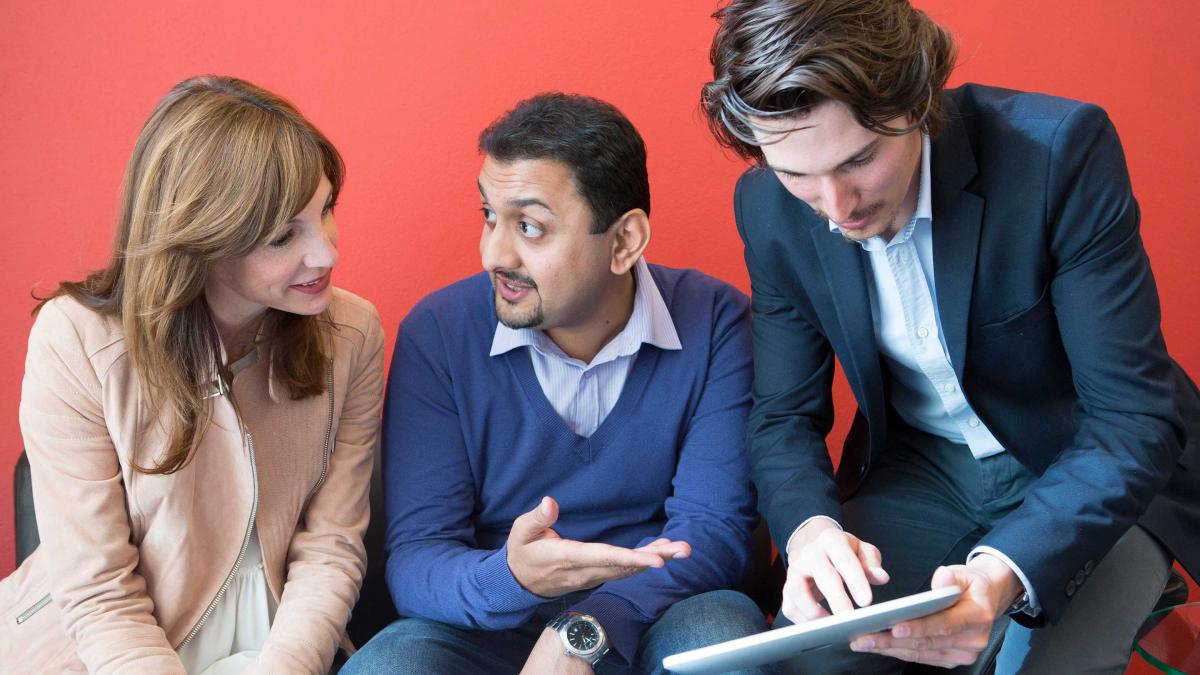
Here you will find more than fifty different case studies, developed by our former participants from the Master of Advanced Studies in Intercultural Communication. The richness of this material is that it contains real-life experiences in intercultural communication problems in various settings, such as war, family, negotiations, inter-religious conflicts, business, workplace, and others.
Cases also include renowned organizations and global institutions, such as the United Nations, Multinationals companies, Non-Governmental Organisations, Worldwide Events, European, African, Asian and North and South America Governments and others.
Intercultural situations are characterized by encounters, mutual respect and the valorization of diversity by individuals or groups of individuals identifying with different cultures. By making the most of the cultural differences, we can improve intercultural communication in civil society, in public institutions and the business world.
How can these Case Studies help you?
These case studies were made during the classes at the Master of Advanced Studies in Intercultural Communication. Therefore, they used the most updated skills, tools, theories and best practices available. They were created by participants working in the field of public administration; international organizations; non-governmental organizations; development and cooperation organizations; the business world (production, trade, tourism, etc.); the media; educational institutions; and religious institutions. Through these case studies, you will be able to learn through real-life stories, how practitioners apply intercultural communication skills in multicultural situations.
Why are we opening our "Treasure Chest" for you?
We believe that Intercultural Communication has a growing role in the lives of organizations, companies and governments relationship with the public, between and within organizations. There are many advanced tools available to access, analyze and practice intercultural communication at a professional level. Moreover, professionals are demanded to have an advanced cross-cultural background or experience to deal efficiently with their environment. International organizations are requiring workers who are competent, flexible, and able to adjust and apply their skills with the tact and sensitivity that will enhance business success internationally. Intercultural communication means the sharing of information across diverse cultures and social groups, comprising individuals with distinct religious, social, ethnic, and educational backgrounds. It attempts to understand the differences in how people from a diversity of cultures act, communicate and perceive the world around them. For this reason, we are sharing our knowledge chest with you, to improve and enlarge intercultural communication practice, awareness, and education.
We promise you that our case studies, which are now also yours, will delight, entertain, teach, and amaze you. It will reinforce or change the way you see intercultural communication practice, and how it can be part of your life today. Take your time to read them; you don't need to read all at once, they are rather small and very easy to read. The cases will always be here waiting for you. Therefore, we wish you an insightful and pleasant reading.
These cases represent the raw material developed by the students as part of their certification project. MIC master students are coming from all over the world and often had to write the case in a non-native language. No material can be reproduced without permission. © Master of Advanced Studies in Intercultural Communication , Università della Svizzera italiana, Switzerland.
Subscribe Us
If you want to receive our last updated case studies or news about the program, leave us your email, and you will know in first-hand about intercultural communication education and cutting-edge research in the intercultural field.

Want to create or adapt books like this? Learn more about how Pressbooks supports open publishing practices.
1. WHAT IS TECHNICAL COMMUNICATION?
1.4 Case Study: The Cost of Poor Communication
No one knows exactly how much poor communication costs business, industry and government each year, but estimates suggest billions. In fact, a recent estimate claims that the cost in the U.S. alone are close to $4 billion annually! [1] Poorly-worded or inefficient emails, careless reading or listening to instructions, documents that go unread due to poor design, hastily presenting inaccurate information, sloppy proofreading — all of these examples result in inevitable costs. The problem is that these costs aren’t usually included on the corporate balance sheet at the end of each year; if they are not properly or clearly defined, the problems remain unsolved.
You may have seen the Project Management Tree Cartoon before ( Figure 1.4.1 ); it has been used and adapted widely to illustrate the perils of poor communication during a project.
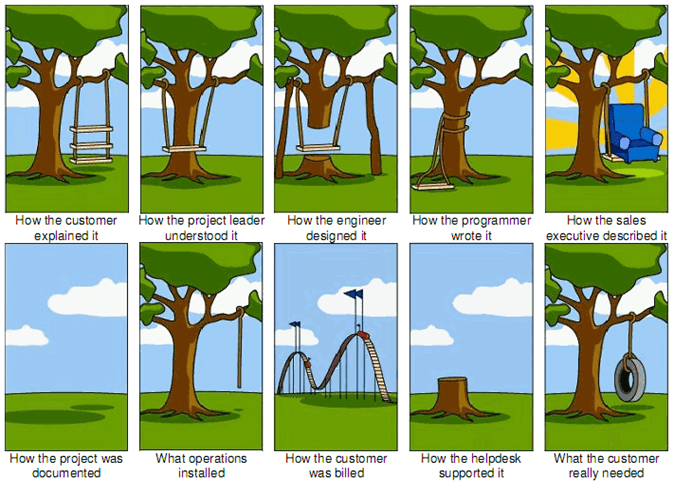
The waste caused by imprecisely worded regulations or instructions, confusing emails, long-winded memos, ambiguously written contracts, and other examples of poor communication is not as easily identified as the losses caused by a bridge collapse or a flood. But the losses are just as real—in reduced productivity, inefficiency, and lost business. In more personal terms, the losses are measured in wasted time, work, money, and ultimately, professional recognition. In extreme cases, losses can be measured in property damage, injuries, and even deaths.
The following “case studies” show how poor communications can have real world costs and consequences. For example, consider the “ Comma Quirk ” in the Rogers Contract that cost $2 million. [3] A small error in spelling a company name cost £8.8 million. [4] Examine Edward Tufte’s discussion of the failed PowerPoint presentation that attempted to prevent the Columbia Space Shuttle disaster. [5] The failure of project managers and engineers to communicate effectively resulted in the deadly Hyatt Regency walkway collapse. [6] The case studies below offer a few more examples that might be less extreme, but much more common.
In small groups, examine each “case” and determine the following:
- Define the rhetorical situation : Who is communicating to whom about what, how, and why? What was the goal of the communication in each case?
- Identify the communication error (poor task or audience analysis? Use of inappropriate language or style? Poor organization or formatting of information? Other?)
- Explain what costs/losses were incurred by this problem.
- Identify possible solution s or strategies that would have prevented the problem, and what benefits would be derived from implementing solutions or preventing the problem.
Present your findings in a brief, informal presentation to the class.
Exercises adapted from T.M Georges’ Analytical Writing for Science and Technology. [7]
CASE 1: The promising chemist who buried his results
Bruce, a research chemist for a major petro-chemical company, wrote a dense report about some new compounds he had synthesized in the laboratory from oil-refining by-products. The bulk of the report consisted of tables listing their chemical and physical properties, diagrams of their molecular structure, chemical formulas and data from toxicity tests. Buried at the end of the report was a casual speculation that one of the compounds might be a particularly safe and effective insecticide.
Seven years later, the same oil company launched a major research program to find more effective but environmentally safe insecticides. After six months of research, someone uncovered Bruce’s report and his toxicity tests. A few hours of further testing confirmed that one of Bruce’s compounds was the safe, economical insecticide they had been looking for.
Bruce had since left the company, because he felt that the importance of his research was not being appreciated.
CASE 2: The rejected current regulator proposal
The Acme Electric Company worked day and night to develop a new current regulator designed to cut the electric power consumption in aluminum plants by 35%. They knew that, although the competition was fierce, their regulator could be produced more affordably, was more reliable, and worked more efficiently than the competitors’ products.
The owner, eager to capture the market, personally but somewhat hastily put together a 120-page proposal to the three major aluminum manufacturers, recommending that the new Acme regulators be installed at all company plants.
She devoted the first 87 pages of the proposal to the mathematical theory and engineering design behind his new regulator, and the next 32 to descriptions of the new assembly line she planned to set up to produce regulators quickly. Buried in an appendix were the test results that compared her regulator’s performance with present models, and a poorly drawn graph showed the potential cost savings over 3 years.
The proposals did not receive any response. Acme Electric didn’t get the contracts, despite having the best product. Six months later, the company filed for bankruptcy.
CASE 3: The instruction manual the scared customers away
As one of the first to enter the field of office automation, Sagatec Software, Inc. had built a reputation for designing high-quality and user-friendly database and accounting programs for business and industry. When they decided to enter the word-processing market, their engineers designed an effective, versatile, and powerful program that Sagatec felt sure would outperform any competitor.
To be sure that their new word-processing program was accurately documented, Sagatec asked the senior program designer to supervise writing the instruction manual. The result was a thorough, accurate and precise description of every detail of the program’s operation.
When Sagatec began marketing its new word processor, cries for help flooded in from office workers who were so confused by the massive manual that they couldn’t even find out how to get started. Then several business journals reviewed the program and judged it “too complicated” and “difficult to learn.” After an impressive start, sales of the new word processing program plummeted.
Sagatec eventually put out a new, clearly written training guide that led new users step by step through introductory exercises and told them how to find commands quickly. But the rewrite cost Sagatec $350,000, a year’s lead in the market, and its reputation for producing easy-to-use business software.
CASE 4: One garbled memo – 26 baffled phone calls
Joanne supervised 36 professionals in 6 city libraries. To cut the costs of unnecessary overtime, she issued this one-sentence memo to her staff:
After the 36 copies were sent out, Joanne’s office received 26 phone calls asking what the memo meant. What the 10 people who didn’t call about the memo thought is uncertain. It took a week to clarify the new policy.
CASE 5: Big science — Little rhetoric
The following excerpt is from Carl Sagan’s book, The Demon-Haunted World: Science as a Candle in the Dark, [8] itself both a plea for and an excellent example of clear scientific communication:
The Superconducting Supercollider (SSC) would have been the preeminent instrument on the planet for probing the fine structure of matter and the nature of the early Universe. Its price tag was $10 to $15 billion. It was cancelled by Congress in 1993 after about $2 billion had been spent — a worst of both worlds outcome. But this debate was not, I think, mainly about declining interest in the support of science. Few in Congress understood what modern high-energy accelerators are for. They are not for weapons. They have no practical applications. They are for something that is, worrisomely from the point of view of many, called “the theory of everything.” Explanations that involve entities called quarks, charm, flavor, color, etc., sound as if physicists are being cute. The whole thing has an aura, in the view of at least some Congresspeople I’ve talked to, of “nerds gone wild” — which I suppose is an uncharitable way of describing curiosity-based science. No one asked to pay for this had the foggiest idea of what a Higgs boson is. I’ve read some of the material intended to justify the SSC. At the very end, some of it wasn’t too bad, but there was nothing that really addressed what the project was about on a level accessible to bright but skeptical non-physicists. If physicists are asking for 10 or 15 billion dollars to build a machine that has no practical value, at the very least they should make an extremely serious effort, with dazzling graphics, metaphors, and capable use of the English language, to justify their proposal. More than financial mismanagement, budgetary constraints, and political incompetence, I think this is the key to the failure of the SSC.
CASE 6: The co-op student who mixed up genres
Chris was simultaneously enrolled in a university writing course and working as a co-op student at the Widget Manufacturing plant. As part of his co-op work experience, Chris shadowed his supervisor/mentor on a safety inspection of the plant, and was asked to write up the results of the inspection in a compliance memo . In the same week, Chris’s writing instructor assigned the class to write a narrative essay based on some personal experience. Chris, trying to be efficient, thought that the plant visit experience could provide the basis for his essay assignment as well.
He wrote the essay first, because he was used to writing essays and was pretty good at it. He had never even seen a compliance memo, much less written one, so was not as confident about that task. He began the essay like this:
On June 1, 2018, I conducted a safety audit of the Widget Manufacturing plant in New City. The purpose of the audit was to ensure that all processes and activities in the plant adhere to safety and handling rules and policies outlined in the Workplace Safety Handbook and relevant government regulations. I was escorted on a 3-hour tour of the facility by…
Chris finished the essay and submitted it to his writing instructor. He then revised the essay slightly, keeping the introduction the same, and submitted it to his co-op supervisor. He “aced” the essay, getting an A grade, but his supervisor told him that the report was unacceptable and would have to be rewritten – especially the beginning, which should have clearly indicated whether or not the plant was in compliance with safety regulations. Chris was aghast! He had never heard of putting the “conclusion” at the beginning . He missed the company softball game that Saturday so he could rewrite the report to the satisfaction of his supervisor.
- J. Bernoff, "Bad writing costs business billions," Daily Beast , Oct. 16, 2016 [Online]. Available: https://www.thedailybeast.com/bad-writing-costs-businesses-billions?ref=scroll ↵
- J. Reiter, "The 'Project Cartoon' root cause," Medium, 2 July 2019. Available: https://medium.com/@thx2001r/the-project-cartoon-root-cause-5e82e404ec8a ↵
- G. Robertson, “Comma quirk irks Rogers,” Globe and Mail , Aug. 6, 2006 [Online]. Available: https://www.theglobeandmail.com/report-on-business/comma-quirk-irks-rogers/article1101686/ ↵
- “The £8.8m typo: How one mistake killed a family business,” (28 Jan. 2015). The Guardian [online]. Available: https://www.theguardian.com/law/shortcuts/2015/jan/28/typo-how-one-mistake-killed-a-family-business-taylor-and-sons ↵
- E. Tufte, The Cognitive Style of PowerPoint , 2001 [Online]. Available: https://www.inf.ed.ac.uk/teaching/courses/pi/2016_2017/phil/tufte-powerpoint.pdf ↵
- C. McFadden, "Understanding the tragic Hyatt Regency walkway collapse," Interesting Engineering , July 4, 2017 [Online]: https://interestingengineering.com/understanding-hyatt-regency-walkway-collapse ↵
- T.M. Goerges (1996), Analytical Writing for Science and Technology [Online], Available: https://www.scribd.com/document/96822930/Analytical-Writing ↵
- C. Sagan, The Demon-Haunted World: Science as a Candle in the Dark, New York, NY: Random House, 1995. ↵
Technical Writing Essentials Copyright © 2019 by Suzan Last is licensed under a Creative Commons Attribution 4.0 International License , except where otherwise noted.
Share This Book
- Study Guides
- Homework Questions
Week 3 - Case Briefing Answers
- Open access
- Published: 09 April 2024
Creating culturally-informed protocols for a stunting intervention using a situated values-based approach ( WeValue InSitu ): a double case study in Indonesia and Senegal
- Annabel J. Chapman 1 ,
- Chike C. Ebido 2 , 3 ,
- Rahel Neh Tening 2 ,
- Yanyan Huang 2 ,
- Ndèye Marème Sougou 4 ,
- Risatianti Kolopaking 5 , 6 ,
- Amadou H. Diallo 7 ,
- Rita Anggorowati 6 , 8 ,
- Fatou B. Dial 9 ,
- Jessica Massonnié 10 , 11 ,
- Mahsa Firoozmand 1 ,
- Cheikh El Hadji Abdoulaye Niang 9 &
- Marie K. Harder 1 , 2
BMC Public Health volume 24 , Article number: 987 ( 2024 ) Cite this article
Metrics details
International development work involves external partners bringing expertise, resources, and management for local interventions in LMICs, but there is often a gap in understandings of relevant local shared values. There is a widespread need to better design interventions which accommodate relevant elements of local culture, as emphasised by recent discussions in global health research regarding neo-colonialism. One recent innovation is the concept of producing ‘cultural protocols’ to precede and guide community engagement or intervention design, but without suggestions for generating them. This study explores and demonstrates the potential of an approach taken from another field, named WeValue InSitu , to generate local culturally-informed protocols. WeValue InSitu engages stakeholder groups in meaning-making processes which ‘crystallize’ their envelope of local shared values, making them communicable to outsiders.
Our research context is understanding and reducing child stunting, including developing interventions, carried out at the Senegal and Indonesia sites of the UKRI GCRF Action Against Stunting Hub. Each national research team involves eight health disciplines from micro-nutrition to epigenetics, and extensive collection of samples and questionnaires. Local culturally-informed protocols would be generally valuable to pre-inform engagement and intervention designs. Here we explore generating them by immediately following the group WeValue InSitu crystallization process with specialised focus group discussions exploring: what local life practices potentially have significant influence on the environments affecting child stunting, and which cultural elements do they highlight as relevant. The discussions will be framed by the shared values, and reveal linkages to them. In this study, stakeholder groups like fathers, mothers, teachers, market traders, administrators, farmers and health workers were recruited, totalling 83 participants across 20 groups. Themes found relevant for a culturally-informed protocol for locally-acceptable food interventions included: specific gender roles; social hierarchies; health service access challenges; traditional beliefs around malnutrition; and attitudes to accepting outside help. The concept of a grounded culturally-informed protocol, and the use of WeValue InSitu to generate it, has thus been demonstrated here. Future work to scope out the advantages and limitations compared to deductive culture studies, and to using other formative research methods would now be useful.
Peer Review reports
Although progress has been made towards the SDG of ‘Zero Hunger by 2025’, the global rates of malnutrition and stunting are still high [ 1 ]. Over the past 20 years, researchers have implemented interventions to reduce undernutrition, specifically focussing on the first 1000 days of life, from conception to 24 months [ 2 ]. However, due to both differing determinants between countries [ 3 , 4 ] as well as varying contextual factors, it is clear that no single fixed approach or combination of approaches can be relied on when implementing stunting interventions [ 5 , 6 , 7 ]. Furthermore, when external researchers design interventions for local areas in Low- and Middle-Income Countries (LMICs) they can often overlook relevant local cultural factors that consequently act as barriers to intervention uptake and reduce their effectiveness, such as geographical factors and the levels of migration in certain populations [ 8 , 9 ], or social norms or perceptions relating to accepting outside help, and power dynamics related to gender [ 10 , 11 , 12 ]. The inclusion of cultural level factors in behaviour change interventions has been proposed as a requirement for effective interventions [ 13 ]. However, despite the breadth of literature highlighting the negative impacts from failing to do this, the lack of integration or even regard of local culture remains a persistent problem in Global Health Research [ 14 ], possibly hindering progress towards the SDGs. Thus, there is a need for approaches to integrate local cultural elements into intervention design.
This lack of understanding of relevant local culture, social norms and shared values also has ethical implications. The field of Global Health Ethics was predominantly developed in the Global North, in High Income Countries (HICs), embedding values common in those countries such as the prominence of individual autonomy [ 15 , 16 ]. Researchers from HICs carrying out research in LMICs may wrongly assume that values held in the Global North are universal [ 14 ] and disregard some local values, such as those related to family and collective decision making, which are core to many communities in LMICs. It is therefore important for outside researchers to have an understanding of relevant local values, culture and social norms before conducting research in LMICs so as not to impose values that do not align with local culture and inadvertently cause harm or offence [ 16 , 17 ]. The importance of this is compounded by the colonial history that is often present in relationships between research communities in HICs and LMICs, and the fact that the majority of the funding and leading institutions are still located in the Global North [ 18 , 19 ]. Thus, conscious steps must be taken to avoid neo-colonialism in Global Health Research [ 20 ]. From a health-equity perspective, it is essential to ensure that those in vulnerable communities are not hindered from involvement in interventions to improve nutrition. Encouraging uptake by such communities could be provided if salient local shared values, norms and culture were taken into account [ 21 ].
In a recent paper, Memon et al., (2021) highlight the usefulness of first creating a cultural protocol that can precede and guide subsequent stages of community engagement or intervention design to ensure that salient local values are known to external researchers coming into the community [ 16 ]. We adopt the use of the concept of a cultural protocol, referring to locally-generated guidance about key values, norms, behaviours and customs relevant to working with the local community. However, we prefer the term, ‘culturally-informed protocol’ since this relates to only cultural elements deemed salient by the researchers, and locally, rather than any comprehensive notion of culture, nor extending beyond the research context.
Memon et al. (2021), point out links between the creation of such a protocol and existing codes of practice that have already been created for some cultures such as the Te Ara Tika, a Guideline for Māori Research Ethics [ 22 ]. Currently, research and interventions in Global Health can be informed by a stage of formative research involving one-to-one interviews, focus groups or direct observations, which can sometimes be ethnographic in nature such as within Focussed Ethnographic Studies or Rapid Assessment Procedures [ 23 , 24 , 25 ]. Although these methods can be effective to inform intervention designs, they have disadvantages like: can take long periods to complete [ 26 ], can be resource intensive [ 26 ] and can lack cultural acceptability [ 27 ]. These limitations may account for the frequent neglect of their use generally, highlighted by Aubel and Chibanda (2022) [ 14 ]. Additionally, none of these methods work towards making explicit local values, or towards the creation of a culturally-informed protocol. In brief, the literature suggests a need to develop alternative methods of Formative Research for understanding locally relevant cultural elements, that are less time-consuming and can generate data that is more easily translatable to intervention design. In addition, these approaches must be applicable in different cultures. Additionally, the protocols produced must be actionable and practical not only for guiding interactions between research teams but also for guiding the initial stages of intervention design.
The work presented here aims to address several of these needs. It includes an exploration of the usefulness of the WeValue InSitu ( WVIS ) approach because that has previously been shown, in environmental management domains, to offer a way to gather in-depth values-based perspectives from a target population [ 28 , 29 ] It was first created through action research, and co-designed to enable civil society organisations to better understand and measure the values-based aspects of their work [ 30 ]. The core WeValue InSitu process (detailed in Table 1 ) involves the crystallization of shared values, with a facilitator guiding a group of participants with shared experiences, through cycles of tacit meaning-making (using a stage of photo-elicitation and triggering) [ 31 ], until they can articulate more explicitly their shared values, in concise and precise statements. These statements are then linked together in a framework by the participants. In an example case in Nigeria, the results of the WVIS approach hinted at the creation of a culturally-informed protocol through an analysis of the shared values frameworks to find cultural themes for the creation of an indicator tool that was used to evaluate several development scenarios based on their social acceptability [ 29 ].
Furthermore, it has been found that if a group of WVIS participants take part in a specialised focus group discussion (FGD), named Perspectives EXploration (PEX:FGD) immediately afterward the main workshop, then they easily and articulately express their perspectives on the topics raised for discussion - and with allusions to the shared values they had crystallised just prior. In an example from Shanghai, the PEX:FGDs focussed on eliciting perspectives on climate change, which were shown to be closely linked with the cultural themes existing within the shared values frameworks produced immediately prior [ 32 ]. In that case, the PEX:FGDs allowed the cultural themes generated during the main WVIS workshop to be linked more closely to the research question. Those results suggested that the WVIS plus PEX:FGD approach could be used to create a specialised culturally-informed protocol for improved intervention design.
In the study presented here, the WVIS approach was explored for the purpose of creating culturally-informed protocols to inform the planning of interventions within two localities of the UKRI GCRF Action Against Stunting Hub [ 33 ]. The work was carried out in two parts. Firstly, the WVIS main workshop was used to elicit cultural themes within the target communities, indicating key elements to consider to ensure ethical engagement. Secondly, the PEX focus group discussions focussed on life practices related to stunting which we explored for the purpose of tailoring the culturally-informed protocols to the specific purpose of improving the design of an example intervention. The Action Against Stunting Hub works across three sites where stunting is highly prevalent but via different determinants: East Lombok in Indonesia (estimated 36% of under-fives stunted), Kaffrine in Senegal (estimated 16% of under-fives stunted) and Hyderabad in India (estimated 48% of under-fives stunted) [ 34 ]. We propose that, the information about local shared values in a given site could be used to inform the design of several interventions, but for our specific exploration the focus here is a proposed ‘egg intervention’, in which pregnant women would be provided with an egg three times per week as supplement to their diet. This study proposes that identifying shared values within a community, alongside information about local life practices, provides critical cultural information on the potential acceptability and uptake of this intervention which can be used to generate culturally-informed protocols consisting of recommendations for improved intervention design.
In this paper we aim to explore the use of the WVIS approach to create culturally-informed protocols to guide engagement and inform the design of localised egg interventions to alleviate stunting in East Lombok, Indonesia and Kaffrine, Senegal. We do this by analysing data about local shared values that are crystallized using the WeValue InSitu ( WVIS ) process to provide clear articulation of local values, followed by an analysis of life practices discussed during PEX:FGD to tailor the culturally-informed protocols for the specific intervention design.
Study setting
This research was exploratory rather than explanatory in nature. The emphasis was on demonstrating the usefulness of the WeValue InSitu ( WVIS ) approach to develop culturally-informed protocols of practical use in intervention design, in different cultural sites. This study was set within a broader shared-values workstream within the UKRI GCRF Action Against Stunting Hub project [ 33 ]. The Hub project, which was co-designed and co-researched by researchers from UK, Indonesia, Senegal and India, involves cohorts of 500 women and their babies in each site through pregnancy to 24 months old, using cross-disciplinary studies across gut health, nutrition, food systems, micro-nutrition, home environment, WASH, epigenetics and child development to develop a typology of stunting. Alongside these health studies are studies of the shared values of the communities, obtained via the WVIS approach described here, to understand the cultural contexts of that diverse health data. In this study the data from East Lombok, Indonesia and Kaffrine, Senegal were used: India’s data were not yet ready, and these two countries were deemed sufficient for this exploratory investigation.
The WVIS approach
The WVIS approach is a grounded scaffolding process which facilitates groups of people to make explicit their shared values in their own vocabulary and within their own frames (details in Fig. 1 and activities in Table 1 ). The first stage of the WVIS is Contextualisation, whereby the group identifies themselves and set the context of their shared experiences, for example, as ‘mothers in East Lombok, Indonesia’. Subsequently, there is a stage of Photo Elicitation, in which the group are first asked to consider what is important, meaningful or worthwhile to them about their context (e.g., ‘being mothers in East Lombok, Indonesia’) and then asked to choose photos from a localised set that they can use as props to help describe their answer to the group [ 29 ]. After this, a localised Trigger List is used. This Trigger List consists of 109 values statements that act as prompts for the group. Examples of these values statements are included below but all the statements begin with “it is important to me/us that…”. The group are asked to choose which statements within the trigger list resonate with them, and those are taken forward for group intersubjective discussion. After a topic of their shared values has been explored, the group begin to articulate and write down their own unique statements of them. These also all begin with “It is important to me/us that…”. After discussing all pressing topics, the group links the written statements on the table into a unique Framework, and one member provides a narrative to communicate it to ‘outsiders’. The WVIS provides a lens of each group’s local shared values, and it is through this lens that they view the topics in the focus group discussions which immediately follow, termed Perspectives EXplorations (PEX:FGDs).

Schematic of the macro-level activities carried out during the WeValue InSitu ( WVIS ) main workshop session
This results in very grounded perspectives being offered, of a different nature to those obtained in questionnaires or using external frameworks [ 31 ]. The specific PEX:FGD topics are chosen as pertinent to stunting contextual issues, including eating habits, food systems and environments, early educational environments, and perceptions of stunting. The local researchers ensured that all topics were handled sensitively, with none that could cause distress to the participants. The data for this study were collected over 2 weeks within December 2019–January 2020 in workshops in East Lombok, Indonesia, and 2 weeks within December 2020 in Kaffrine, Senegal.
The PEX:FGDs were kept open-ended so that participants could dictate the direction of the discussion, which allowed for topics that may not have been pre-considered by the facilitators to arise. Sessions were facilitated by local indigenous researchers, guided in process by researchers more experienced in the approach, and were carried out in the local languages, Bahasa in East Lombok, Indonesia and French or Wolof in Kaffrine, Senegal.
Development of localised WVIS materials
Important to the WVIS approach is the development of localised materials (Table 1 ). The main trigger list has been found applicable in globalised places where English is the first language, but otherwise the trigger lists are locally generated in the local language, incorporating local vocabulary and ways of thinking. To generate these, 5–8 specific interviews are taken with local community members, by indigenous university researchers, eliciting local phrases and ways of thinking. This is a necessary step because shared tacit values cannot be easily accessed without using local language. Examples of localised Trigger Statements produced this way are given below: (they all start with: “It is important to me/us that…”):
…there is solidarity and mutual aid between the people
…I can still be in communication with my children, even if far away
…husbands are responsible for the care of their wives and family
…the town council fulfils its responsibility to meet our needs
…people are not afraid of hard, and even manual work
Study participants
The group participants targeted for recruitment, were selected by local country Hub co-researchers to meet two sets of requirements. For suitability for the WVIS approach they should be between 3 and 12 in number; belong to naturally existing groups that have some history of shared experiences; are over 18 years old; do not include members holding significantly more power than others; and speak the same native language. For suitability in the PEX:FGD to offer life practices with relevance to the research topic of stunting, the groups were chosen to represent stakeholders with connections to the food or learning environment of children (which the Action Against Stunting Hub refer to as the Whole Child approach) [ 33 ]. The university researchers specialising in shared values from the UK, and Senegal and Indonesia respectively, discussed together which stakeholder groups might be appropriate to recruit. The local researchers made the final decisions. Each group was taken through both a WVIS workshop and the immediately-subsequent PEX:FGD.
Data collection and analysis
Standard data output from the WeValue session includes i) the jointly-negotiated bespoke Statements of shared values, linked together in their unique Framework, and ii) an oral recording of a descriptive Narrative of it, given by the group. These were digitized to produce a single presentation for each group as in Fig. 2 . It represents the synthesised culmination of the crystallisation process: a portrait of what was ‘important’ to each stakeholder group. Separately, statements from the group about the authenticity/ownership of the statements are collected.
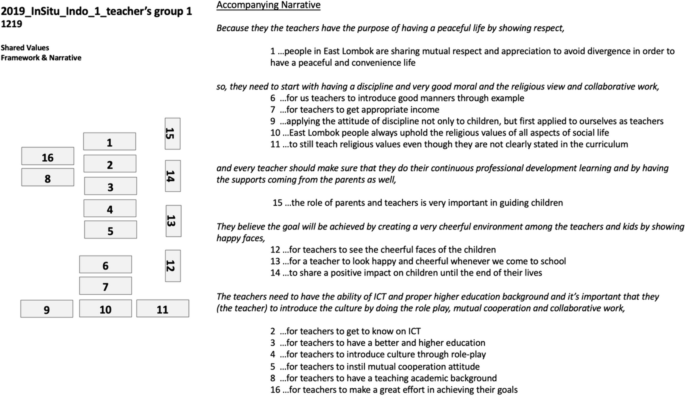
An illustrative example of one digitized Shared Values Framework and accompanying Narrative from a teacher’s group in East Lombok, Indonesia. The “…” refers to each statement being preceded by “It is important to us that…”
When these Frameworks of ‘Statements of Shared Values’ are viewed across all the groups from one locality (Locality Shared Values Statements), they provide portraits of ‘what is important’ to people living there, often in intimate detail and language. They can be used to communicate to ‘outsiders’ what the general cultural shared values are. In this work the researchers thematically coded them using Charmaz constructionist grounded theory coding [ 35 ] to find broad Major Cultural Themes within each separate locality.
The second area of data collection was in the post- WVIS event: the PEX:FGD for each group. A translator/interpreter provided a running commentary during these discussions, which was audio recorded and then transcribed. The specific topics raised for each group to discuss varied depending on their local expertise. This required completely separate workstreams of coding of the dataset with respect to each topic. This was carried out independently by two researchers: one from UK (using NVivo software (Release 1.3.1)) and one from the local country, who resolved any small differences. All the transcripts were then collated and inductively, interpretively analysed to draw out insights that should be relayed back to the Action Against Stunting Hub teams as contextual material.
The extracts of discussion which were identified as relevant within a particular Hub theme (e.g. hygiene) were then meta-ethnographically synthesised [ 36 ] into ‘Hub Theme Statements’ on each topic, which became the core data for later communication and interrogation by other researchers within the Action Against Stunting Hub. These statements are interpretations of participants’ intended meanings, and links from each of them to data quotes were maintained, enabling future interpretations to refer to them for consistency checks between received and intended meaning.
In this investigation, those Hub Theme Statements (derived from PEX:FGD transcripts) were then deductively coded with respect to any topics with potential implications of the egg intervention. Literature regarding barriers and facilitators to nutrition interventions indicated the following topics could be relevant: attitudes to accepting help; community interactions; cooking and eating habits; traditional beliefs about malnutrition; sharing; social hierarchies [ 12 , 37 , 38 ] to which we added anything related to pregnancy or eggs. This analysis produced our Egg Intervention Themes from the data.
The Major Cultural Themes and Egg Intervention Themes were then used to create a set of culture-based recommendations and intervention specific recommendations respectively for each locality. These recommendations were then combined to form specialized culturally-informed protocols for the egg intervention in each locality: East Lombok, Indonesia and Kaffrine, Senegal. The process is displayed schematically in Fig. 3 .
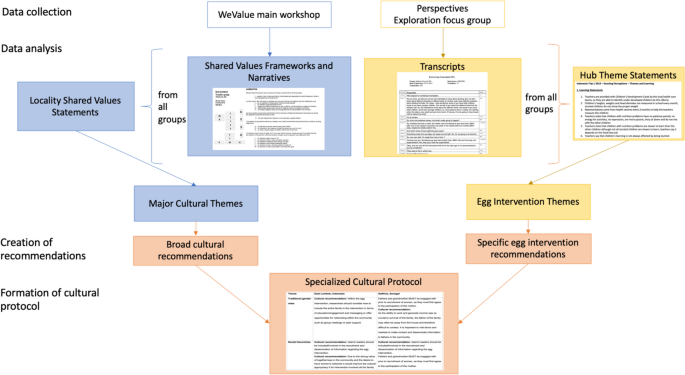
Schematic representation of the method of production of the culturally-informed protocol for each locality
The preparation of the localised WVIS materials at each site took 6 hours of interview field work, and 40 person hours for analysis. The 10 workshops and data summaries were concluded within 10 workdays by two people (80 person hours). The analysis of the PEX:FGD data took a further 80 person hours. Thus, the total research time was approximately 200 person hours.
The stakeholder group types are summarised in Table 2 . The data is presented in three parts. Firstly, the Major Cultural Themes found in East Lombok, Indonesia and in Kaffrine, Senegal are described – the ones most heavily emphasised by participants. Then, the Egg Intervention Themes and finally, the combined set of Recommendations to comprise a culturally-informed protocol for intervention design for each location. Quotations are labelled INDO or SEN for East Lombok, Indonesia and Kaffrine, Senegal, respectively.
Major cultural themes from frameworks and narratives
These were derived from the Locality Shared Values Statements produced in the WVIS .
East Lombok, Indonesia
Religious values.
Islamic values were crucially important for participants from East Lombok, Indonesia and to their way of life. Through living by the Quran, participating in Islamic community practices, and teaching Islamic values to their children, participants felt they develop their spirituality and guarantee a better afterlife for themselves and their children. Participants stated the Quran tells them to breastfeed their children for 2 years, so they do. Despite no explicit religious official curriculum in Kindergarten, the teachers stated that it was important to incorporate religious teaching.
“East Lombok people always uphold the religious values of all aspects of social life.”
“It is important for me to still teach religious values even though they are not clearly stated in the curriculum.” – Workshop 1 INDO (teachers).
“In Quran for instance, we are told to breastfeed our kids for 2 years. We can even learn about that ” – Workshop 3 INDO (mothers).
Related to this was the importance of teaching manners to children and preventing them from saying harsh words. Teachers stated that it was important to create a happy environment for the children and to ensure that they are polite and well-behaved. Similarly, mothers emphasised the need to teach their children good religious values to ensure they will be polite and helpful to their elders.
“Children don’t speak harsh words.”
“My children can help me like what I did to my parents”.
– Workshop 8 INDO (mothers).
Togetherness within families and the community
The Locality Shared Values Frameworks stressed the importance of togetherness, both within family and community. Comments mentioned it being important that people rely heavily on their family and come together in times of need to support each other and provide motivation. This was also important more broadly, in that people in society should support each other, and that children grow up to contribute to society. This was also reflected in comments around roles within the family. Despite women being primary care givers, and men working to finance the family, participants stated that they follow a process of consultation to make decisions, and when facing hardships.
“that we have the sense of kinship throughout our society”.
“We have togetherness as mothers”.
“For the family side, whatever happens we need to be able to be united as a whole family. We need to have the [sense of] forgiveness for the sake of the children” – Workshop 2 INDO (mothers).
Attitudes about extra-marital pregnancy
In East Lombok, Indonesia, it was essential to both mothers and fathers that pregnancy happened within a marriage, this was to ensure that the honour of the family was upheld and that the lineage of the child was clear. The potential danger to health that early pregnancies can cause was also acknowledged.
“If they don’t listen to parents’ advice, there will be the possibility of pre-marital pregnancy happening, which will affect the family [so much].
The affect is going to be ruining the good name, honour and family dignity. When the children [are] born outside [of] marriage, she or he will have many difficulties like getting a birth certificate [and] having a hard time when registering to school or family” - Workshop 4 INDO (mothers).
“ To make sure that our children avoid getting married at a very young age and moreover [avoid] having free sex so that they will not get pregnant before the marriage” - Workshop 9 INDO (fathers).
Kaffrine, Senegal
The Major Cultural Themes which emerged from the Kaffrine data are described below. As these are grounded themes, they are different than those seen in East Lombok, Indonesia.
Access to healthcare
A recurring theme amongst the groups in Kaffrine were aspirations of affordable and easy-to-access healthcare. Community health workers stated the importance of encouraging women to give birth in hospitals and spoke of the importance of preventing early pregnancy which result from early marriages. Giving birth in hospitals was also a concern for Public Office Administrators who highlighted that this leads to subsequent issues with registering children for school. Mothers and fathers stated the importance of being able to afford health insurance and access healthcare so that they could take care of themselves.
“That the women give birth in the hospital” – Workshop 11 SEN (CHWS).
“To have affordable health insurance ” – Workshop 10 SEN (mothers).
“To have access to health care ” – Workshop 3 SEN (fathers).
“It is important that women give birth in the hospital in order to be able to have a certificate that allows us to establish the civil status” – Workshop 9 SEN (administrators).
Additionally, Community health workers spoke of their aspiration to have enough supplements to provide to their community so as to avoid frustration at the lack of supply, and mothers spoke of their desire to be provided with supplements.
“To have dietary supplements in large quantities to give them to all those who need them, so as not to create frustration” – Workshop 11 SEN (CHWS).
Another aspect of access to healthcare, was mistrust between fathers and community health workers. Community health workers explained that sometimes men can blame them when things go wrong in a pregnancy or consider their ideas to be too progressive. Thus, to these community health workers the quality of endurance was very important.
“Endurance (Sometimes men can accuse us of influencing their wives when they have difficulties in conceiving)” – Workshop 5 SEN (CHWs).
Another recurring theme was the importance of having secure employment and a means to support themselves; that there were also jobs available for young people, and that women had opportunities to make money to help support the family. This included preventing early marriages so girls could stay in school. Having jobs was stated as essential for survival and important to enable being useful to the community and society.
“To have more means of survival (subsistence) to be able to feed our families”.
“To have a regular and permanent job”.
“We assure a good training and education for our children so that they will become useful to us and the community”.
“ Our women should have access to activities that will support us and lessen our burden” – Workshop 3 SEN (fathers).
It was considered very important to have a religious education and respect for religious elders. Moreover, living by, and teaching, religious values such as being hard working, humble and offering mutual aid to others, was significant for people in Kaffrine.
“Have an education in the Islamic Culture (Education that aligns with the culture of Islam)”.
“Respect toward religious leaders” – Workshop 3 SEN (fathers).
“ To organize religious discussions to develop our knowledge about Islam ” - Workshop 10 SEN (mothers).
“ Have belief and be prayerful and give good counselling to people ” - Workshop 4 SEN (grandmothers).
Egg intervention themes from each country from perspectives EXplorations focus group discussion data
Below are results of analyses of comments made during the PEX:FGDs in East Lombok, Indonesia and Kaffrine, Senegal. The following codes were used deductively: attitudes to accepting outside help, traditional gender roles, food sharing, traditional beliefs, social hierarchies and understanding of stunting and Other. These topics were spoken about during open discussion and were not the subject of direct questions. For example, topics relating to traditional gender roles came up in East Lombok, during conversations around the daily routine. Thus, in order to more accurately reflect the intended meaning of the participants, these were labelled food practices, under the “Other” theme. If any of the themes were not present in the discussion, they are not shown below.
Attitudes to accepting outside help
Few mentions were made that focussed on participants attitudes to accepting outside help, but participants were sure that they would not make changes to their menus based on the advice of outside experts. Additionally, teachers mentioned that they are used to accepting help from local organisations that could to help them to identify under-developed children.
“ We don’t believe that [the outsiders are] going to change our eating habits or our various menus ” – Workshop 3 INDO (Mothers).
Traditional gender roles
In East Lombok, mothers spoke about how their husbands go to work and then provide them with daily money to buy the food for the day. However, this was discussed in relation to why food is bought daily and is thus discussed below in the topics Other – Food practices.
Food sharing
In East Lombok, Indonesia, in times when they have extra food, they share it with neighbours, in the hope that when they face times of hardship, their neighbours will share with them. Within the household, they mentioned sharing food from their plate with infants and encouraging children to share. Some mothers mentioned the importance of weekly meetings with other mothers to share food and sharing food during celebrations.
“ Sometimes we share our food with our family. So, when we cook extra food, we will probably send over the food to our neighbour, to our families. So, sometimes, with the hope that when we don’t have anything to eat, our neighbour will pay for it and will [share with] us.” – Workshop 3 INDO (Mothers).
“Even they serve food for the kids who come along to the house. So, they teach the kids to share with their friends. They provide some food. So, whenever they play [at their] house, they will [eat] the same.” – Workshop 2 INDO (Mothers).
Understanding of stunting
The teachers in East Lombok were aware of child stunting through Children’s Development Cards provided by local healthcare organizations. They stated that they recognise children with nutrition problems as having no patience period, no expression, no energy for activities and less desire to socialise and play with other children. The teachers said that stunted children do not develop the same as other children and are not as independent as children who are the proper height and weight for their development. They also stated that they recognise stunted children by their posture, pale faces and bloated stomachs. They explained how they usually use the same teaching methods for stunting children, but will sometimes allow them to do some activities, like singing, later, once the other children are leaving.
“ They have no patience period, don’t have any energy to do any of the activities. No expression, only sitting down and not mingling around with the kids. They are different way to learn. They are much slower than the other kids .” – Workshop 1 INDO (teachers).
“ When they are passive in singing, they will do it later when everyone else is leaving, they just do it [by] themselves ” – Workshop 1 INDO (teachers).
Specific views on eggs
In East Lombok, Indonesia, there were no superstitions or traditional beliefs around the consumption of eggs. When asked specifically on their views of eggs, and if they would like to be provided with eggs, women in East Lombok said that they would be happy to accept eggs. They also mentioned that eggs were a food they commonly eat, feed to children and use for convenience. Eggs were considered healthy and were common in their house.
“ We choose eggs instead. If we don’t have time, we just probably do some omelettes or sunny side up. So, it happens, actually when we get up late, we don’t have much time to be able to escort our kids to the school, then we fry the eggs or cook the instant noodles. And it happens to all mothers. So, if my kids are being cranky, that’s what happens, I’m not going to cook proper meals so, probably just eggs and instant noodles.” – Workshop 3 INDO (Mothers).
Other important topics – food practices
Some detailed themes about food practices were heard in East Lombok, Indonesia. The women were responsible for buying and preparing the food, which they purchased daily mainly due to the cost (their husbands were paid daily and so provided them with a daily allowance) and lack of storage facilities. They also bought from mobile vendors who came to the street, because they could buy very small amounts and get occasional credit. The mother decided the menu for the family and cooked once per day in the morning: the family then took from this dish throughout the day. Mothers always washed their fruits and vegetables and tried to include protein in their meals when funds allowed: either meat, eggs, tofu or tempeh.
“ One meal a day. They [the mothers] cook one time and they [the children] can eat it all day long. Yes, they can take it all day long. They find that they like [to take the food], because they tend to feel hungry.” – Workshop 6 INDO (Mothers).
“ They shop every day because they don’t have any storage in their house and the other factor is because the husband has a daily wage. They don’t have monthly wage. In the morning, the husband gives the ladies the money and the ladies go to the shop for the food. ” – Workshop 4 INDO (Mothers).
In Kaffrine, the following themes emerged relating to an egg intervention: they were different in content and emphasis to Lombok and contained uniquely local cultural emphases.
Mothers were welcoming of eggs as a supplement to improve their health during pregnancy and acknowledged the importance of good nutrition during pregnancy. However, they also mentioned that their husbands can sometimes be resistant to accepting outside help and provided an example of a vaccination programme in which fathers were hesitant to participate. However, participants stated that the Government should be the source of assistance to them (but currently was not perceived to be so).
“But if these eggs are brought by external bodies, we will hesitate to take it. For example, concerning vaccination some fathers hesitate to vaccinate their children even if they are locals who are doing it. So, educating the fathers to accept this is really a challenge” – Workshop 11 SEN (CHWs).
Some traditional gender roles were found to be strong. The participants emphasised that men are considered the head of the household, as expected in Islam, with the mother as primary caregiver for children. This is reflected in the comments from participants regarding the importance of Islam and living their religious values. The men thus made the family decisions and would need to be informed and agree to any family participation in any intervention – regardless of the education level of the mother. The paternal grandmother also played a very important role in the family and may also make decisions for the family in the place of the father. Community Health Workers emphasised that educating paternal grandmothers was essential to improve access to healthcare for women.
“There are people who are not flexible with their wives and need to be informed. Sometimes the mother-in-law can decide the place of the husband. But still, the husband’s [permission] is still necessary.” – Workshop 1 SEN (CHWs).
“[We recommend] communication with mothers-in-law and the community. Raise awareness through information, emphasizing the well-being of women and children.” – Workshop 1 SEN (CHWs).
“The [grand]mothers take care of the children so that the daughters in-law will take care of them in return So it’s very bad for a daughter in law not to take care of her mother in-law. Society does not like people who distance themselves from children.” – Workshop 4 SEN (grandmothers).
Social hierarchies
In addition to hierarchies relating to gender/position in the family such as grandmothers have decision making power, there was some mention of social hierarchies in Kaffrine, Senegal. For example, during times of food stress it was said that political groups distribute food and elected officials who choose the neighbourhoods in which the food will be distributed. Neighbourhood leaders then decide to whom the food is distributed, meaning there is a feeling that some people are being left out.
“ It’s political groups that come to distribute food or for political purposes…organizations that often come to distribute food aid, but in general it is always subject to a selection on the part of elected officials, in particular the neighbourhood leaders, who select the people they like and who leave the others ” – Workshop 11 SEN (CHWs).
Participants explained that during mealtimes, the family will share food from one large plate from which the father will eat first as a sign of respect and courtesy. Sometimes, children would also eat in their neighbour’s house to encourage them to eat.
“ Yes, it happens that we use that strategy so that children can eat. Note that children like to imitate so that’s why we [send them to the neighbour’s house]” – Workshop 11 SEN (CHWs)”.
Traditional beliefs about malnutrition
In Kaffrine, Senegal, some participants spoke of traditional beliefs relating to malnutrition, which are believed by fewer people these days. For example, uncovered food might attract bad spirits, and any person who eats it will become ill. There were a number of food taboos spoken of which were thought to have negative consequences for the baby, for example watermelon and grilled meat which were though to lead to birth complications and bleeding. Furthermore, cold water was thought to negatively impact the baby. Groups spoke of a tradition known as “bathie” in which traditional healers wash stunted children with smoke.
“ There are traditional practices called (Bathie) which are practiced by traditional healers. Parents are flexible about the practice of Bathie ” – Workshop 1 SEN (CHWs).
Causes of malnutrition and stunting were thought to be a lack of a balanced diet, lack of vitamin A, disease, intestinal worms, poor hygiene, socio-cultural issues such as non-compliance with food taboos, non-compliance with exclusive breastfeeding and close pregnancies. Malnutrition was also thought by some to be hereditary. Numerous signs of malnutrition were well known amongst the groups in Kaffrine. For example, signs of malnutrition were thought to be a big bloated belly, diarrhoea, oedema of the feet, anaemia, small limbs and hair loss as well as other symptoms such as red hair and a pale complexion. Despite this, malnutrition was thought to be hard to identify in Kaffrine as not all children will visit health centres, but mothers do try to take their babies heights and weights monthly. The groups were aware of the effect of poverty on the likelihood of stunting as impoverished parents cannot afford food. Furthermore, the groups mentioned that there is some stigma towards stunted children, and they can face mockery from other children although most local people feel pity and compassion towards them. Malnourished children are referred to as Khiibon or Lonpogne in the local language of Wolof.
“ It is poverty that is at the root of malnutrition, because parents do not have enough money [and] will have difficulty feeding their families well, so it is the situation of poverty that is the first explanatory factor of malnutrition here in Kaffrine” – Workshop 9 SEN (administrators).
“It can happen that some children are the victim of jokes for example of mockery from children of their same age, but not from adults and older ” – Workshop 9 SEN (administrators).
Pregnancy beliefs
In Kaffrine, Senegal, there were concerns around close pregnancies, and pregnancies in women who were too young, and for home births. Within the communities there was a stigma around close pregnancies, which prevented them from attending antenatal appointments. Similarly, there were superstitions around revealing early pregnancies, which again delayed attendance at health centres.
Groups acknowledged the role of good nutrition, and mentioned some forbidden foods such as salty foods, watermelon and grilled meat (which sometimes related back to a traditional belief that negative impacts would be felt in the pregnancy such as birth complications and bleeding). Similarly, drinking cold water was thought to negatively affect the baby. Beneficial foods mentioned included vegetables and meat, during pregnancy.
“ Often when a woman has close pregnancies, she can be ashamed, and this particularly delays the time of consultation” – Workshop 5 SEN (CHWs).
“Yes, there are things that are prohibited for pregnant women like salty foods” – Workshop 11 SEN (CHWs).
In Kaffrine, Senegal, some participants spoke of a traditional belief that if a pregnant woman consumes eggs then her baby might be overweight, or have problems learning how to talk. Despite this, mothers in Kaffrine said that they would be happy to accept eggs as a supplement, although if supplements are provided that require preparation (such as powdered supplements), they would be less likely to accept them.
“These restrictions are traditional, and more women no longer believe that eggs will cause a problem to the child. But if these eggs are brought by external bodies, we will hesitate to take it.” – Workshop 11 SEN (CHWs).
“They don’t eat eggs before the child starts speaking (the child only eats eggs when he starts talking). This is because it’s very heavy and can cause bloating and may also lead to intestinal problems.” – Workshop 4 SEN (grandmothers).
Other important topics – access to health services
For the participants in Kaffrine, Senegal, accessing health services was problematic, particularly for pre- and post-natal appointments, which faced frequent delays. Some women had access due to poor roads and chose to give birth at home. Access issues were further compounded by poverty and social factors, as procedures in hospitals can be costly, and women with close pregnancies (soon after an earlier one) can feel shame from society and hide their pregnancy.
“Women really have problems of lack of finances. There are social services in the hospital; but those services rarely attend to women without finances. Even when a child dies at birth they will require money to do the necessary procedure ” – Workshop 11 SEN (CHWs).
Creation of the culturally-informed protocols
Recommendations that comprise a culturally-informed protocol for intervention design in each locality are given in Table 3 .
The Major Cultural Themes, and specific Egg Intervention Themes drawn out from only 9–11 carefully planned group sessions in each country provided a rich set of recommendations towards a culturally-informed protocol for the localised design of a proposed Egg Intervention for both East Lombok, Indonesia and Kaffrine, Senegal. A culturally-informed protocol designed in this way comprises cultural insights which are worthy of consideration in local intervention design and should guide future stages of engagement and provide a platform from which good rapport and trust can be built between researchers and the community [ 16 ]. For example, in Kaffrine, Senegal, the early involvement of husbands and grandmothers is crucial, which reflects values around shared decision making within families that are noted to be more prevalent in LMICs, in contrast to individualistic values in HICs [ 16 , 39 ]. Similarly, due to strong religious values in both East Lombok, Indonesia and Kaffrine, Senegal, partnerships with Islamic leaders is likely to improve engagement. Past studies show the crucial role that religious leaders can play in determining social acceptability of interventions, particularly around taboo topics such as birth spacing [ 40 ].
The WVIS plus PEX:FGD method demonstrated here produced both broad cultural themes from shared values, which were in a concise and easy-to-understand format which could be readily communicated with the wider Action Against Stunting Hub, as well as life practices relevant to stunting in Kaffrine, Senegal and in East Lombok, Indonesia. Discussions of shared values during the WVIS main workshop provided useful cultural background within each community. PEX:FGD discussion uncovered numerous cultural factors within local life practices that could influence on the Egg Intervention engagement and acceptability. Combining themes from the WVIS workshop and PEX:FGDs allowed for specific recommendations to be made towards a culturally-informed protocol for the design of an Egg Intervention that included both broad cultural themes and specific Intervention insights (Table 3 ). For example, in Kaffrine, Senegal, to know that the husband’s authoritative family decision-making for health care (specific) is rooted in Islamic foundations (wider cultural) points to an Intervention Recommendation within the protocol, involving consultations with Islamic Leaders to lead community awareness targeting fathers. Similarly, in East Lombok, Indonesia the (specific) behaviour of breastfeeding for 2 years was underpinned by (wider cultural) shared values of living in Islam. This understanding of local values could prevent the imposition of culturally misaligned values, which Bernal and Adames (2017) caution against [ 17 ].
There are a number of interesting overlaps between values seen in the WVIS Frameworks and Narratives and the categories of Schwartz (1992) and The World Values Survey (2023) [ 41 , 42 ]. For example, in both Kaffrine, Senegal and East Lombok, Indonesia, strong religious values were found, and the groups spoke of the importance of practicing their religion with daily habits. This would align with traditional and conservation values [ 41 , 43 ]. Furthermore, in Kaffrine, Senegal participants often mentioned the importance of mutual aid within the community, and similar values of togetherness and respect in the community were found in East Lombok, Indonesia. These would seem to align with traditional, survival and conservation values [ 41 , 43 ]. However, the values mentioned by the groups in the WVIS workshops are far more specific, and it is possible that through asking what is most worthwhile, valuable and meaningful about their context, the participants are able to prioritise which aspects of their values are most salient to their daily lives. Grounded shared values such as these are generally neglected in Global Health Research, and values predominant in the Global North are often assumed to be universal [ 14 ]. Thus, by excluding the use of a predefined external framework, we minimized the risk of imposing our own ideas of values in the community, and increased the relevance, significance and local validity of the elicited information [ 28 ].
Participatory methods of engagement are an essential step in conducting Global Health Research but there is currently a paucity of specific guidance for implementing participatory methods in vulnerable communities [ 16 , 44 ]. In addition, there is acknowledgement in the literature that it is necessary to come into communities in LMICs without assumptions about their held values, and to use bottom-up participatory approaches to better understand local values [ 14 , 16 ]. The WVIS plus PEX:FGD methodology highlighted here exemplifies a method that is replicable in multiple country contexts [ 28 , 32 ] and can be used to crystallize local In Situ Shared Values which can be easily communicated to external researchers. Coupled with the specialised FGD (PEX:FGD), values-based perceptions of specific topics (in this case stunting) can be elicited leading to the creation of specific Culture-based recommendations. This therefore takes steps to answer the call by Memon and colleagues (2021) for the creation of cultural protocols ahead of conducting research in order to foster ethical research relationships [ 16 ]. We believe that the potential usefulness of the WVIS approach to guide engagement and inform intervention design is effectively demonstrated in this study and WVIS offers a method of making explicit local values in a novel and valuable way.
However, we acknowledge that our approach has several limitations. It has relied heavily on the local university researchers to debate and decide which participant stakeholder groups should be chosen, and although they did this in the context of the Whole Child approach, it would have been advantageous to have involved cultural researchers with a deeper understanding of cultural structures, to ensure sufficient opportunities for key cultural elements to emerge. This would have in particular strengthened the intervention design derived from the PEX:FGD data. For example, we retrospectively realised that our study could have been improved if grandmothers had been engaged in East Lombok. Understanding this limitation leads to suggestion for further work: to specifically investigate the overlap of this approach with disciplinary studies of culture, where social interactions and structures are taken into account via formal frameworks.
There are more minor limitations to note. For example, the WVIS approach can only be led by a trained and experienced facilitator: not all researchers can do this. A training programme is currently under development that could be made more widely available through online videos and a Handbook. Secondly, although the groups recruited do not need to be representative of the local population, the number recruited should be increased until theoretical saturation is achieved of the themes which emerge, which was not carried out in this study as we focussed on demonstrating the feasibility of the tool. Thirdly, there is a limit to the number of topics that can be explored in the PEX:FGDs within the timeframe of one focus group (depending on the stamina of the participants), and so if a wider range of topics need formative research, then more workshops are needed. Lastly, this work took place in a large, highly collaborative project involving expert researchers from local countries as well as international experts in WVIS : other teams may not have these resources. However, local researchers who train in WVIS could lead on their own (and in this Hub project such training was available).
The need for better understanding, acknowledgement and integration of local culture and shared values is increasing as the field of Global Health Research develops. This study demonstrates that the WVIS plus PEX:FGD shared values approach provides an efficient approach to contextualise and localise interventions, through eliciting and making communicable shared values and local life practices which can be used towards the formation of a culturally-informed protocols. Were this method to be used for intervention design in future, it is possible that more focus should be given to existing social structures and support systems and a greater variety of stakeholders should be engaged. This study thus contributes to the literature on methods to culturally adapt interventions. This could have significant implications for improving the uptake of nutrition interventions to reduce malnutrition through improved social acceptability, which could help progression towards the goal of Zero Hunger set within the SDGs. The transferability and generalisability of the WVIS plus PEX:FGD approach should now be investigated further in more diverse cultures and for providing formative research information for a wider range of research themes. Future studies could also focus on establishing its scaling and pragmatic usefulness as a route to conceptualising mechanisms of social acceptability, for example a mechanism may be that in communities with strong traditional religious values, social hierarchies involving religious leaders and fathers exist and their buy-in to the intervention is crucial to its social acceptability. Studies could also focus on the comparison or combination of WVIS plus PEX:FGD with other qualitative methods used for intervention design and implementation.
Availability of data and materials
The datasets used and/or analysed during the current study are available from the corresponding author on reasonable request [email protected], Orcid number 0000–0002–1811-4597. These include deidentified Frameworks of Shared Values and Accompanying Narrative from each Group; deidentified Hub Insight Statements of relevant themes.
World Health Organization and Food and Agriculture Organization of the United Nations. Driving commitment for nutrition within the UN Decade of Action on Nutrition: policy brief. Geneva: World Health Organization; 2018.
Google Scholar
Victora CG, Christian P, Vidaletti LP, Gatica-Domínguez G, Menon P, Black RE. Revisiting maternal and child undernutrition in low-income and middle-income countries: variable progress towards an unfinished agenda. Lancet. 2021;397(10282):1388–99.
Article CAS PubMed PubMed Central Google Scholar
Aguayo VM, Nair R, Badgaiyan N, Krishna V. Determinants of stunting and poor linear growth in children under 2 years of age in India: an in-depth analysis of Maharashtra's comprehensive nutrition survey. Matern Child Nutr. 2016;12 Suppl 1(Suppl 1):121–40.
Article PubMed Google Scholar
Beal T, Tumilowicz A, Sutrisna A, Izwardy D, Neufeld LM. A review of child stunting determinants in Indonesia. Matern Child Nutr. 2018;14(4):e12617.
Article PubMed PubMed Central Google Scholar
Hossain M, Choudhury N, Adib Binte Abdullah K, Mondal P, Jackson AA, Walson J, et al. Evidence-based approaches to childhood stunting in low and middle income countries: a systematic review. Arch Dis Child. 2017;102(10):903–9.
Brar S, Akseer N, Sall M, Conway K, Diouf I, Everett K, et al. Drivers of stunting reduction in Senegal: a country case study. Am J Clin Nutr. 2020;112(Suppl 2):860s–74s.
Heidkamp RA, Piwoz E, Gillespie S, Keats EC, D'Alimonte MR, Menon P, et al. Mobilising evidence, data, and resources to achieve global maternal and child undernutrition targets and the sustainable development goals: an agenda for action. Lancet. 2021;397(10282):1400–18.
Article CAS PubMed Google Scholar
Goudet SM, Bogin BA, Madise NJ, Griffiths PL. Nutritional interventions for preventing stunting in children (birth to 59 months) living in urban slums in low- and middle-income countries (LMIC). Cochrane Database Syst Rev. 2019;6(6):Cd011695.
PubMed Google Scholar
Desai S, Misra M, Das A, Singh RJ, Sehgal M, Gram L, et al. Community interventions with women's groups to improve women's and children's health in India: a mixed-methods systematic review of effects, enablers and barriers. BMJ Glob Health. 2020;5(12)
Muraya KW, Jones C, Berkley JA, Molyneux S. Perceptions of childhood undernutrition among rural households on the Kenyan coast – a qualitative study. BMC Public Health. 2016;16(1):693.
Isler J, Sawadogo NH, Harling G, Bärnighausen T, Adam M, Sié A, et al. 'If he sees it with his own eyes, he will understand': how gender informed the content and delivery of a maternal nutrition intervention in Burkina Faso. Health Policy Plan. 2020;35(5):536–45.
Zaidi S, Das JK, Khan GN, Najmi R, Shah MM, Soofi SB. Food supplements to reduce stunting in Pakistan: a process evaluation of community dynamics shaping uptake. BMC Public Health. 2020;20(1):1046.
Wight D, Plummer M, Ross D. The need to promote behaviour change at the cultural level: one factor explaining the limited impact of the MEMA kwa Vijana adolescent sexual health intervention in rural Tanzania. A process evaluation. BMC Public Health. 2012;12(1):788.
Aubel J, Chibanda D. The neglect of culture in global health research and practice. BMJ Glob Health. 2022;7(9):e009914.
Article PubMed Central Google Scholar
Myser C. Defining "global health ethics": offering a research agenda for more bioethics and multidisciplinary contributions-from the global south and beyond the health sciences-to enrich global health and global health ethics initiatives. J Bioeth Inq. 2015;12(1):5–10.
Memon R, Asif M, Khoso AB, Tofique S, Kiran T, Chaudhry N, et al. Recognising values and engaging communities across cultures: towards developing a cultural protocol for researchers. BMC Med Ethics. 2021;22(1):47.
Bernal G, Adames C. Cultural adaptations: conceptual, ethical, contextual, and methodological issues for working with Ethnocultural and majority-world populations. Prev Sci. 2017;18(6):681–8.
Glickman SW, McHutchison JG, Peterson ED, Cairns CB, Harrington RA, Califf RM, et al. Ethical and scientific implications of the globalization of clinical research. N Engl J Med. 2009;360(8):816–23.
King KF, Kolopack P, Merritt MW, Lavery JV. Community engagement and the human infrastructure of global health research. BMC Med Ethics. 2014;15(1):84.
Horton R. Offline: is global health neocolonialist? Lancet. 2013;382(9906):1690.
Article Google Scholar
Woodward EN, Matthieu MM, Uchendu US, Rogal S, Kirchner JE. The health equity implementation framework: proposal and preliminary study of hepatitis C virus treatment. Implement Sci. 2019;14(1):26.
The Pūtaiora Writing Group. Te Ara Tika Guidelines for Māori research ethics: A framework for researchers and ethics committee members. Health Research Council of New Zealand. (no date). Online, Accessed 5 th May 2023. Available from: http://www.hrc.govt.nz/sites/default/files/2019-06/Resource%20Library%20PDF%20-%20Te%20Ara%20Tika%20Guidelines%20for%20Maori%20Research%20Ethics.pdf
Pelto GH, Armar-Klemesu M, Siekmann J, Schofield D. The focused ethnographic study 'assessing the behavioral and local market environment for improving the diets of infants and young children 6 to 23 months old' and its use in three countries. Matern Child Nutr. 2013;9 Suppl 1(Suppl 1):35–46.
Bentley ME, Johnson SL, Wasser H, Creed-Kanashiro H, Shroff M, Fernandez Rao S, et al. Formative research methods for designing culturally appropriate, integrated child nutrition and development interventions: an overview. Ann N Y Acad Sci. 2014;1308:54–67.
Kodish S, Aburto N, Dibari F, Brieger W, Agostinho SP, Gittelsohn J. Informing a behavior change communication strategy: formative research findings from the scaling up nutrition movement in Mozambique. Food Nutr Bull. 2015;36(3):354–70.
Mattes RD, Rowe SB, Ohlhorst SD, Brown AW, Hoffman DJ, Liska DJ, et al. Valuing the diversity of research methods to advance nutrition science. Adv Nutr. 2022;13(4):1324–93.
Robert RC, Bartolini RM, Creed-Kanashiro HM, Verney SA. Using formative research to design context-specific animal source food and multiple micronutrient powder interventions to improve the consumption of micronutrients by infants and young children in Tanzania, Kenya, Bangladesh and Pakistan. Matern Child Nutr. 2021;17(2):e13084.
Sethamo OA, Masika RJ, Harder MK. Understanding the role of crystallizing local shared values in fostering effective community engagement in adaptation planning in Botswana. Clim Dev. 2020;12(5):448–56.
Odii EC, Ebido CC, Harder MK. A values-based approach for generating localized social indicators for use in sustainability assessment and decision-making: test case of brownfield soft reuse in Nigeria. Sci Total Environ. 2020;711:135045.
Podger D, Piggot G, Zahradnik M, Janoušková S, Velasco I, Hak T, et al. The earth charter and the ESDinds initiative: developing indicators and assessment tools for civil society organisations to examine the values dimensions of sustainability projects. J Educ Sustain Dev. 2010;4(2):297–305.
Odii BC, Huang Y, Bouvrie N, Harder MK. Cycles of meaning-making crystallization in the WeValue InSitu process as clear contributions towards transformative learning. J Clean Prod. 2021;304:127024.
Huang Y, Wu W, Xue Y, Harder MK. Perceptions of climate change impacts on city life in Shanghai: through the lens of shared values. Cleaner Prod Lett. 2022;3:100018.
Action Against Stunting Hub. UKRI GCRF action against stunting: alleviating child undernutrition, globally. 2020. URL: https://actionagainststunting.org/ [Accessed 15/08/2022].
UNICEF. Nutrition country profiles . 2010. URL: https://data.unicef.org/resources/nutrition-country-profiles/ [Accessed 10/05/2023].
Charmaz K. Constructing grounded theory. 2nd ed. London: SAGE; 2014.
Noblit GW, Hare RD, Hare RD. Meta-ethnography: synthesizing qualitative studies: sage; 1988.
Stelle I, McDonagh LK, Hossain I, Kalea AZ, Pereira DIA. Nutrients. 2021;13(4):1140.
Muraya KW, Jones C, Berkley JA, Molyneux S. "If it's issues to do with nutrition…I can decide…": gendered decision-making in joining community-based child nutrition interventions within rural coastal Kenya. Health Policy Plan. 2017;32(suppl_5):v31–v9.
Aubel J. Grandmothers — a neglected family resource for saving newborn lives. BMJ Glob Health. 2021;6(2):e003808.
Egeh AA, Dugsieh O, Erlandsson K, Osman F. The views of Somali religious leaders on birth spacing - a qualitative study. Sex Reprod Healthc. 2019;20:27–31.
Schwartz SH. Universals in the content and structure of values: Theoretical advances and empirical tests in 20 countries. Advances in experimental social psychology. 25: Elsevier; 1992. p. 1–65.
World Values Survey Association. Findings and insights, 2020 [Available from: https://www.worldvaluessurvey.org/WVSContents.jsp .]
Inglehart R, Welzel C. Value change and the persistence of cultural traditions. Modernization, cultural change, and democracy: the human development sequence. Cambridge: Cambridge University Press; 2005. p. 48–76.
Glandon D, Paina L, Alonge O, Peters DH, Bennett S. 10 best resources for community engagement in implementation research. Health Policy Plan. 2017;32(10):1457–65.
Download references
Acknowledgements
We thank the Hub PI, Claire Heffernan, for feedback on a late draft of the manuscript.
The Action Against Stunting Hub is funded by the Medical Research Council through the UK Research and Innovation (UKRI) Global Challenges Research Fund (GCRF), Grant No.: MR/S01313X/1.
Author information
Authors and affiliations.
Values & Sustainability Research Group, School of Architecture, Technology and Engineering, University of Brighton, Brighton, UK
Annabel J. Chapman, Mahsa Firoozmand & Marie K. Harder
Department of Environmental Science and Engineering, Fudan University, Shanghai, People’s Republic of China
Chike C. Ebido, Rahel Neh Tening, Yanyan Huang & Marie K. Harder
Department of Zoology and Environmental Biology, University of Nigeria, Nsukka, Nigeria
Chike C. Ebido
Preventive Medicine and Public Health, Université Cheikh Anta Diop (UCAD), Dakar, Senegal
Ndèye Marème Sougou
Faculty of Psychology, Universitas Islam Negeri Syarif Hidayatullah, Jakarta, Indonesia
Risatianti Kolopaking
Southeast Asian Ministers of Education Organization Regional Centre for Food and Nutrition (SEAMEO RECFON) Universitas Indonesia, Jakarta, Indonesia
Risatianti Kolopaking & Rita Anggorowati
International Research Laboratory (IRL 3189) Environnement santé et sociétés/CNRS/UCAD, Dakar, Senegal
Amadou H. Diallo
Department of Medical Records and Health Information, Faculty of Health and Technology, Universitas Bandung, Bandung, Indonesia
Rita Anggorowati
Laboratory of Cultural Anthropology, IFAN, Université Cheikh Anta Diop (UCAD), Dakar, Senegal
Fatou B. Dial & Cheikh El Hadji Abdoulaye Niang
School of Education, Languages and Linguistics, Faculty of Humanities and Social Sciences, University of Portsmouth, Portsmouth, UK
Jessica Massonnié
Department of Learning and Leadership, IOE, UCL’s Faculty of Education and Society, University College London, London, UK
You can also search for this author in PubMed Google Scholar
Contributions
MKH formulated the initial research question and study design. AJC developed the specific research question. Data collection in Senegal involved CCE, NMS, AHD, FBD, RNT, CEHAN and JM. Data collection in Indonesia involved RA, RK, YH and MKH. Cultural interpretation in Senegal Involved AHD, FBD, NMS, RNT and JM. Analysis involved AJC and MF. AJC and MKH wrote the paper.
Corresponding author
Correspondence to Marie K. Harder .
Ethics declarations
Ethics approval and consent to participate.
The research was conducted in accordance with the Declaration of Helsinki and has been approved by the Ethics Review Board of the University of Brighton, and national ethics committees for research in Indonesia and Senegal. Informed consent was obtained in the local vernacular language, Bahasa, French or Wolof. Participants retained a copy of the informed consent document for reference.
Consent for publication
Not applicable.
Competing interests
The authors declare no competing interests.
Additional information
Publisher’s note.
Springer Nature remains neutral with regard to jurisdictional claims in published maps and institutional affiliations.
Rights and permissions
Open Access This article is licensed under a Creative Commons Attribution 4.0 International License, which permits use, sharing, adaptation, distribution and reproduction in any medium or format, as long as you give appropriate credit to the original author(s) and the source, provide a link to the Creative Commons licence, and indicate if changes were made. The images or other third party material in this article are included in the article's Creative Commons licence, unless indicated otherwise in a credit line to the material. If material is not included in the article's Creative Commons licence and your intended use is not permitted by statutory regulation or exceeds the permitted use, you will need to obtain permission directly from the copyright holder. To view a copy of this licence, visit http://creativecommons.org/licenses/by/4.0/ . The Creative Commons Public Domain Dedication waiver ( http://creativecommons.org/publicdomain/zero/1.0/ ) applies to the data made available in this article, unless otherwise stated in a credit line to the data.
Reprints and permissions
About this article
Cite this article.
Chapman, A.J., Ebido, C.C., Tening, R.N. et al. Creating culturally-informed protocols for a stunting intervention using a situated values-based approach ( WeValue InSitu ): a double case study in Indonesia and Senegal. BMC Public Health 24 , 987 (2024). https://doi.org/10.1186/s12889-024-18485-y
Download citation
Received : 27 September 2023
Accepted : 29 March 2024
Published : 09 April 2024
DOI : https://doi.org/10.1186/s12889-024-18485-y
Share this article
Anyone you share the following link with will be able to read this content:
Sorry, a shareable link is not currently available for this article.
Provided by the Springer Nature SharedIt content-sharing initiative
- Health intervention
- Shared values
- Culturally-informed protocol
- Cultural factors
- WeValue InSitu
BMC Public Health
ISSN: 1471-2458
- Submission enquiries: [email protected]
- General enquiries: [email protected]

50% OFF FOR 3 MONTHS - SUBSCRIBE NOW Learn more →
The Damage Caused by Trans ‘Inclusion’ In Female Athletics: a Massachusetts Case Study
A single biologically male high-school student has invaded female categories in at least four different sports—negatively affecting hundreds of girls and women in the process.
“A 6’ Tall, Bearded Trans Basketballer Arrogantly Slams a Young Girl to the Ground—She Collapses in Agony,” was how Britain’s Daily Mail headlined the latest transgender sports scandal. Some may roll their eyes at the Mail ’s sensationalist (and uniquely verbose) headline style. But in this case, at least, no one can accuse the newspaper’s copy editors of getting the facts wrong.
The author of that article was one Riley Gaines, a former University of Kentucky swimming star who now helps lead the campaign to protect women’s sport from transgender-identified males. It’s a cause I happen to support. As this Massachusetts high-school basketball controversy attests , male participation in female sports categories isn’t just unfair to girls and women. It’s often dangerous, as well.
Trans-identified male player for Kipp Academy in MA injured 3 girls before half time causing Lowell Collegiate Charter School to forfeit. A man hitting a woman used to be called domestic abuse. Now it's called brave. Who watches this & actually thinks this is "compassionate,… pic.twitter.com/ZLlqYH6iAs — Riley Gaines (@Riley_Gaines_) February 19, 2024
One argument that’s commonly invoked in support of male-bodied “inclusion” in female sports categories is that, as Minnesota-based activist group Gender Justice asserts , “trans women are very much underrepresented in sport,” and “professional trans women athletes are extremely rare.” The idea here is that, no matter the obvious advantages that men have over women in athletics, few female athletes will be negatively affected by the handful of trans-identified males who choose to compete in categories that align with their gender identity.
And, to give these activists their due, it is quite true that most elite male athletes, even those afflicted with gender dysphoria, understand that they don’t belong in protected female spaces. It requires either a blinding sense of arrogance , or perhaps social cluelessness , for a man competing as a woman to fail to understand how disdained (and, in some cases, reviled) he will become if he insists on persistently invading female athletics—notwithstanding the forced displays of camaraderie and acceptance that affected women typically feel obligated to put on for the cameras.
So yes, in this narrow arithmetic sense, I will agree with Gender Justice and similarly mandated activist groups that in most sports, the number of biologically male athletes imposing themselves on female spaces is relatively low. One online catalog of “men and boys who have competed in women’s or girls’ sports” names 317 athletes competing in 57 different sports. While Gaines (and I) would argue that’s 317 too many, it’s a small fraction of the total number of the world’s high-level female athletes.
But those numbers don’t tell the whole story—since male athletic advantages are so enormous that just one or two men can destroy the competitive balance in a female league or tournament. At one recent cycling race in Illinois, for instance, men stole both the gold- and silver-medal podium positions from female competitors, turning the whole event into a joke (albeit one that no one is supposed to laugh at).
And it’s not just a question of who gets to go home with the medals. As demonstrated by the case of the aforementioned “bearded trans basketballer”—Massachusetts high-school senior Lazuli Clark —just a single male athlete who chooses to invade protected female athletic spaces can antagonize, intimidate, or endanger dozens, or even hundreds, of female co-competitors.
Male athlete Lazuli Clark of KIPP Academy excels as a 3-sport athlete in girls' sports: 🏀 Girls' basketball: playoff bound 🏐 Girls' volleyball: League All-Star led the team in kills, aces & digs 👟 Girls' track & field: set meet records in 400m hurdles & shot put at the Lynn… https://t.co/hgA7HG1SrI pic.twitter.com/5QaSBXXSzf — ICONS (@icons_women) February 22, 2024
Thanks in large part to The Independent Council on Women’s Sport , an American-based advocacy group, almost 9-million people have seen the infamous video clip of Clark injuring a female opponent during a February 8 high-school basketball game. Clark, a student at KIPP Academy in Lynn, MA, also reportedly hurt two other girls during that same game. Following the third injury, the coach of the opposing team, Collegiate Charter of Lowell, MA, chose to forfeit the game rather than risk losing more players.
In light of the (predictably negative) fallout, KIPP Academy then chose to forfeit its own last regular-season game. It also withdrew from its Massachusetts Interscholastic Athletic Association (MIAA) playoff bracket, despite having already qualified for the post-season.
And so, all in all, approximately 30 female basketball players on two separate teams suffered negative consequences because a single male player wanted to present to the world as a female athlete. And that tally doesn’t include the female players on other teams that KIPP competed against during the regular season.

Basketball isn’t Clark’s only sporting pursuit. By my count, Clark has opted into female categories in at least four separate sports. (I am making a deliberate attempt to avoid describing Clark with pronouns, as it isn’t clear which ones apply. While many public news accounts of Clark’s exploits use “she” and “her” descriptors, a Saugus, MA-based Tae Kwon Do studio recently appears to have described Clark, who is apparently a “ black belt student ,” as “them,” suggesting a non-binary identity.)
These include volleyball, a sport in which the high-school senior was named a Commonwealth Atlantic Conference “all-star.” According to KIPP Academy Lynn statistics, Clark scored more kills during the 2023-24 volleyball season (171) than the rest of the team (131) combined. (A kill is defined as “an attack by a player that is not returnable by the receiving player on the opposing team and leads directly to a point or loss of rally.”) Clark also led the team in aces and blocked shots , and was tied for the team lead in total sets played , at 68. That makes 68 sets during which one of Clark’s female teammates was warming the bench while this biologically male athlete was racking up kills during KIPP’s 22-game schedule.
Overall, Clark’s volleyball team went 13-and-9 during its 2023-24 season. How many of those 13 victories were owed to the inclusion of a male athlete on KIPP’s roster? We don’t know, in large part because MIAA rules require that students generally “shall not be excluded from participation on a gender-specific sports team that is consistent with the student’s bona fide gender identity.” In light of this policy, many female athletes—as well as coaches and parents—are presumably concerned that voicing their frustrations and fears will earn them accusations of bigotry.
On May 30, 2023, Clark competed —as a female—in Lynn, MA’s All-City Track Championship, setting the all-time meet record (for females) in the 400-meter hurdles and shot put. Clark’s average shot-put distance of 41 feet, 2 inches was more than six feet longer than any female participant achieved at the 2023 state championship in the corresponding division. In both track categories, Clark’s female competitors were bumped down in the rankings as a result. That would include the female athletes who deserved to take first place in hurdles and shot put, but who instead had to console themselves with second.

It’s unclear whether Clark has turned 18 yet. And while I generally think twice before naming a minor in an article of this type, Clark has already gone public as “a transgender female student,” and has been identified by name in promotional materials associated with “all-star” Massachusetts high-school sports events. On September 13, 2023, Clark, then listed as 17 years old, was profiled by a research organization called the Center on Reinventing Public Education (CRPE), which referred to Clark as “a rising senior at KIPP Academy Lynn Collegiate in Massachusetts, where she projected to be the valedictorian [sic]. In the future, she hopes to become a professional opera singer.” Like all the above-cited details regarding Clark’s participation in female basketball, volleyball, and track competitions, this CRPE report is publicly available information.
But there’s also a fourth sport that Clark has chosen to take up under a female identity.
Recently, Quillette received a leaked copy of an October 12, 2022 letter sent to the United States Rowing Association (commonly known as USRowing), the sport’s national governing body, in which 15 parents of elite female Massachusetts-resident rowers detailed their concerns about Clark.
In an interview with Quillette , one of the signatories reported that Clark joined the female rowing club in 2021, after placing poorly (“near the bottom,” by this parent’s account) with the club’s corresponding male team. Clark reportedly didn’t bother to shave or otherwise maintain the outward aesthetic pretenses of female gender identification, and even continued to wear the male club’s uniform.
In one documented 2022 incident, it is alleged, Clark walked into the girls’ changing room, spotted a female rower who was topless, and made a lewd comment about her breasts (“Oooh, titties”). As a result, documents reviewed by Quillette indicate, Clark was reported by team officials to the U.S. Center for SafeSport , a congressionally mandated body dedicated to “ending sexual, physical, and emotional abuse on behalf of athletes everywhere.” After SafeSport took action in late 2022, Clark never rowed for the club again—in either gender category. (Efforts to contact Clark or adult members of Clark’s family about these allegations, as well as other events described in this article, were unsuccessful.)
The above-described allegations have become part of the public record thanks to the U.S. Senate’s Health, Education, Labor, and Pensions Committee, which is investigating the effects of recent changes to federal law that have served to undermine female athletics. In a March 20, 2024 report sent to committee members, it was noted that
during the course of this investigation, Committee staff discovered a direct case of harassment involving Massachusetts youth in a private, free-standing rowing league whose policies are governed by [USRowing]. In Massachusetts and New England, competitive rowing occurs mainly via private leagues, as it is too expensive for high schools to offer. According to a parent who spoke with Committee staff, a male athlete was allowed to join the women’s varsity crew team, which caused many issues for the female athletes. The male athlete was also allowed to use the women’s locker room in accordance with [USRowing] policy. [As a result, many] female athletes avoided using the locker room, but nonetheless a few months later, the male athlete was caught staring openly at one of the female athletes while she changed her clothes in the women’s locker room, and remarked, [REDACTED]. When a female athlete nearby asked if it was the first time he had seen female breasts, the male responded, “uhh yeah” with a laugh. The male athlete was suspended for this incident.
While expressing gratitude for SafeSport’s response, the parent interviewed by Quillette remains concerned that USRowing, which allows men to opt into most women’s categories as a matter of policy , had ignored the concerns that the signatories had begun expressing about Clark since Spring 2022, months before SafeSport took action.
During Zoom calls organized by USRowing to discuss the issue of male inclusion in female categories, the parent told me, the organization’s leadership platformed activists who urged that everyone “affirm” transgender athletes. To do otherwise, these activists argued, would risk discouraging trans athletes from participating in sports, and thereby negatively affect their mental health.

The October 12, 2022 letter to USRowing reads, in part, as follows:
Our daughters have stayed quiet because they are afraid. We tried to speak up for them, and we were shut down. We tried to speak to leadership at all levels. [But] name-calling and the threat of mental health is being used as emotional blackmail to keep us all quiet while women are harmed and devalued…Our daughters also faced a locker room situation where they were uncomfortable…They stopped changing in the locker room and began to hide away. These young girls should never have been put through being told they had to face a male body everyday as they undressed…It was a constant thought, a constant threat to submit and a constant awareness. Yet they dared not say anything (except privately to their parents). The rowing team also required the male athlete to room with them on trips. The girls spoke to us about quitting rowing because of the intimidation of being forced to be in a hotel room alone with a male.
As with Clark’s participation in high-school basketball and volleyball, it’s impossible to know precisely how many female rowers were negatively affected by this one male interloper before SafeSport acted. Given that there were about 40 members of Clark’s rowing team—on top of the female members of other rowing clubs who were forced to compete against this male opponent—the number of affected female rowers was substantial. And this doesn’t include the parents who spent months fruitlessly petitioning USRowing, nor the coaches and staff who had to manage the associated complaints.
How have such travesties been allowed to play out in so many sports? This Massachusetts case study provides a few answers.
“These girls have all been rowing for years, and for many, the main goal is to get recruited to top universities with rowing teams,” the letter signatory told me. “As soon as you express concerns about men rowing as women, you risk getting called out as a ‘transphobe.’ No one wants to risk that. These are girls who’ve been training for three hours a day, six days a week, 50 weeks a year. So when you’re told that the team is going out of town, and someone needs to share a hotel room with a [male] rower, they just look around, and it’s basically like, ‘okay, who wants to take one for the team.’”
(The parent emphasized that the club’s coaching staff were simply following rules set down by USRowing and the state of Massachusetts, and were mindful of how difficult the situation was for the female rowers—an impression that’s well-supported by the internal documents reviewed by Quillette .)
This isn’t the first time I’ve had a parent of a female athlete explain to me how this political dynamic works. Earlier this year, the international media reported on the shocking case of one “ Melody Wiseheart ”—also known as Nicholas Cepeda—a 50-year-old male psychology professor at Canada’s York University who identifies as female and enters swimming competitions against teenage girls as young as 13 years old. When I spoke with a mother of an affected female swimmer, she told me that none of the parents wanted to be known as political “troublemakers,” lest it negatively affect their daughters’ chances of progressing within the sport. As a result, many simply looked on helplessly as a middle-aged man shared a locker room and pool deck with terrified female children one quarter his age.
A second reason such farces are tolerated is that male athletes who invade female athletic spaces have become experts at reciting the same activist talking points that USRowing and other sports organizations have used to gaslight concerned parents. A common rhetorical strategy here is to suggest that any expression of concern for the integrity of female sports categories (or the emotional well-being of girls) serves to channel a form of conservative political extremism, which in turn nullifies the very “existence” of trans-identified individuals.
A 2023 media profile of Clark, for instance, has the high school senior lamenting (in the words of a The74 reporter) “how difficult it can be to focus on school when some policymakers are passing laws against her identity.” According to Clark,
going to school is the least of people’s concerns at this point for a lot of people. There are days where I’m like, ‘Oh yeah, I have to worry about my [Advanced Placement] U.S. history project, and yesterday another state basically made it so that I can never exist in that state.’ And it’s like, how’s anyone supposed to think about anything at all when there’s all of that going on?
Another common factor one observes is the ideological capture of sports oversight bodies by small groups of activist administrators. In my 2022 Quillette reporting on biological males seeking to compete in disc golf, for instance, I found that one of the directors on the sport’s international oversight body is a 6’4”-tall trans-identified male named Laura Nagtegaal—someone who has not only advocated for male inclusion in women’s categories, but has even won PDGA Masters events that were (at least nominally) reserved for female athletes.
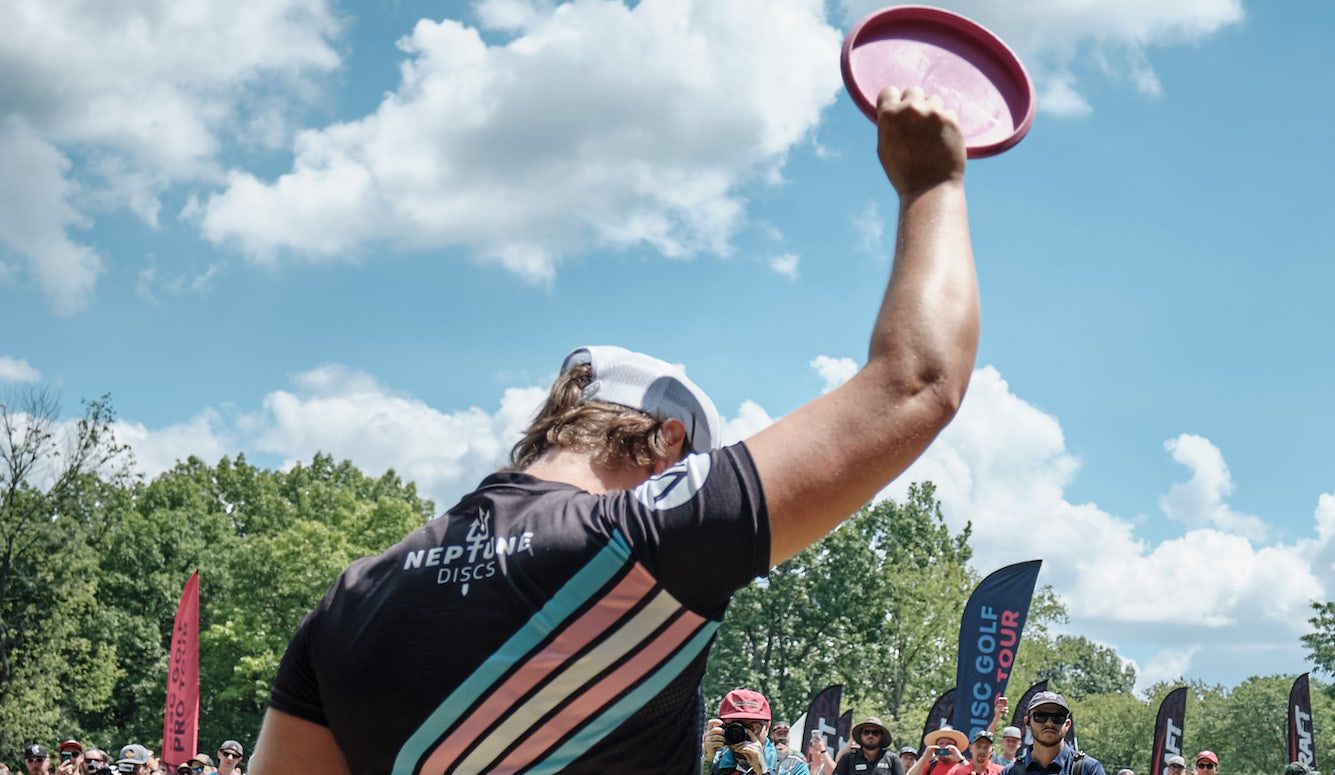
When it comes to USRowing, several of the concerned parents and activists I’ve interviewed mentioned endocrinologist Kathryn Ackerman, a former elite rower who now serves as chair of USRowing’s medical committee. These critics also have pointedly noted Dr. Ackerman’s role as medical director of the Female Athlete Program in the Division of Sports Medicine at Boston Children’s Hospital (BCH). In recent years, BCH became infamous for performing mastectomies on teens as young as 15, and for offering vaginoplasties to teens as young as 17.
Moreover, at least one of Dr. Ackerman’s co-authored academic papers—titled, Improving inclusion and well-being of trans and gender nonconforming collegiate student-athletes —can be taken to suggest that she is sympathetic to the demands of trans-identified athletes. In that paper, Dr. Ackerman and her co-authors repeatedly urged National Collegiate Athletic Association officials to challenge “myths” associated with “trans and gender nonconforming” individuals. The nature of those “myths” is never spelled out, but that word often is used as political code to suggest that male athletic advantages over women are imaginary.
And yet, as I learned during my research, Dr. Ackerman’s views on the subject of male-female sex differences are highly informed. In a recent online lecture entitled The Care of Transgender Athletes , for instance, she systematically stepped fellow doctors through the many decisive advantages that male athletes possess over their female counterparts. Yes, her lecture began with dubious slogans to the effect that biological sex is a mere “construct” that doctors “assign” based on “various anatomical and physiological traits” (as well as inflated statistics on the prevalence of differences of sexual development ). But she then quickly got into the real science:
Women…have about 30 percent lower max cardiac output. So that means they would typically have less capacity to move blood and have a decreased work capacity. They have about 25 to 50 percent lower VO2 max—so less work capacity. They have lower blood volume, so less oxygen-carrying capacity. And about 45 percent less lean body mass. So that would suggest that women are 40 to 60 percent weaker in their upper-body strength, and 25 percent weaker in their lower-body strength.
Dr. Ackerman’s presentation was highly detailed; and I won’t summarize all of it. But suffice it to say that she is, as her glittering résumé attests, a true expert in the field of sports medicine, especially as it relates to girls and women. She is also a former member of the U.S. Women’s national rowing team. If there is anyone in the entire country better situated to understand the enormous gulf that separates male and female rowing capabilities (with the possible exception of Quillette contributor and former U.S. Olympic rower Mary O’Connor ), I’m not sure who it would be.

“As [a journalist] who’s become familiar with the science in this area, I was struck by your deep knowledge, and your frank appreciation of the very real differences between men and women when it comes to sports performance,” I wrote in a March 21 email to Dr. Ackerman. “So I am at a loss to explain to readers how an organization with you at the helm of its medical committee can maintain a policy that, with few exceptions, allows men to row as women. If there’s any light you can shed on this question, either on or off the record, I’d be much obliged.”
If and when Dr. Ackerman responds, I’ll update this article to let readers know.
As female athletes and their parents find their political voice, the tide is beginning to turn on this issue—even in progressive parts of the United States, such as New York City . And spectacles such as that of “a 6’ Tall, Bearded Trans Basketballer” throwing girls around like rag-dolls will only accelerate the process.

Once the ideological movement to undermine the reality of sexual dimorphism has run its course, and it’s (once again) become settled policy across the sporting world that turning “he” into “she” should not be a magic ticket into female leagues (or locker rooms), the question will become: How did we allow this to happen?
For my own part, I’m not particularly interested in laying blame on the likes of Clark—young, confused, gender dysphoric males whose actions are being encouraged by others. What’s more interesting is why people who should know better—adult politicians, educators, administrators, scientists, and doctors such as Dr. Ackerman—have lent their names and reputations to this movement. One hopes that, at least in their private thoughts, they’ve begun to understand the disastrous effect of policies that prioritize the sanctity of male delusions over female safety.

Reflections on the Eclipse
In the modern world, it is easy to forget our connection to celestial objects and how important that connection has been throughout human history.
The UC’s Corner-Office Revolutionary
In a new memoir, a former academic administrator explains how she led the ideological campaign to enshrine DEI as a ‘core mission’ at the University of California.
The Delta Variant
John Landis’s 1978 comedy classic ‘Animal House’ is a time capsule from an era when humor and campus politics were very different.
The Prophet of October 7?
Frantz Fanon’s defenders try to distance him from the of ethos of violence he advocated, even as they embrace his anti-colonialist rhetoric to promote anti-Zionism.
Under Attila’s Gaze
In the ninth instalment of ‘The So-Called Dark Ages,’ Herbert Bushman describes a Roman diplomat’s famous fifth-century journey into the heart of Hunnic territory.
Innovation: The Forgotten Factor
Western innovation is the most effective foreign aid programme ever discovered.
From the Blog
Michal cotler-wunsh: “jew hatred never died, it just mutated”, young women need to stop oversharing online: quillette cetera episode 32, on confected radicalism: quillette cetera episode 31, razib khan answers my most controversial questions about genetics: quillette cetera episode 30.
Join the newsletter to receive the latest updates in your inbox.
On Instagram @quillette

COMMENTS
In this blog post, we will dive into real-world case studies to explore how strong communication played a pivotal role in the success of various teams with these team communication success stories. Case Study 1: The Apollo 13 Mission. In 1970, the Apollo 13 mission to the moon faced a life-threatening crisis when an oxygen tank exploded. NASA ...
Check out our team building case study round-up of 16 corporate teams we helped to improve morale, collaboration, and relationships. Phone 1-800-565-8735. Request a Quote. Virtual Team Building; ... communication styles, and the value of vulnerability in a leader. To learn more about how this event was able to come together so quickly, ...
Humanities and Social Sciences Communications - Interpersonal relationships drive successful team science: an exemplary case-based study. ... interpersonal communication skills, data sharing ...
Outcome: The Seymour House teams instantly connected with the Community app. Engagement levels took an immediate uplift as the communication and understanding between teams and individuals improved. This internal communications case study shows how crucial it is to connect with employees in a way that suits their style of interaction. Verdict ...
A case study is used to investigate two teams of final year multimedia students completing a project-based unit, in which teamwork was an ... • engage in open dialogue and communication (Kets De Vries, 1999) • cultivate a team spirit of constructive criticism and authentic non-evaluative feedback (Harris & Harris, 1996)
Led by Sandy Pentland, researchers at MIT's Human Dynamics Laboratory set out to solve that puzzle. Hoping to decode the "It factor" that made groups click, they equipped teams from a broad ...
According to the study, "effective internal communications can keep employees engaged in the business and help companies retain key talent, provide consistent value to customers, and deliver superior financial performance to shareholders" to the tune of a "47% higher return to shareholders over a five-year period (mid-2004 to mid-2009).".
New research on communication from Harvard Business School faculty on issues including intentiona nd meaning, communication technology, and communication strategies. ... who tackles tricky scenarios in a series of case studies and offers his advice from the field. ... A study of 360 billion emails shows how remote work isolated teams, but also ...
This paper focuses on the critical role of work teams, arguing that managers must leverage the knowledge generated by teams to support innovation and strategic change. It matches types of team learning to innovation activities. 28 Feb 2018. Sharpening Your Skills.
Summary. Transformational leaders are exceptional communicators. In this piece, the author outlines four communication strategies to help motivate and inspire your team: 1) Use short words to talk ...
Abstract. This 3-year research project assessed the effectiveness of a teambuilding intervention among a group of department leaders who supervised a fire management unit working in the forests of the western United States. The intervention began with a 3-day retreat that covered three basic areas: communication skills, consensus building, and ...
Case Study #1 Erika Pribanic-Smith, Department of Communication Project Description . My goal was to determine if interventions to improve team cohesion through interpersonal communication would result in better team performance as measured by presentation cohesiveness on the final project.
How Will You Make Your Team a Team? Leading teams Digital Article. Harvard Management Update; by Paul Michelman. ... Communication Case Study. June A. West; Jenny Craddock; 8.95. View Details.
Zero risk. 1. Mettler Toledo Saves Days on their Internal Communications with ContactMonkey. When Kate Kraley began as Mettler Toledo's Marketing Communications Specialist, she wanted to use internal communications to increase engagement and improve communication with employees.
Let's break down what team communication actually means. According to Merriam-Webster, communication is "a process by which information is exchanged between individuals through a common system of symbols, signs, or behavior." In other words, it's an exchange of information. Download our white paper on creating an effective internal communication strategy for more in-depth insights.
The science of teamwork has been extensively studied, 1 and with good reason. Successful teams improve business outcomes, including revenue and performance. 2 Many organizations are intentionally fostering a collaborative team-based culture, 2 and feeling like a part of a team is a primary driver of employee engagement. 3 Prior to the pandemic, organizational shifts had resulted in teams that ...
A case study is used to investigate two teams of final year multimedia students completing a project-based unit, in which teamwork was an essential ingredient and immersed in an authentic context.
Here are seven inspirational stories emphasizing the importance of teamwork - in the workplace or personal life. 1. After years of intensive analysis, Google discovers the key to good teamwork. In the last decade, Google has spent millions of dollars on measuring nearly every aspect of its employees' lives - from which traits the best ...
Ask students to form new teams with at least one person from each profession present on each team. Teams should designate one person to take notes and report on team findings. After the students have formed teams, direct them to read the case study for Mr. Jones silently, then answer the questions as a team. Option 2.
In a case study examining a failed interdisciplinary team approach, several lessons can be learned to improve future efforts. One of the key lessons learned from this failed approach is the importance of clear communication and collaboration among team members.
Getting the Group to Work as a Team: A Mini Case Study. Categories: engaging teams, Leadership, project leadership, team development. Martha has been assigned a team of 10 people to help her plan a major customer appreciation event. They have been working together for over a month now and they just haven't really come together as a team.
Welcome to the MIC Case Studies page. Here you will find more than fifty different case studies, developed by our former participants from the Master of Advanced Studies in Intercultural Communication. The richness of this material is that it contains real-life experiences in intercultural communication problems in various settings, such as war, family, negotiations, inter-religious conflicts ...
In fact, a recent estimate claims that the cost in the U.S. alone are close to $4 billion annually! [1] Poorly-worded or inefficient emails, careless reading or listening to instructions, documents that go unread due to poor design, hastily presenting inaccurate information, sloppy proofreading — all of these examples result in inevitable costs.
Case Briefing #1: Strategic Design at Dynacorp MBAMGT 650, Fall 2023 1. Question 1: a. My first choice would be Front/Back strategic design. i. The current design lacks communication between teams, especially between the Manufacturing and Engineering teams when collaboration is a key aspect in bringing out good products and customer satisfaction.
The protection of privilege in communications between clients and lawyers is a very important one under U.S. law. The basic rule is that when a client seeks legal advice from a lawyer, the ...
Study setting. This research was exploratory rather than explanatory in nature. The emphasis was on demonstrating the usefulness of the WeValue InSitu (WVIS) approach to develop culturally-informed protocols of practical use in intervention design, in different cultural sites.This study was set within a broader shared-values workstream within the UKRI GCRF Action Against Stunting Hub project [].
Twitter-posted image of Lazuli Clark (#23, right) competing on KIPP Academy Lynn's girls' high-school volleyball team. "A 6' Tall, Bearded Trans Basketballer Arrogantly Slams a Young Girl to the Ground—She Collapses in Agony," was how Britain's Daily Mail headlined the latest transgender sports scandal. Some may roll their eyes at the Mail's sensationalist (and uniquely verbose ...
New tackle height rules were introduced to domestic and community rugby by the Rugby Football Union last year. World Rugby has revealed the largest-ever tackle study is currently being conducted ...